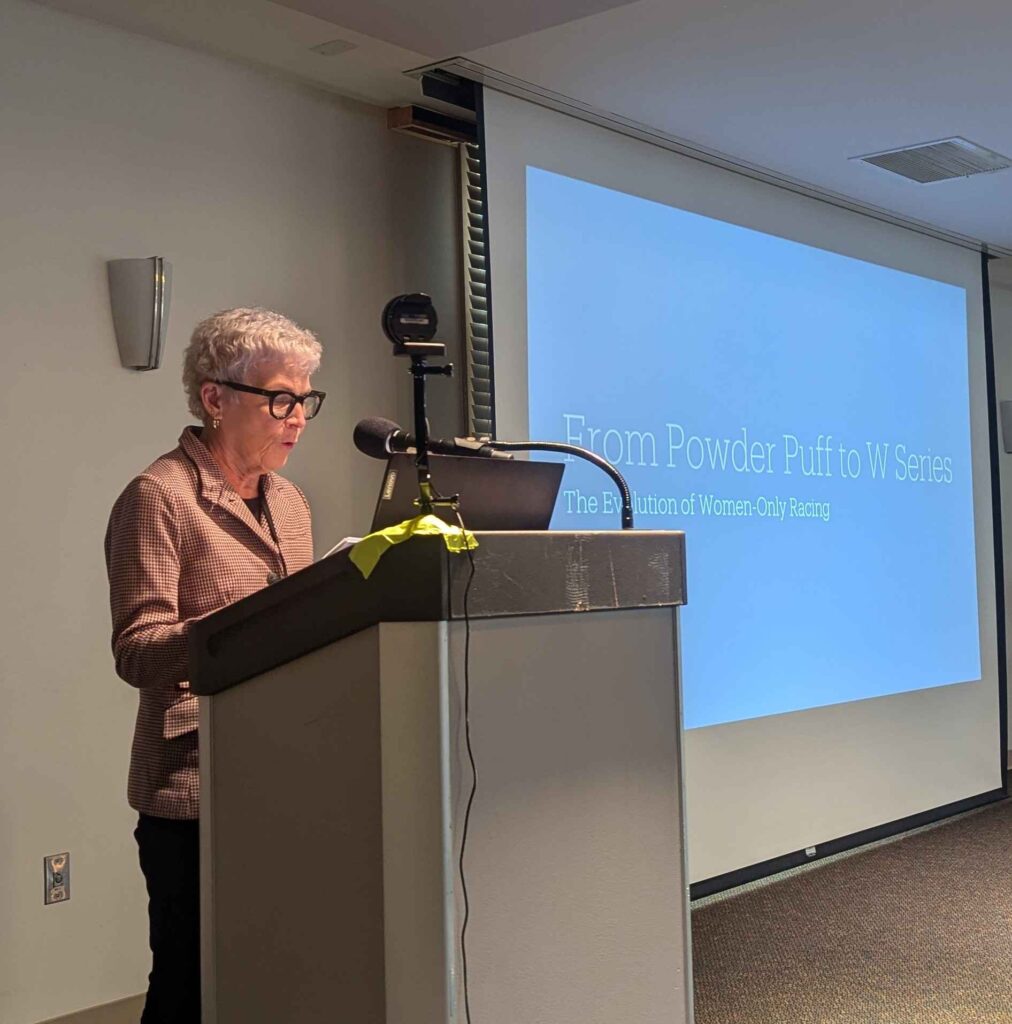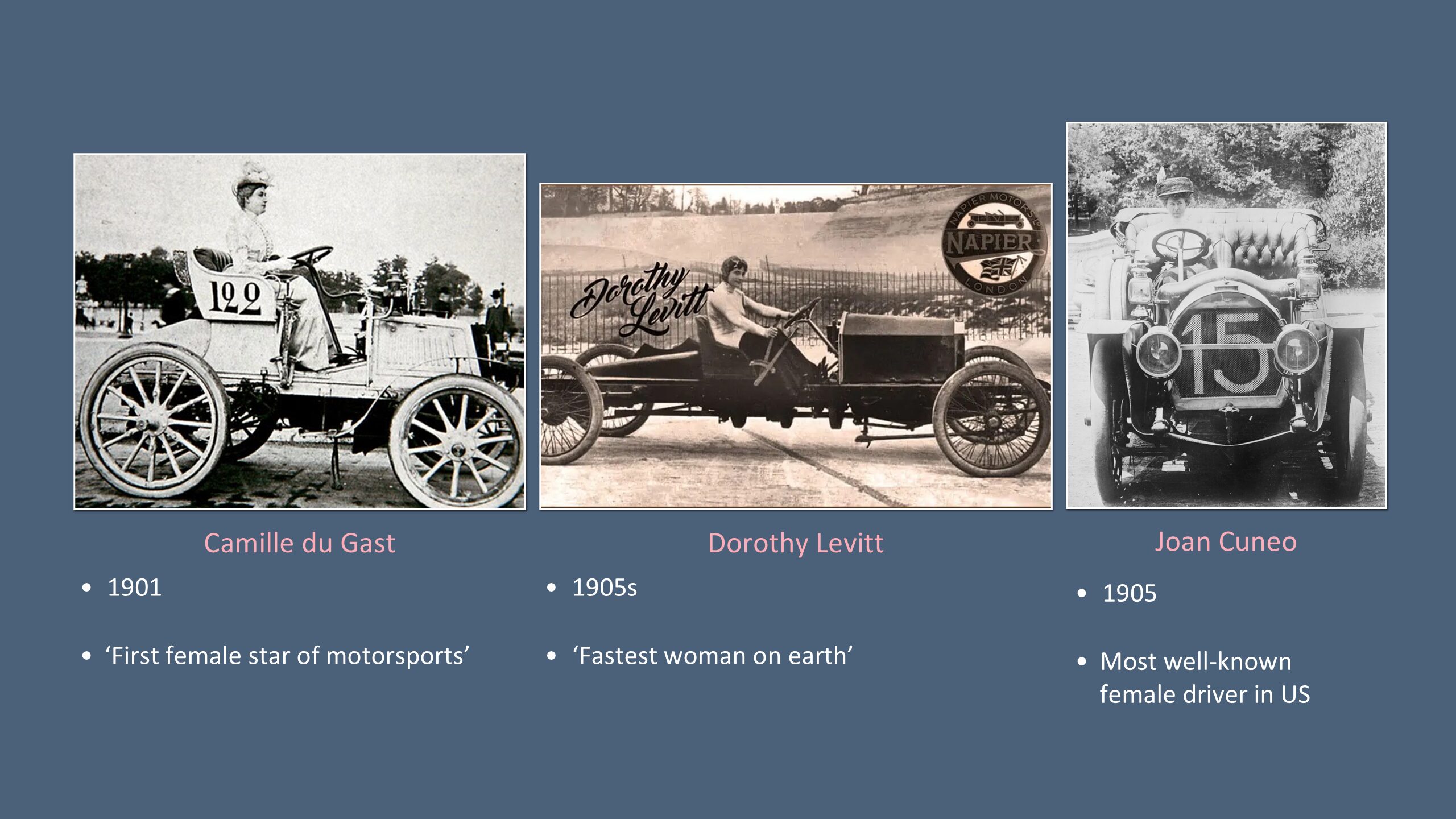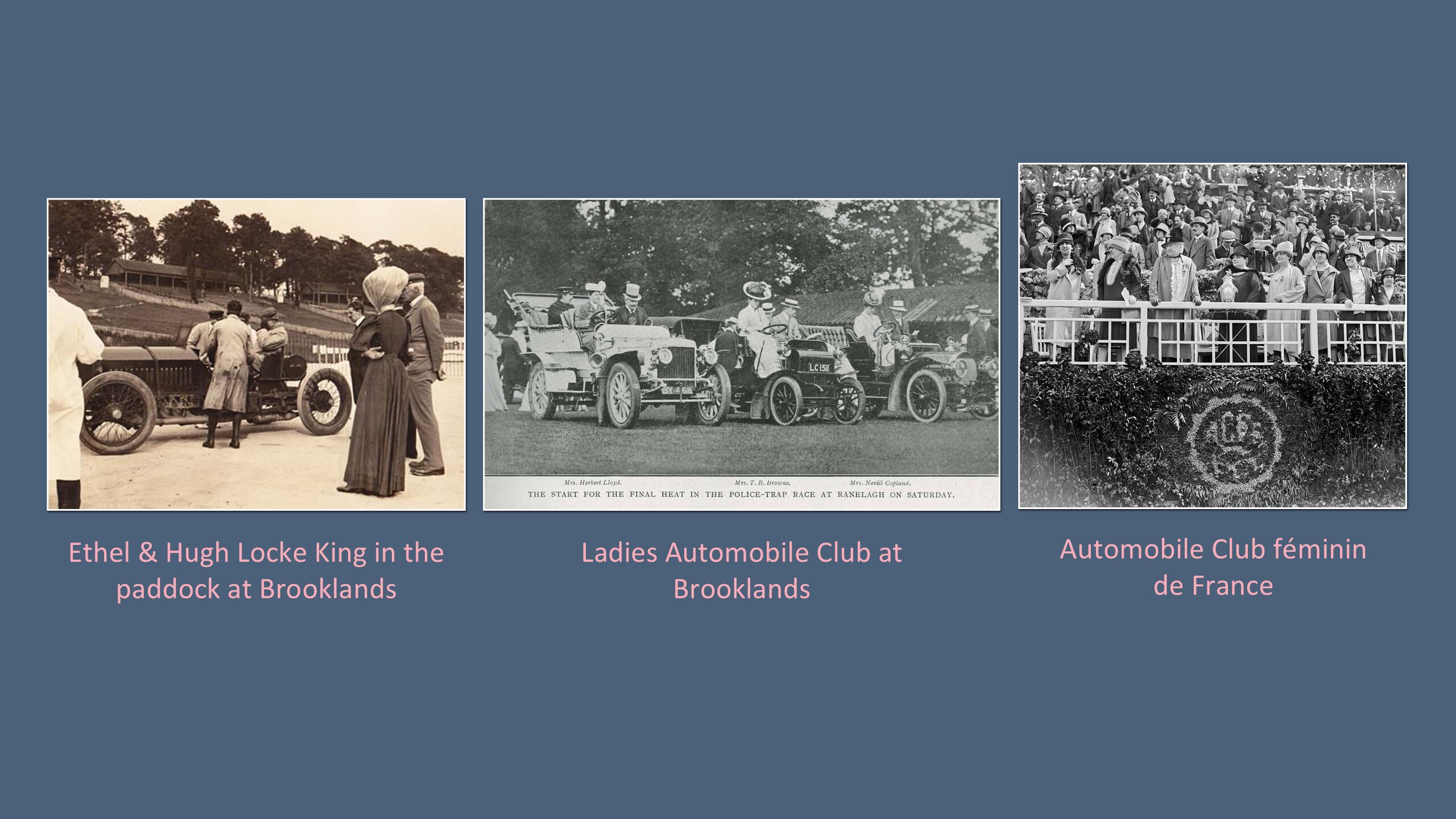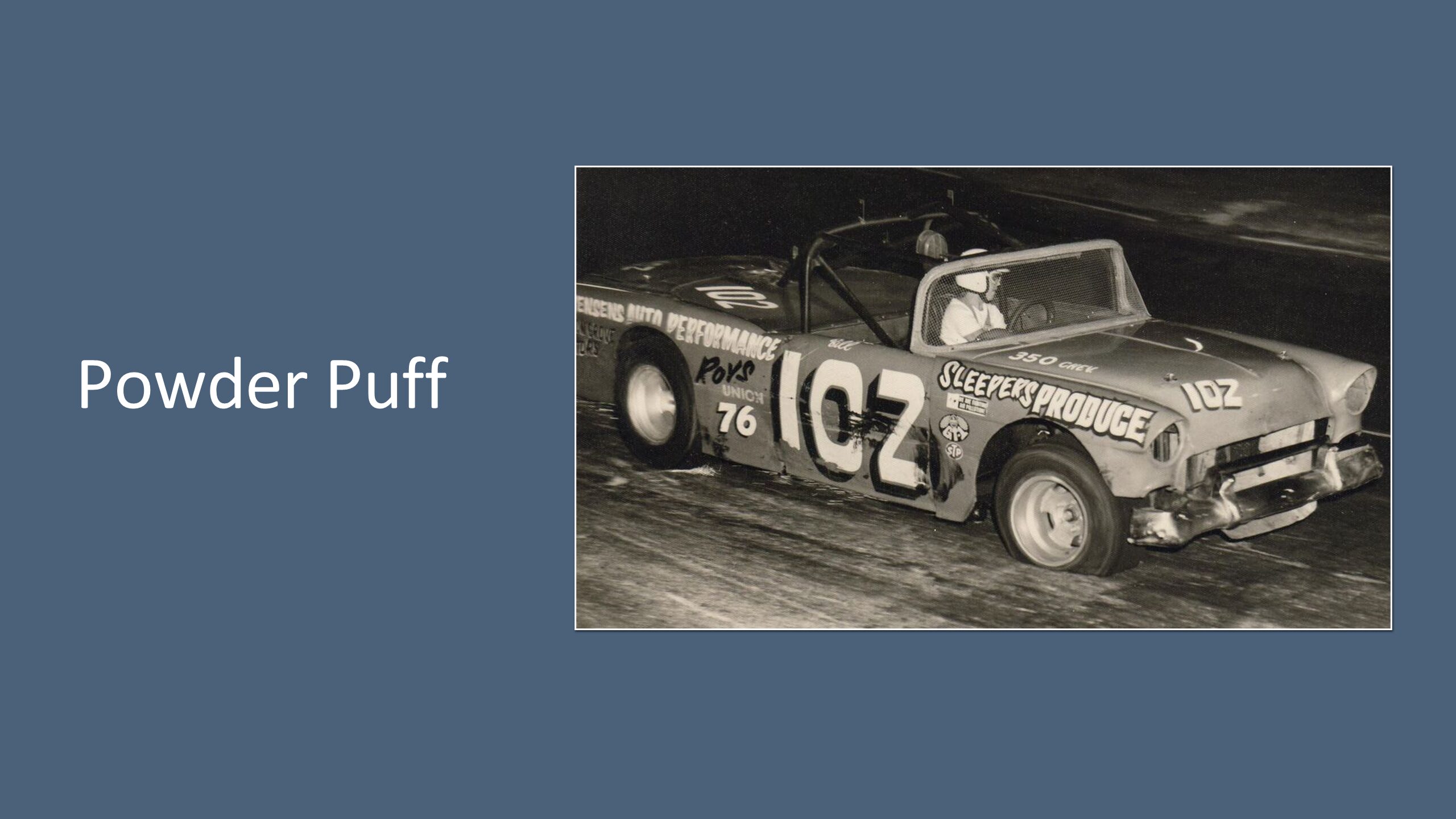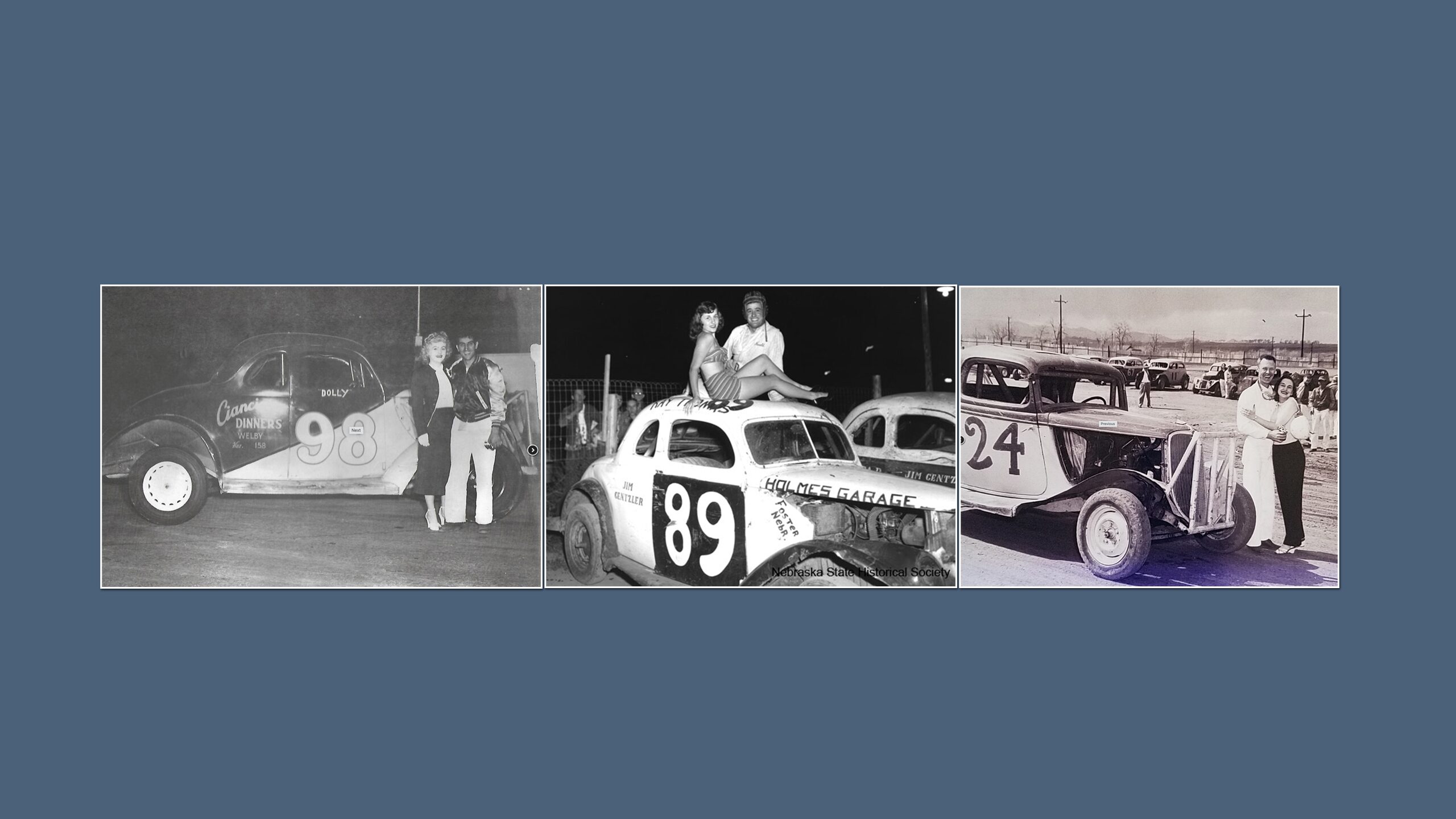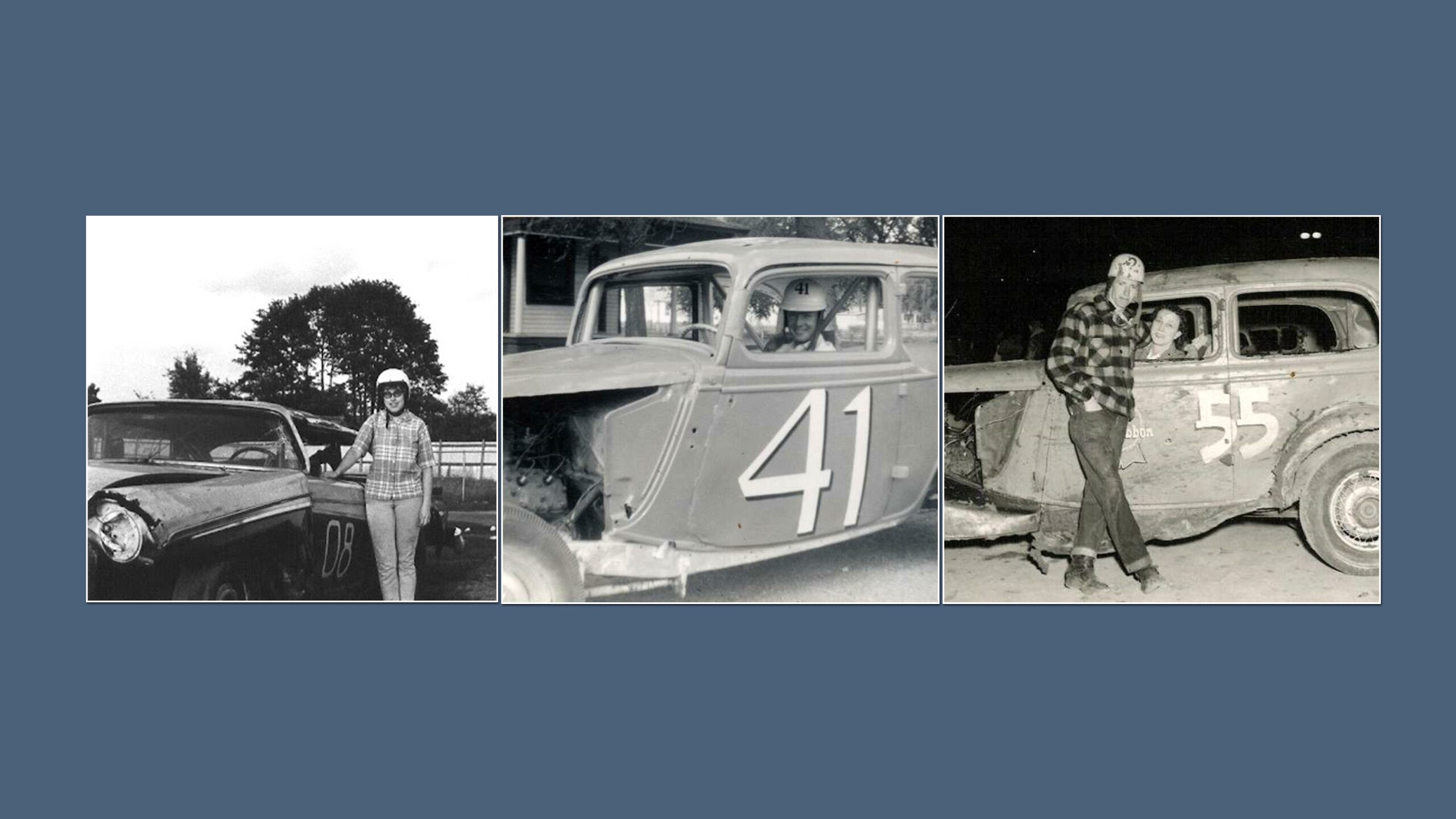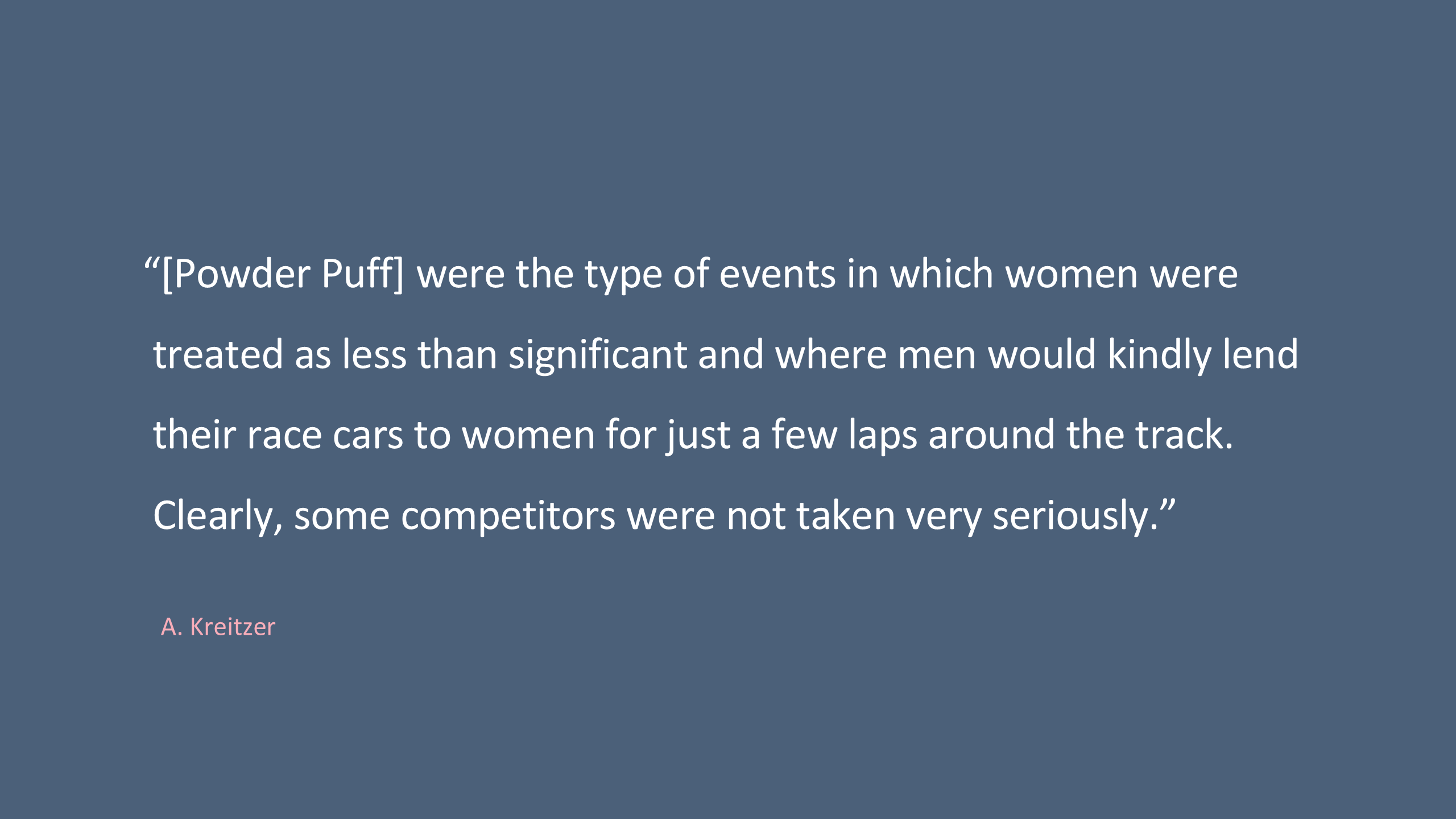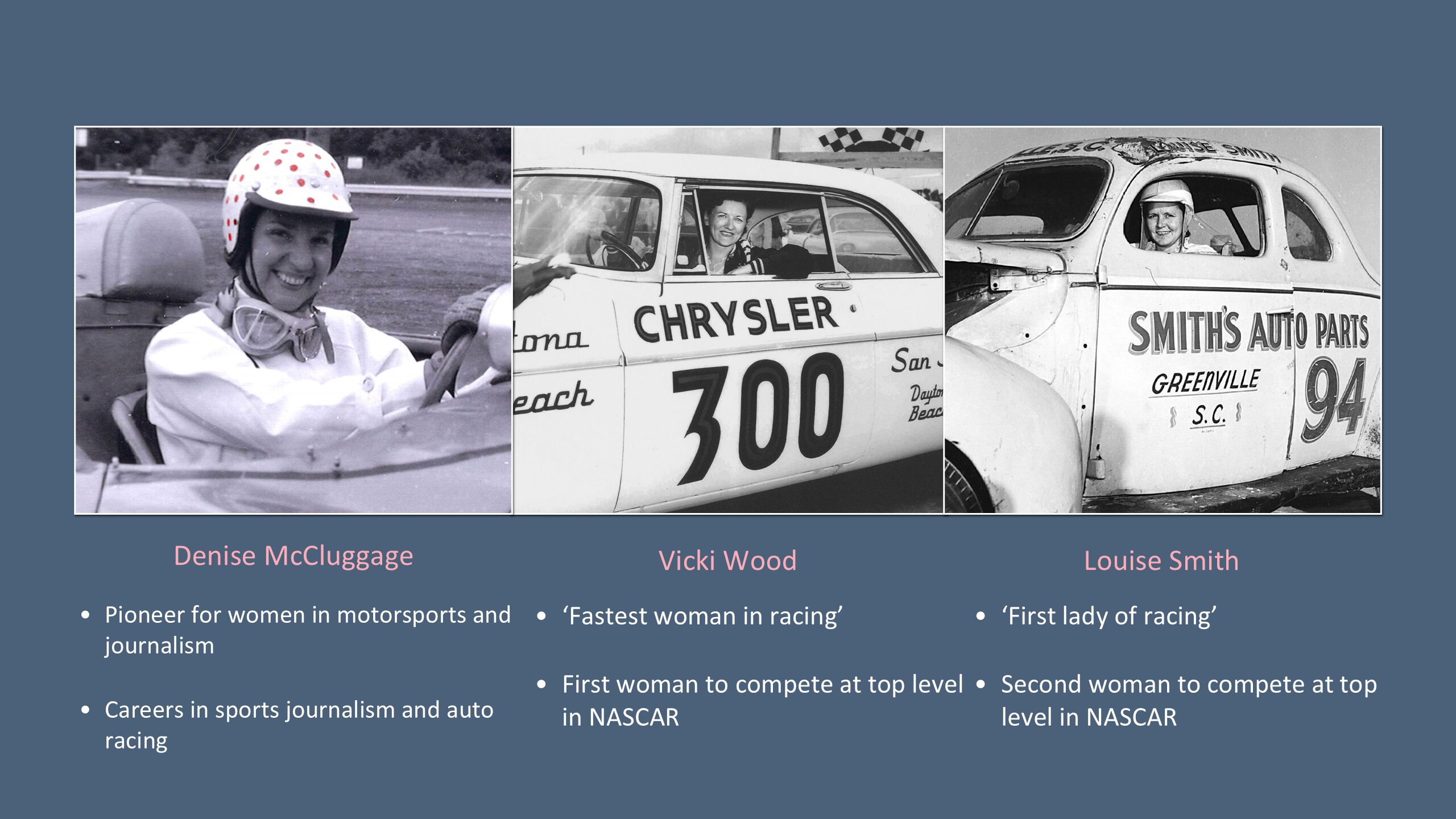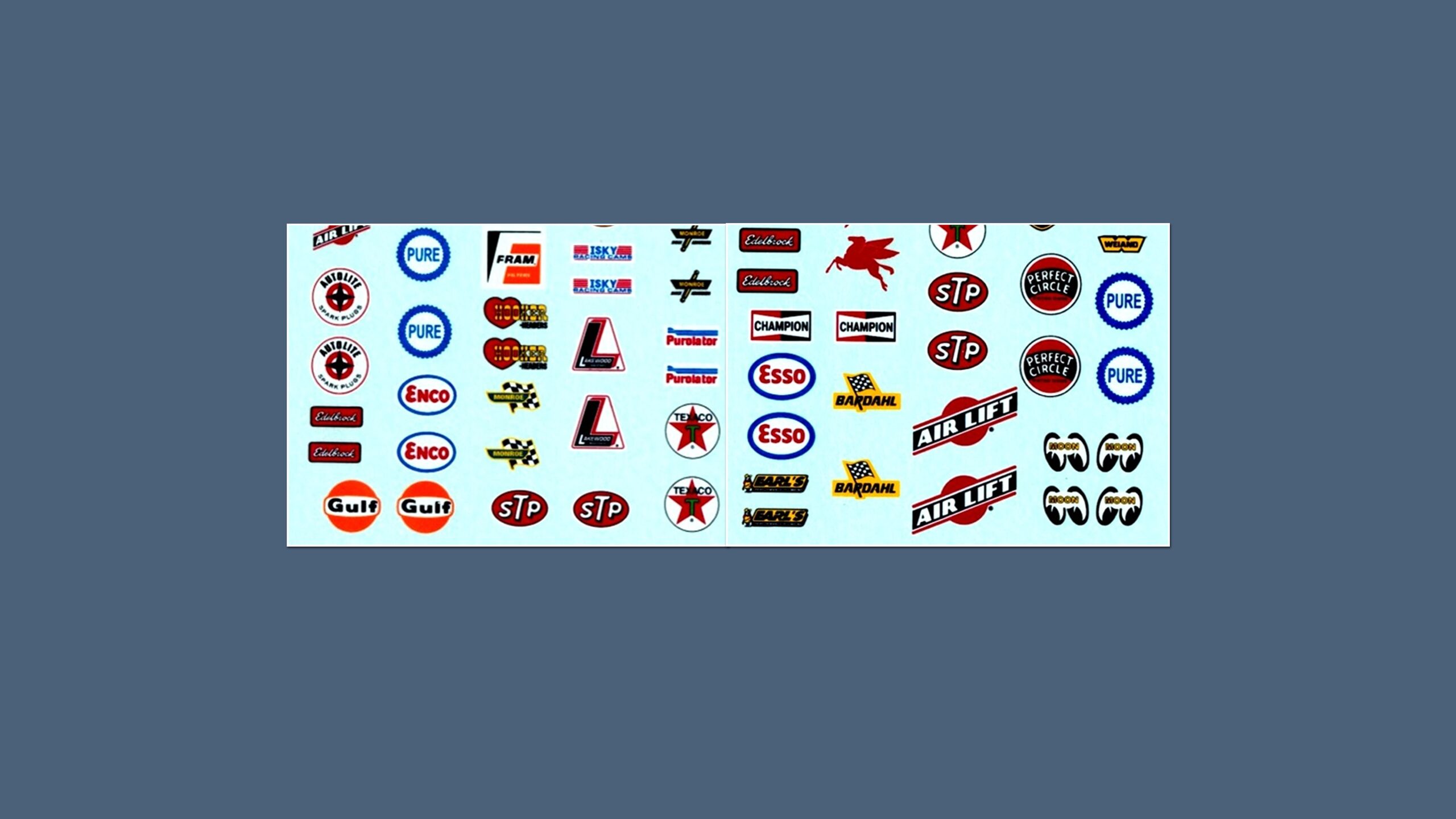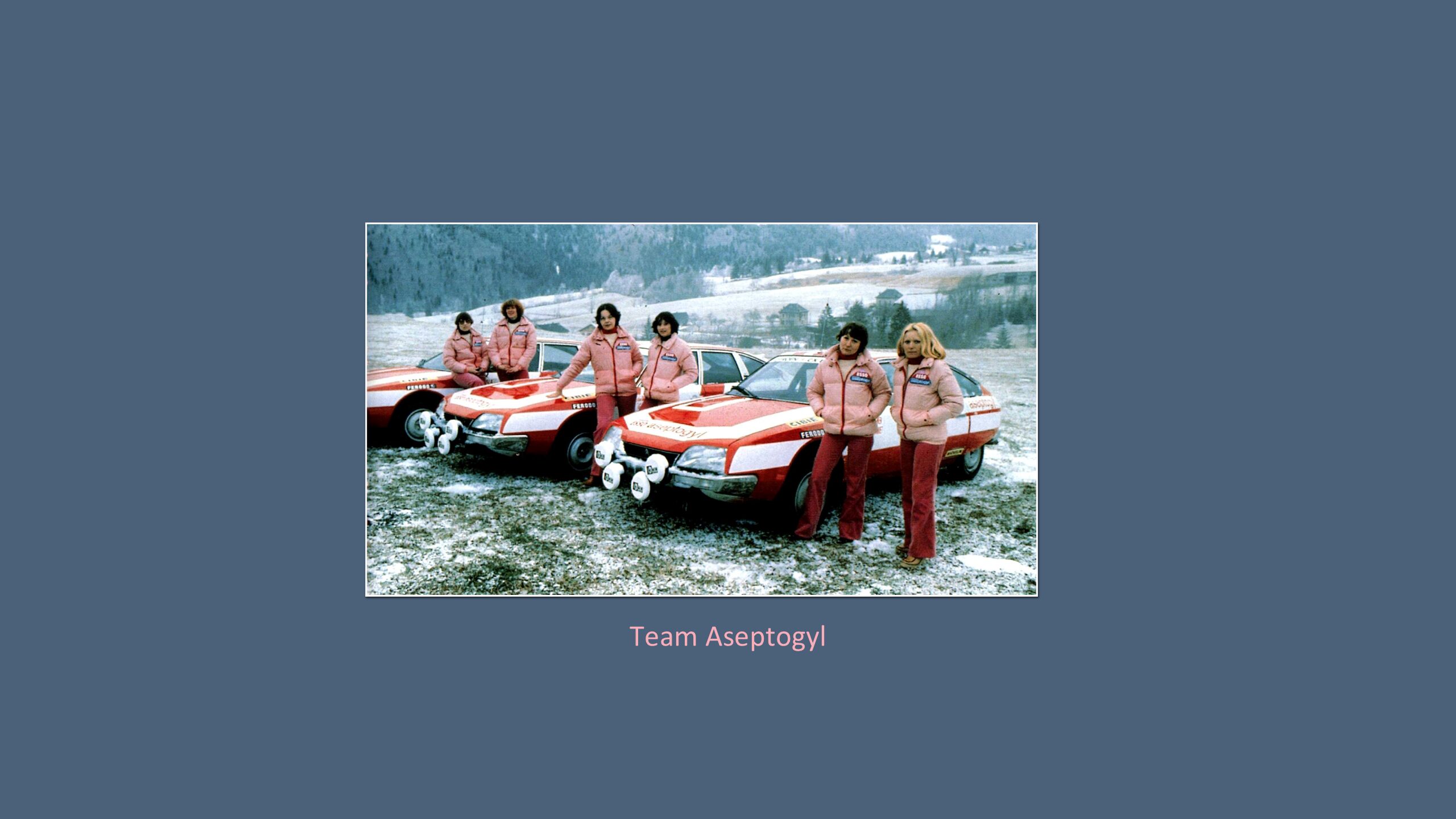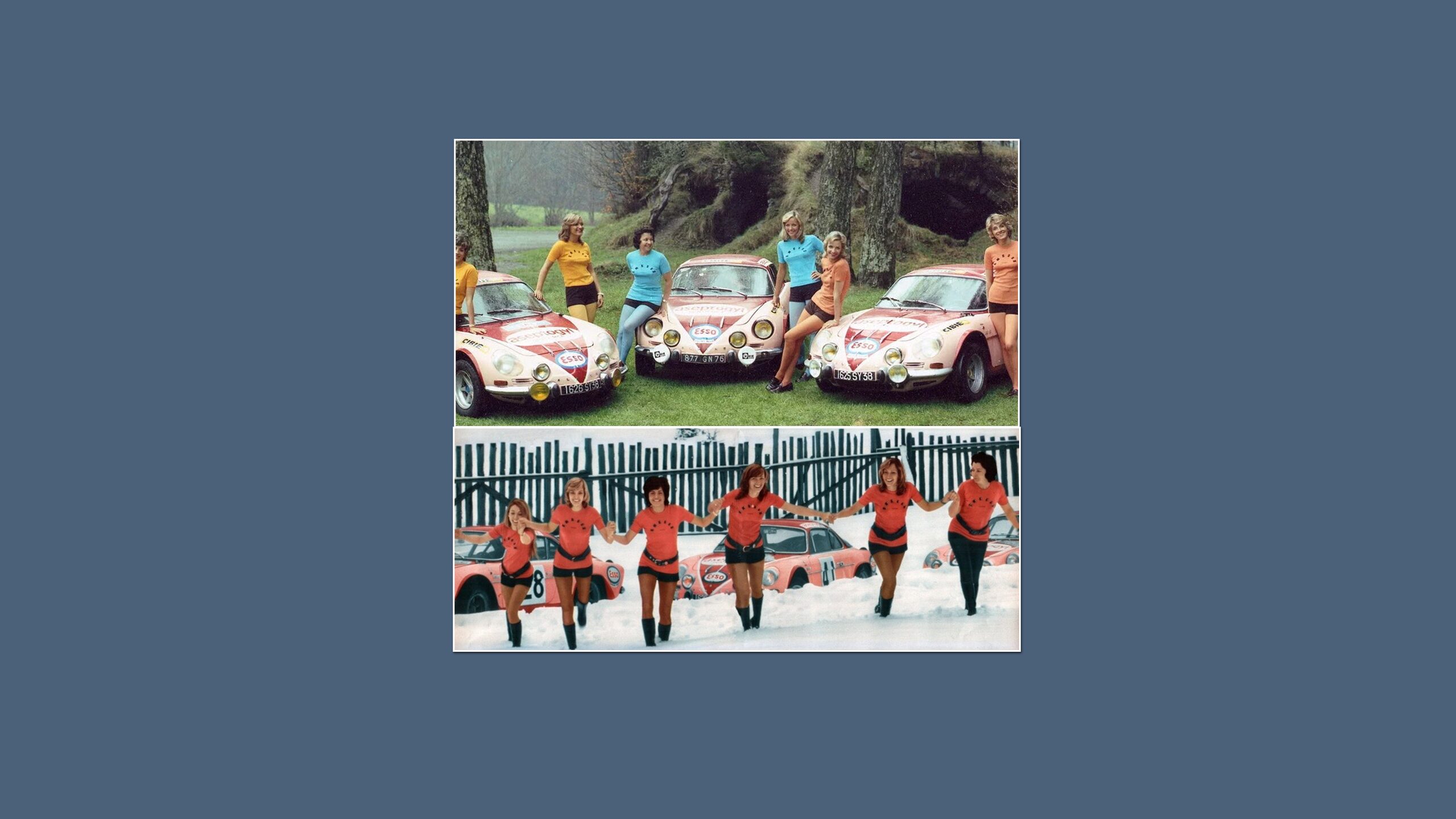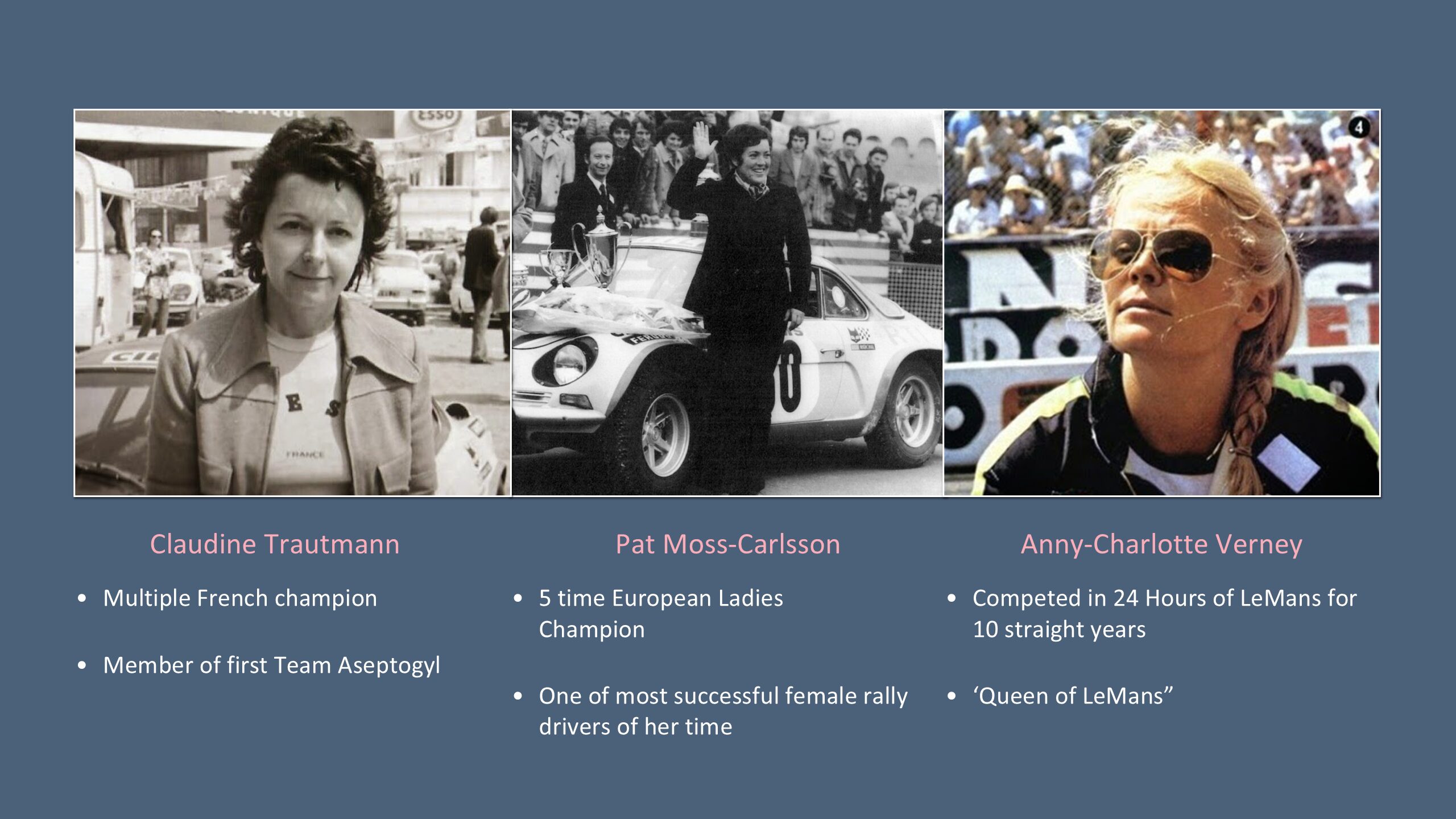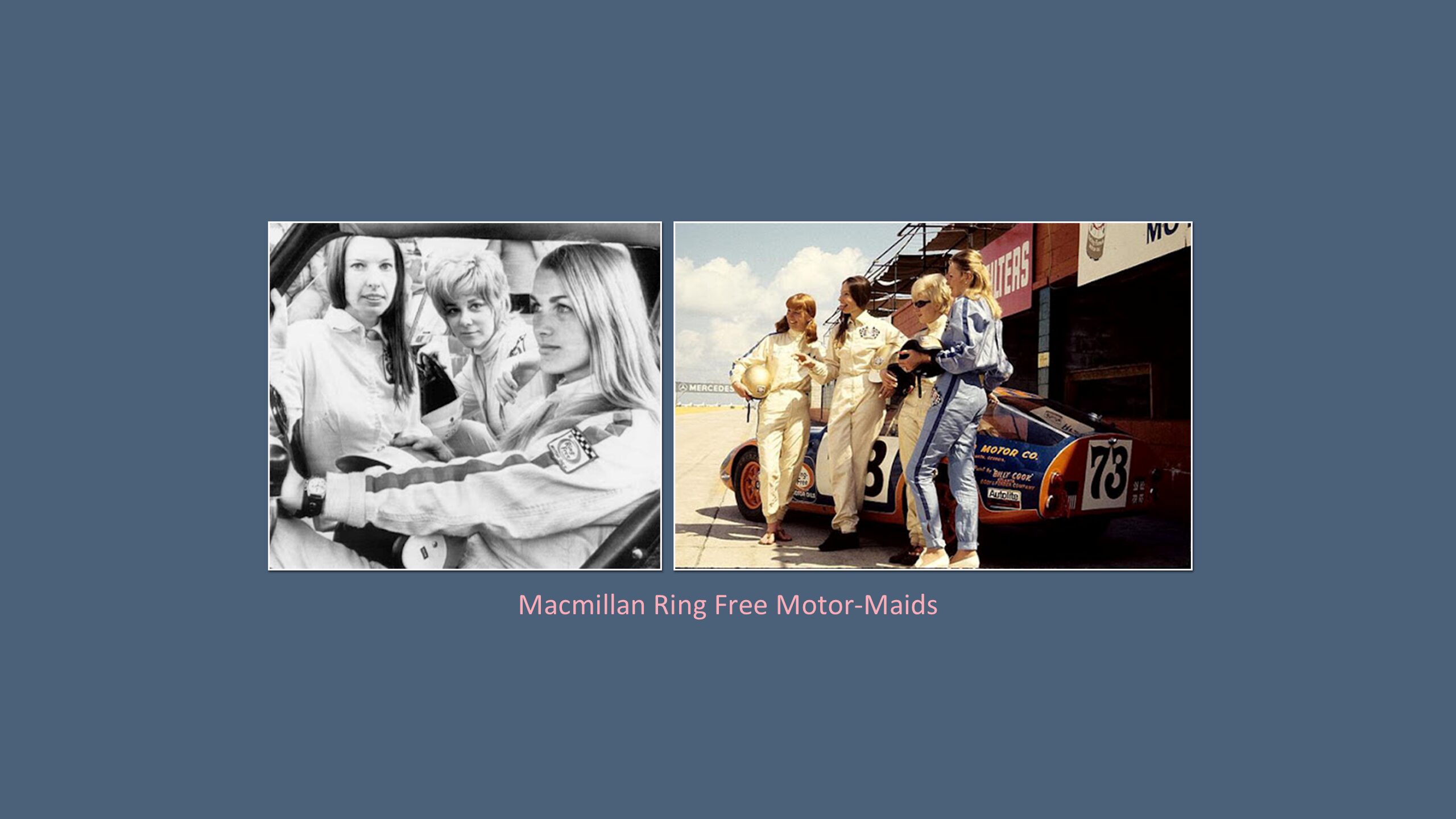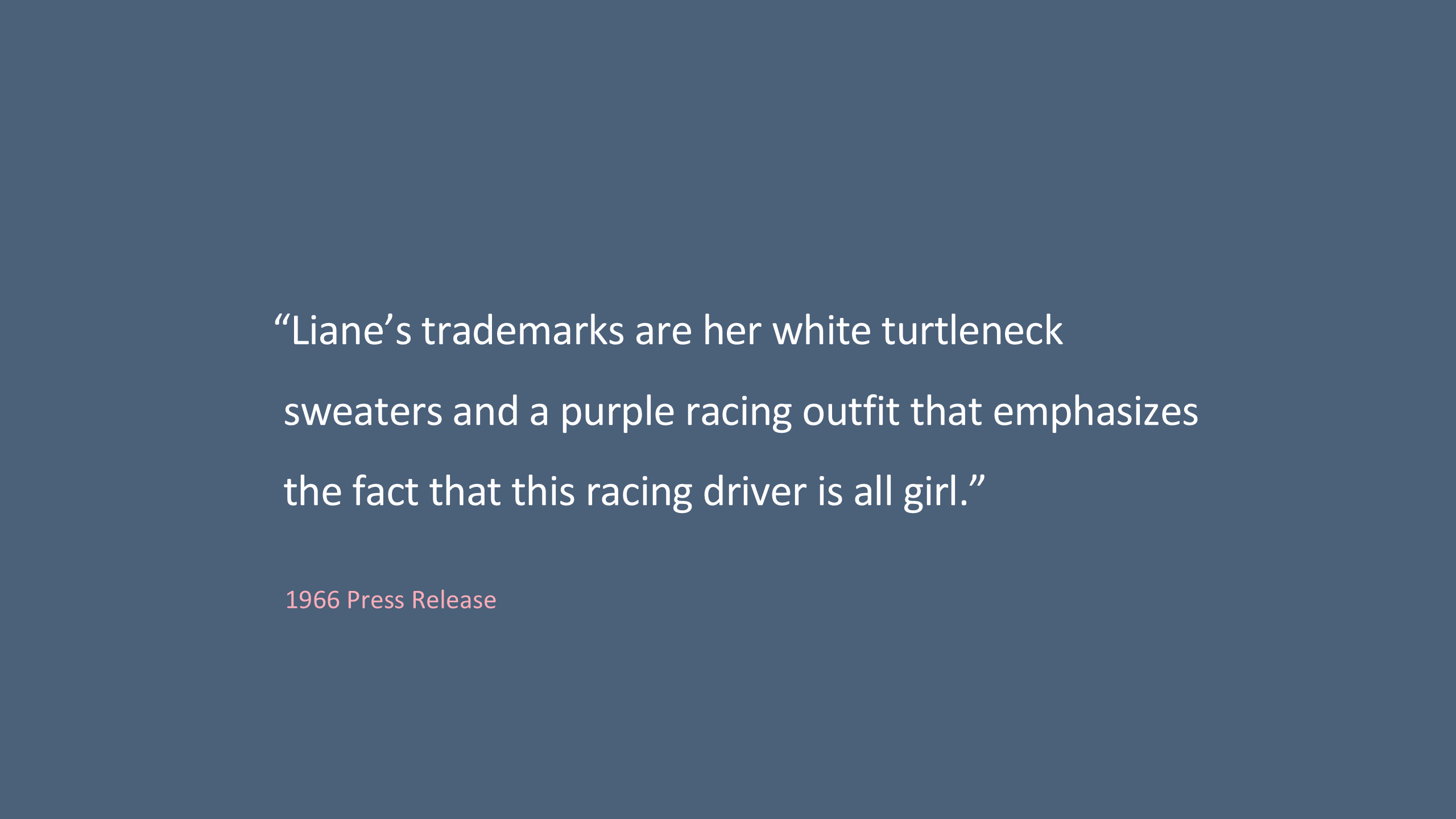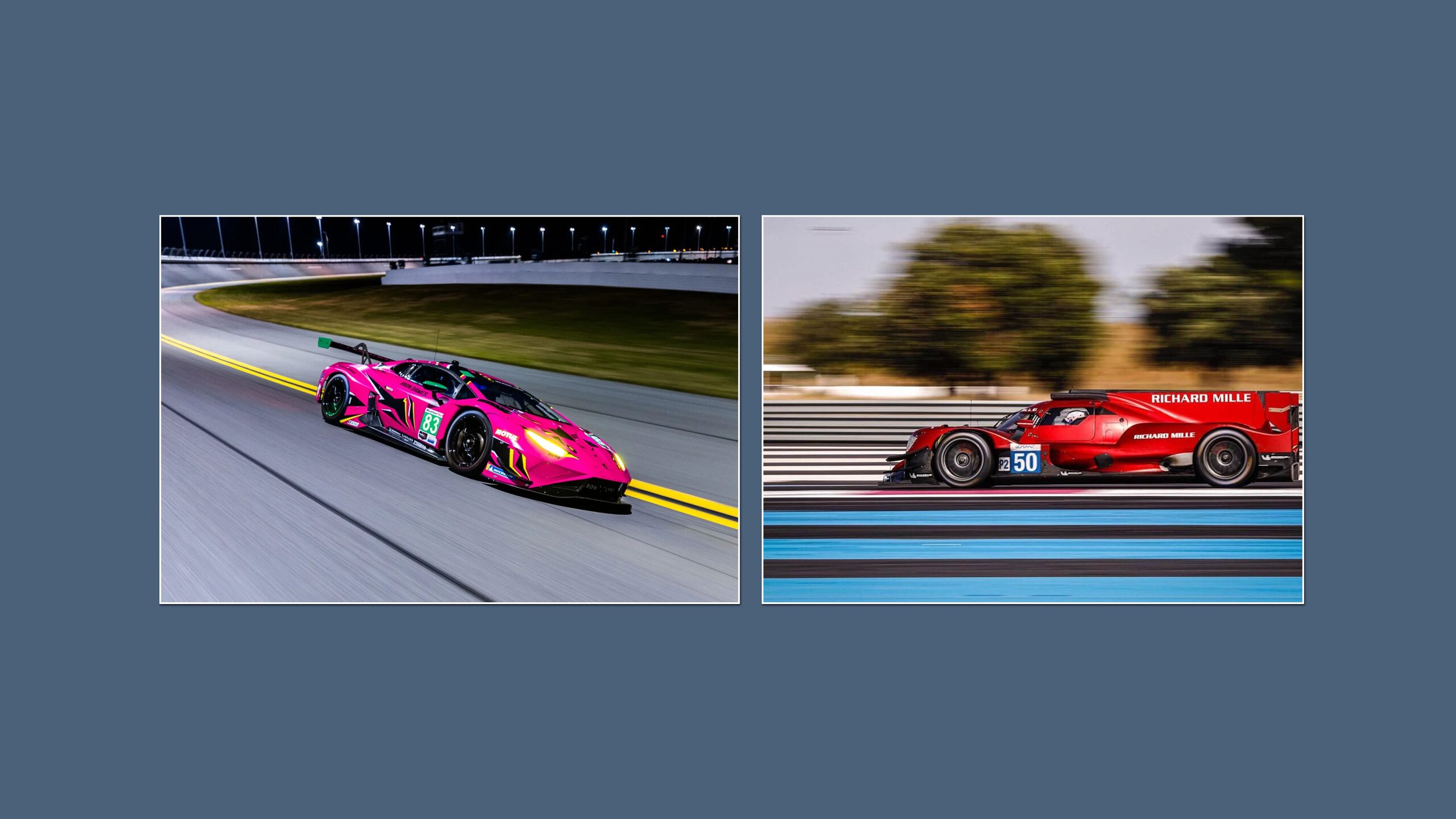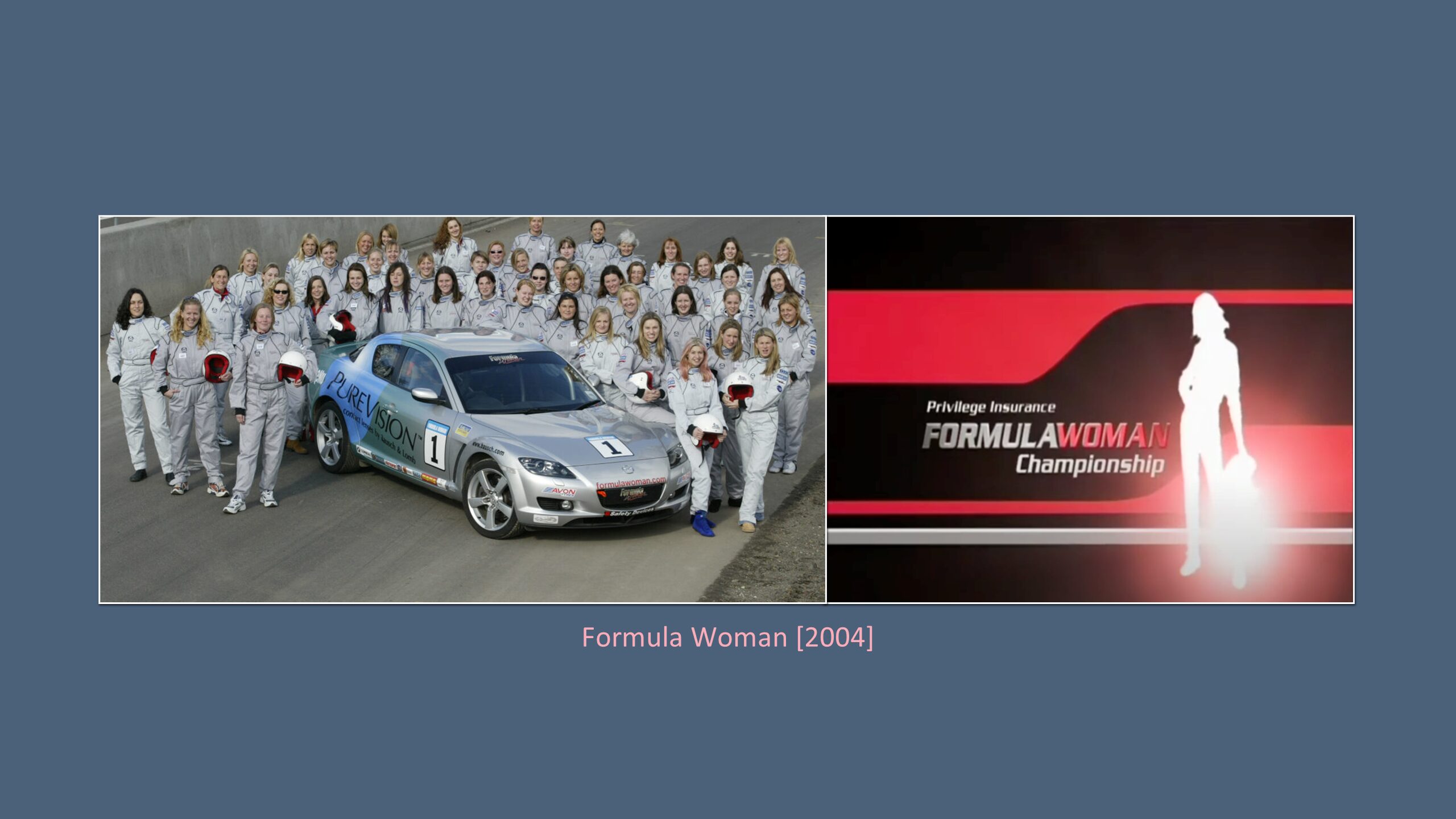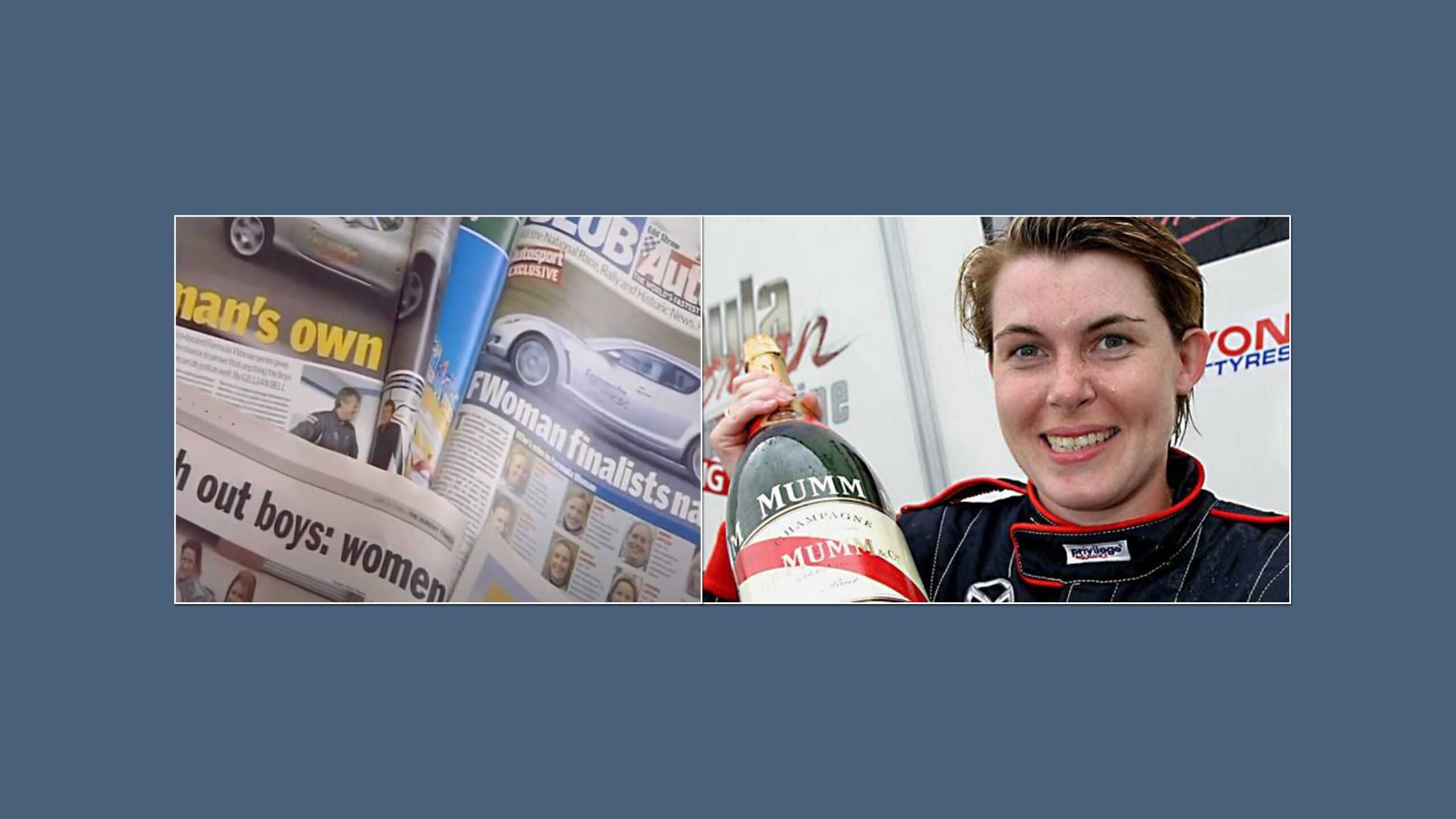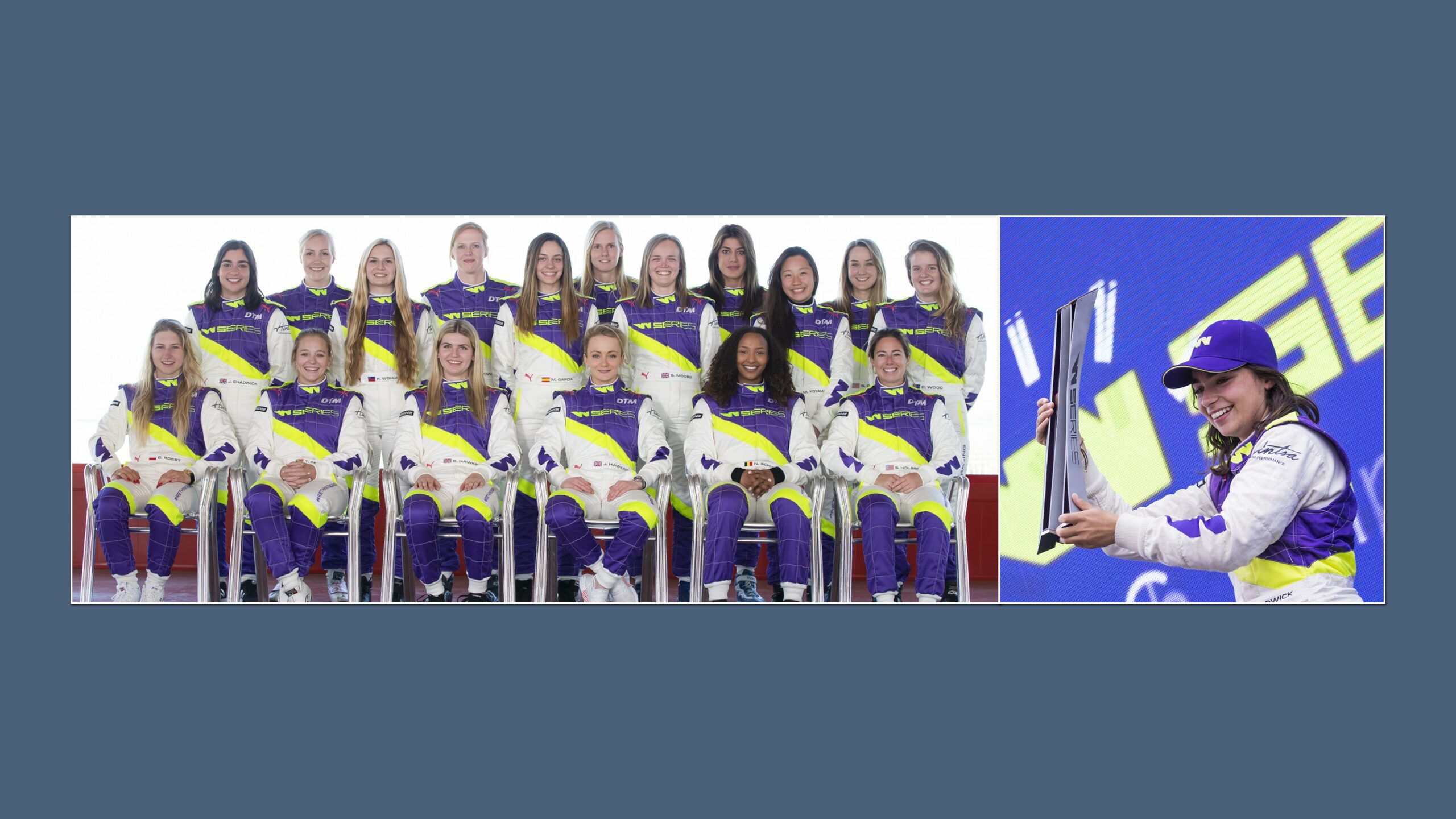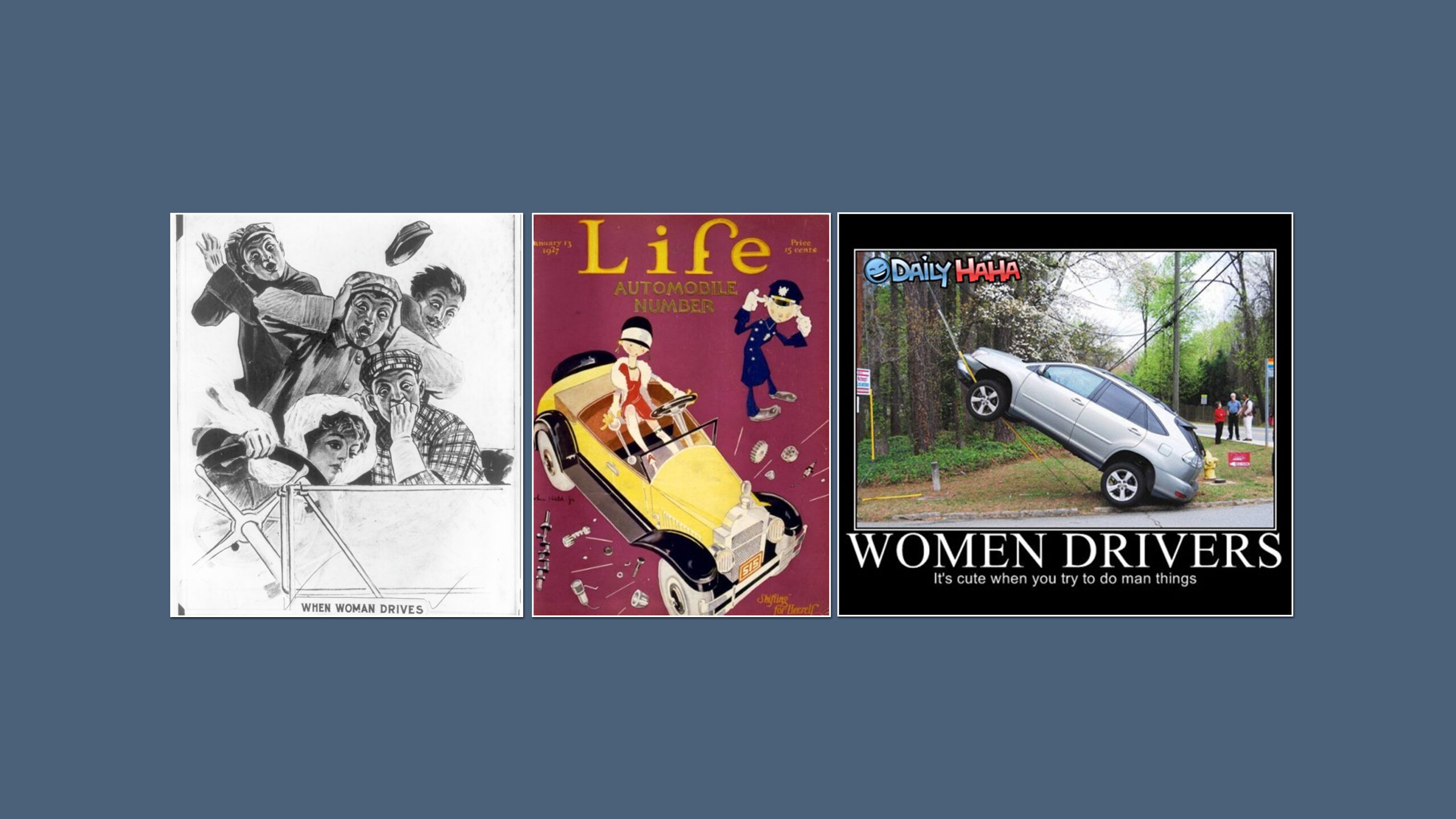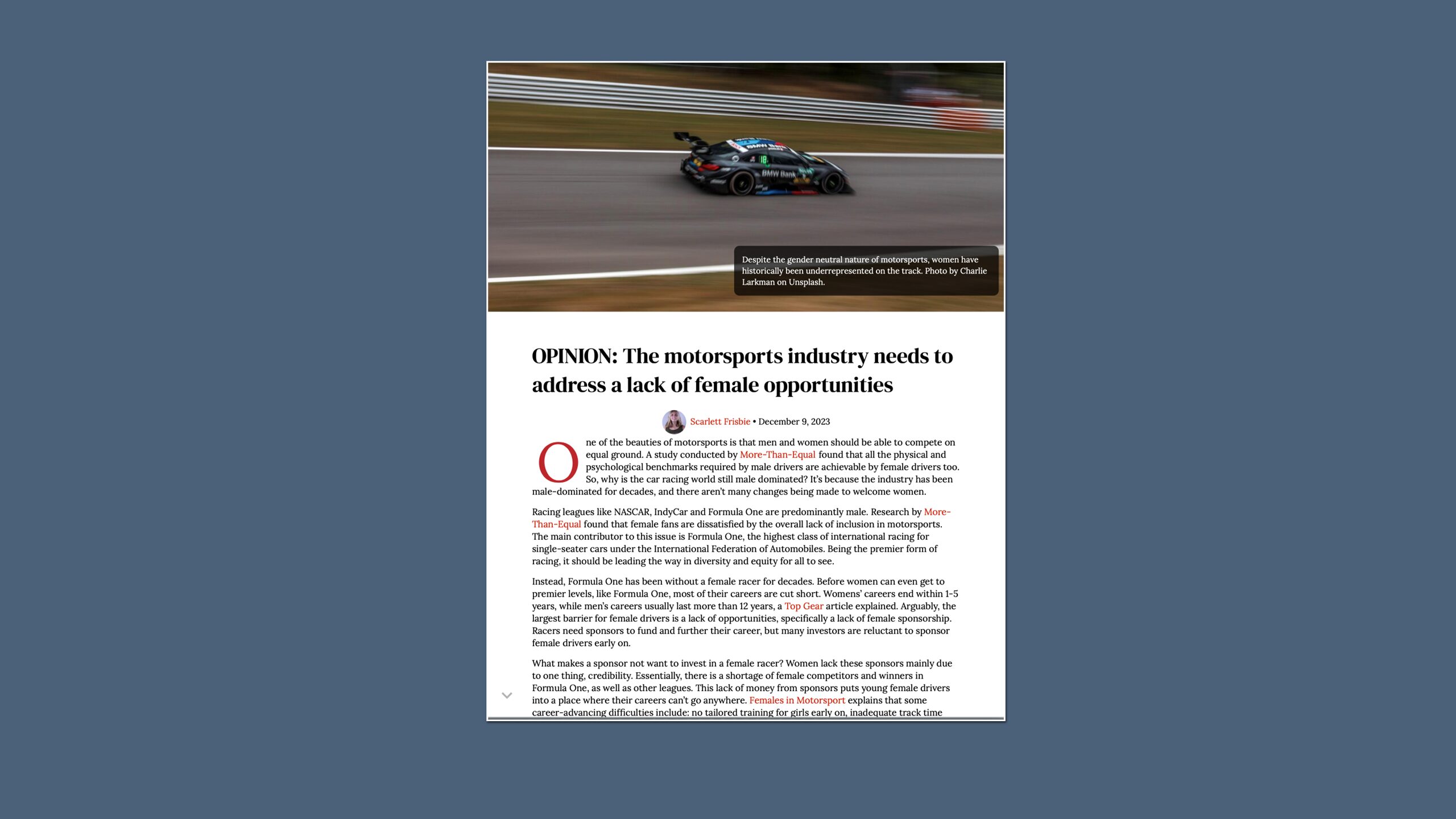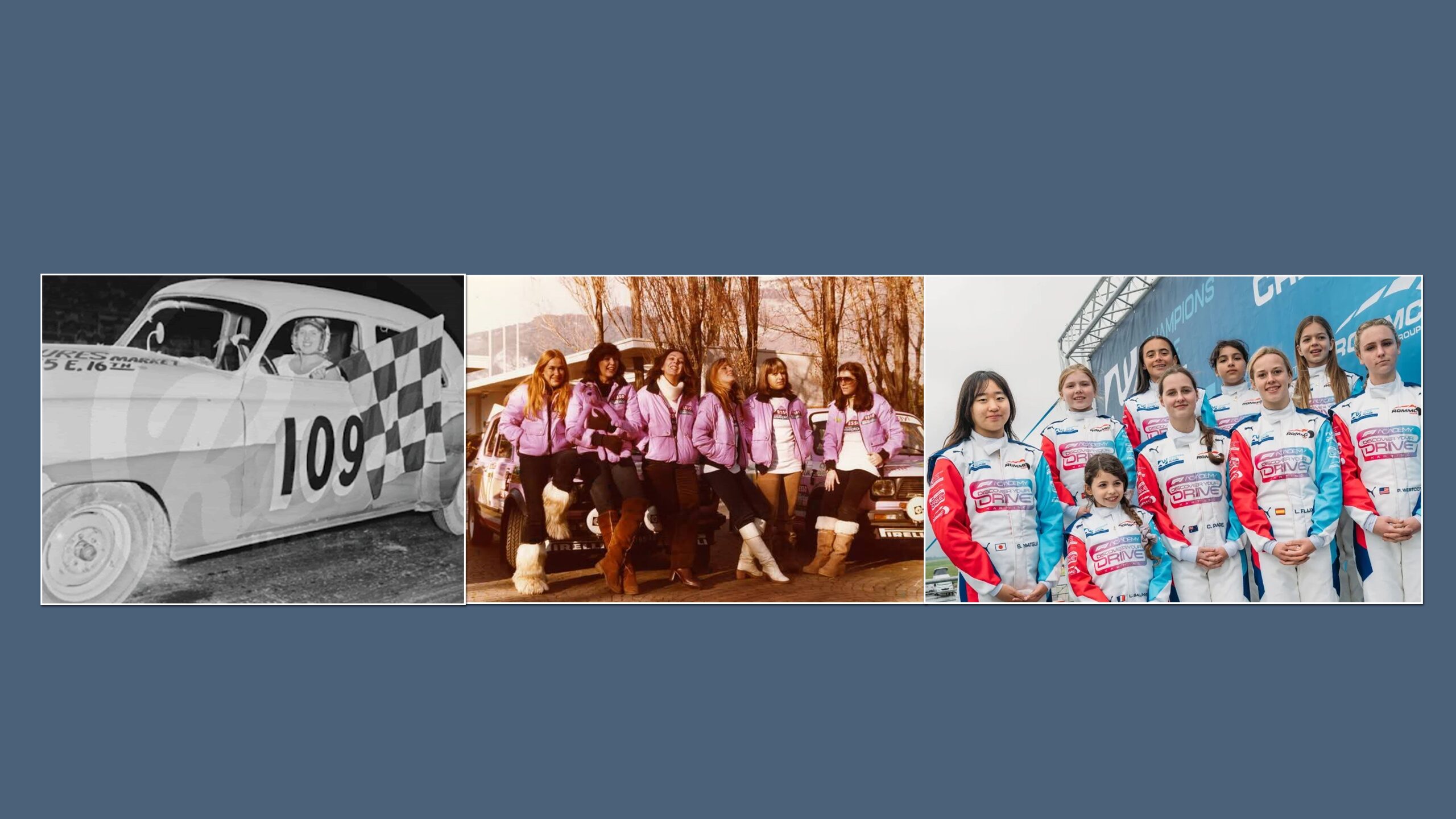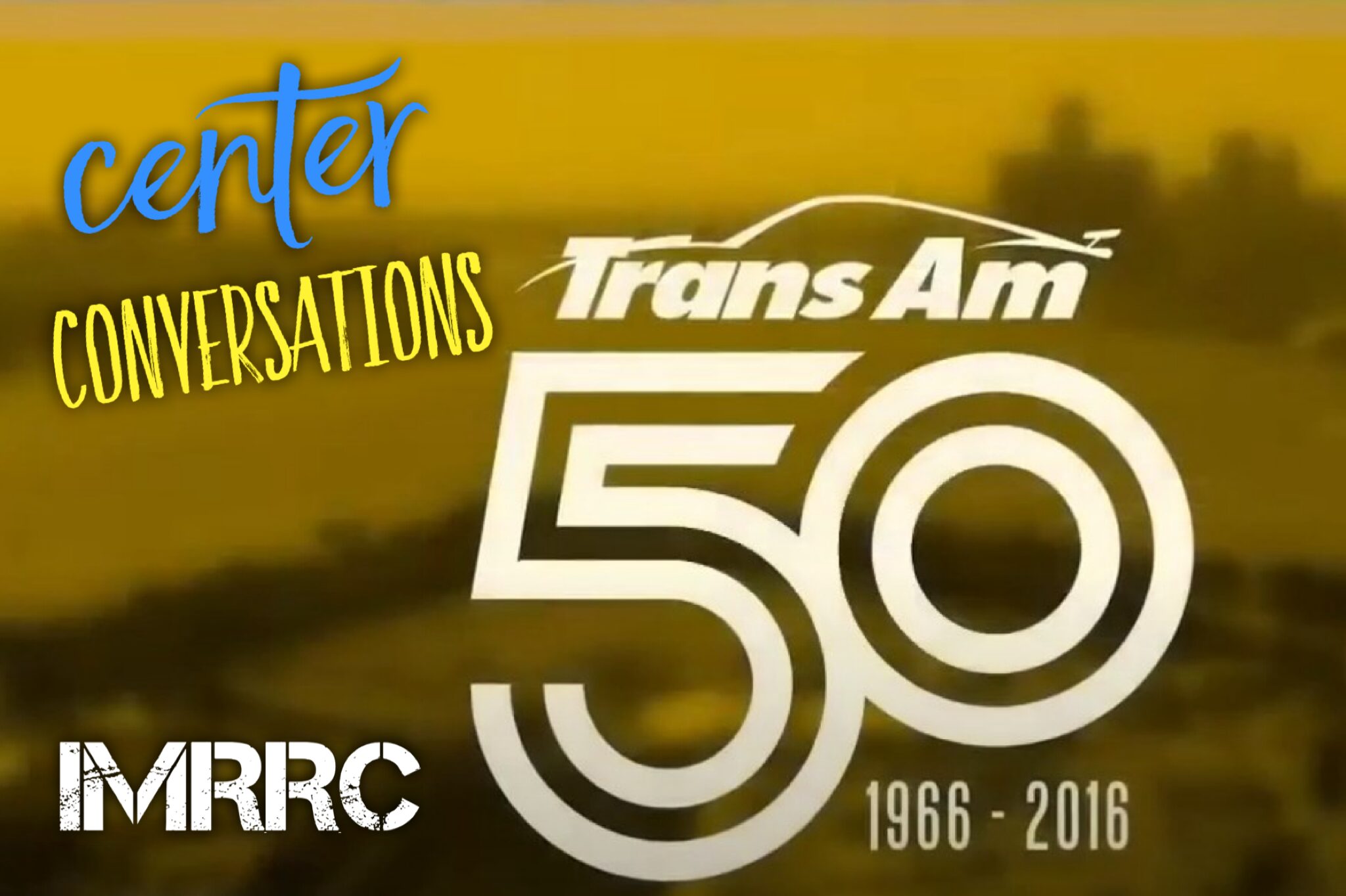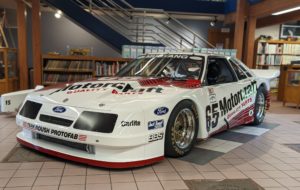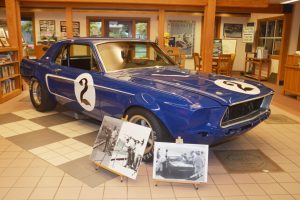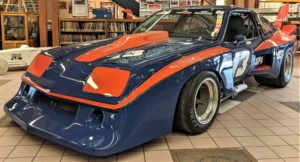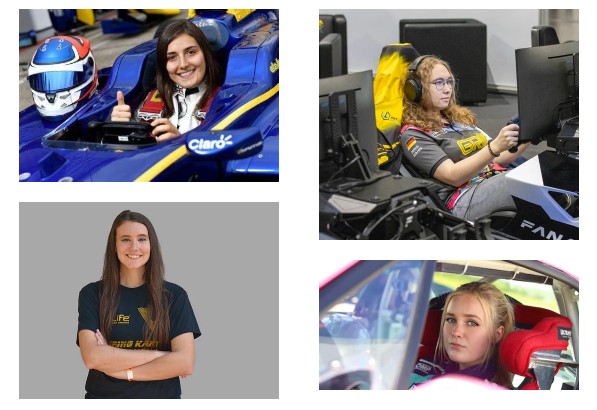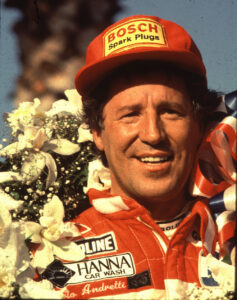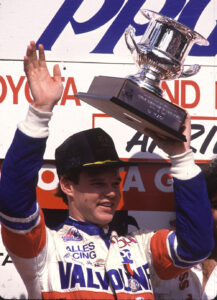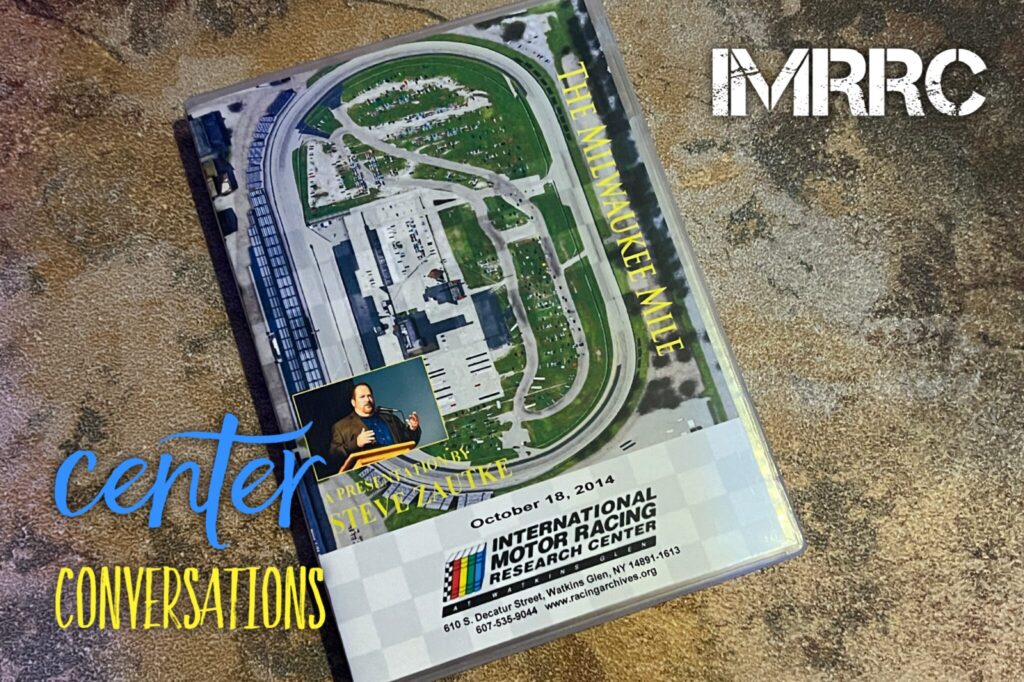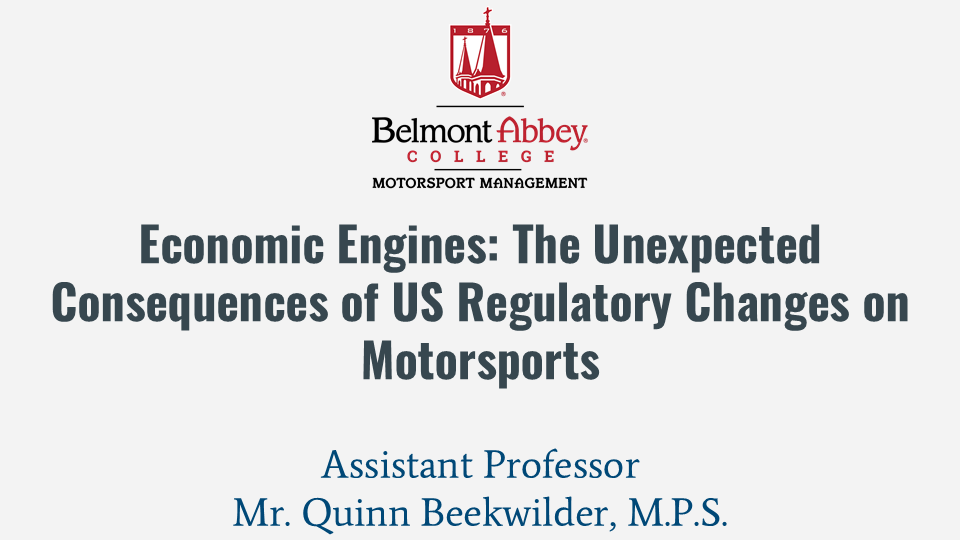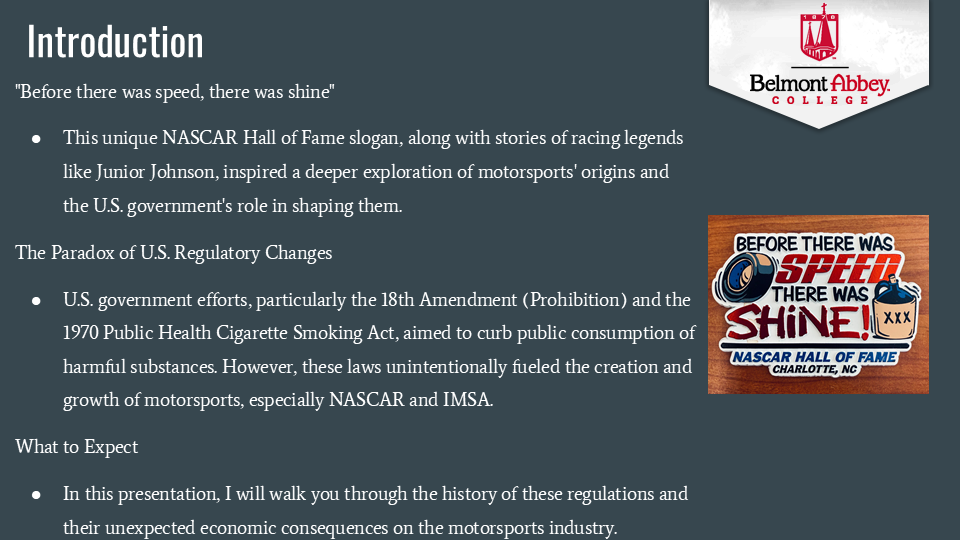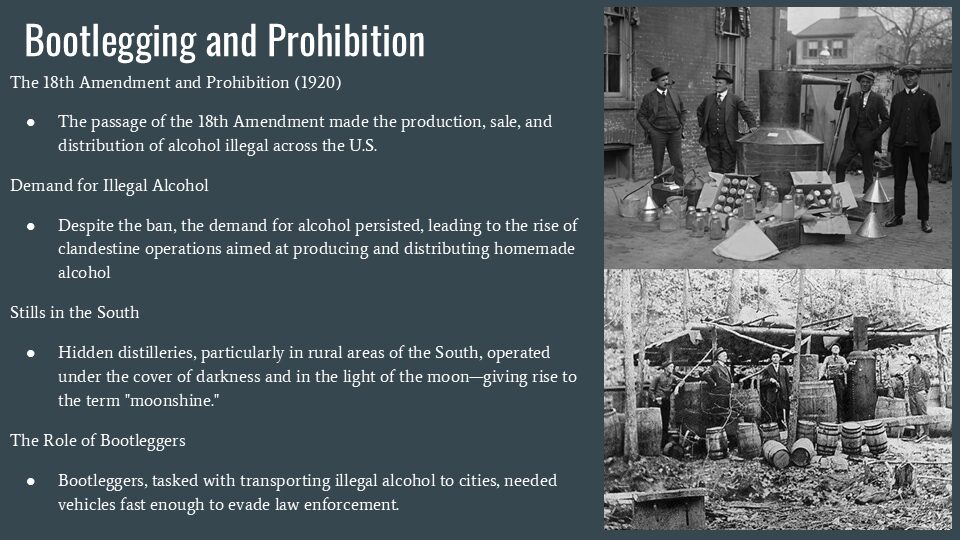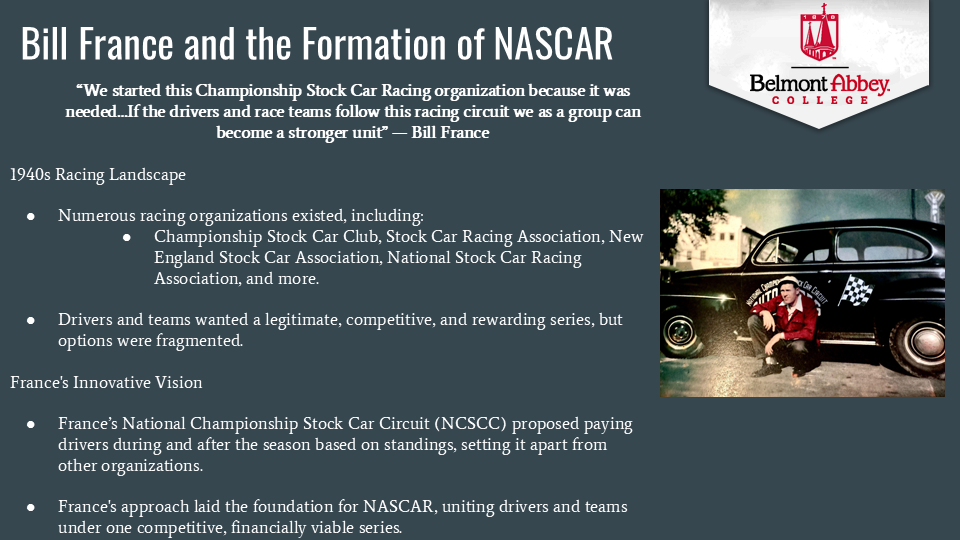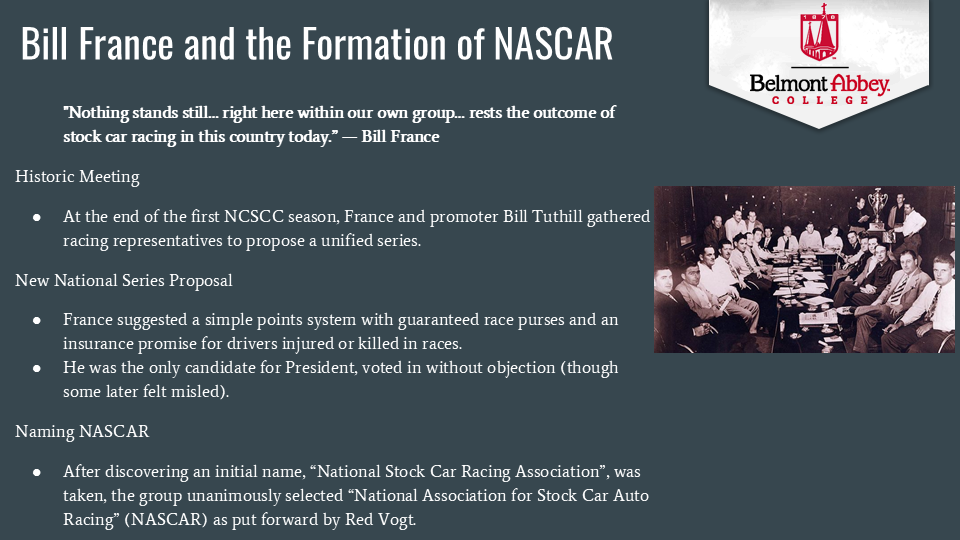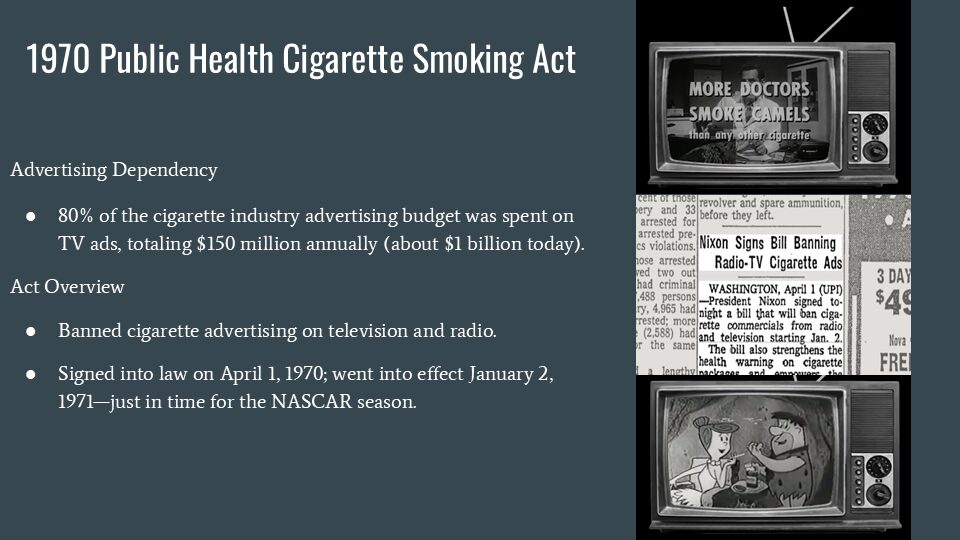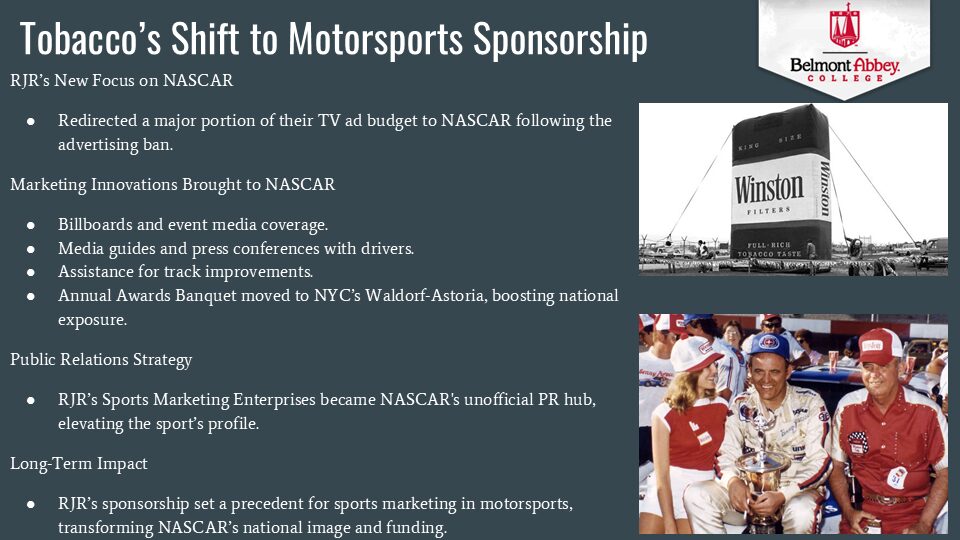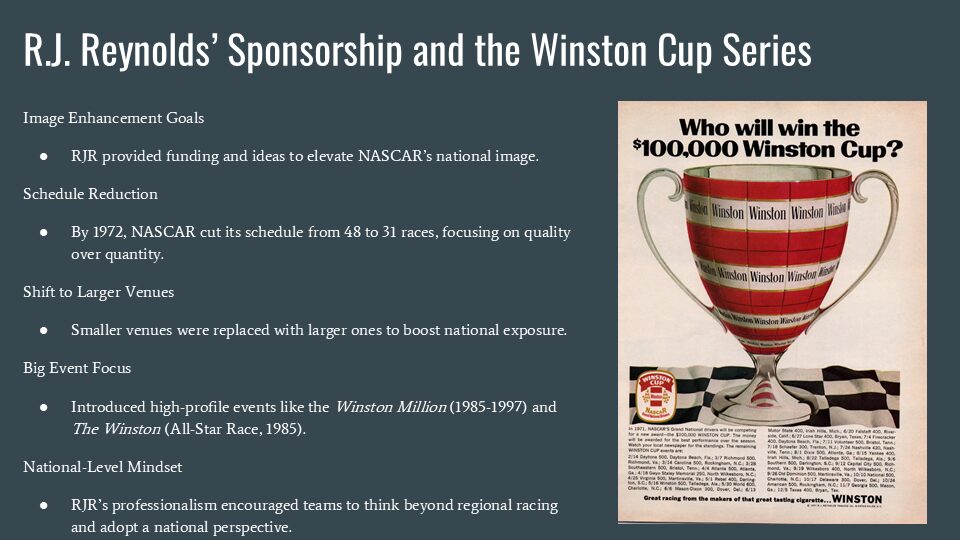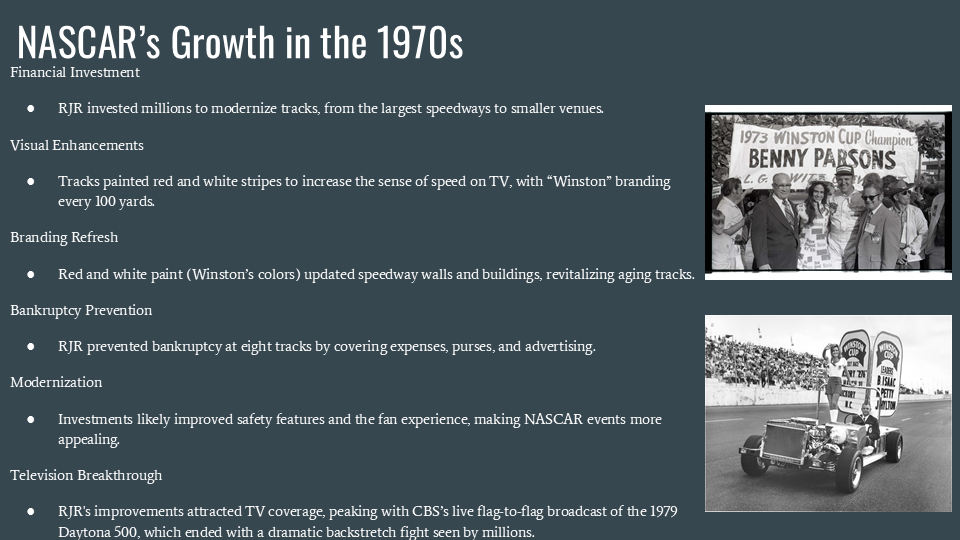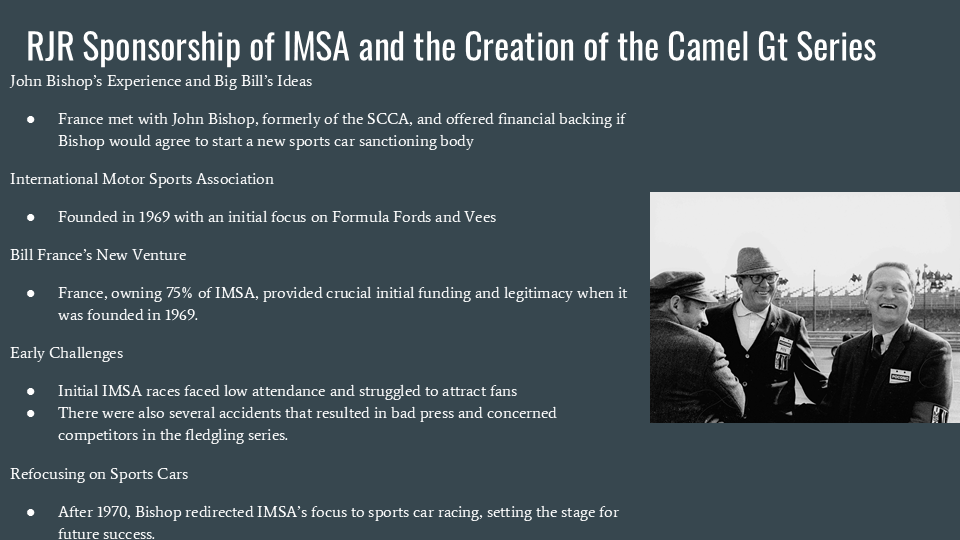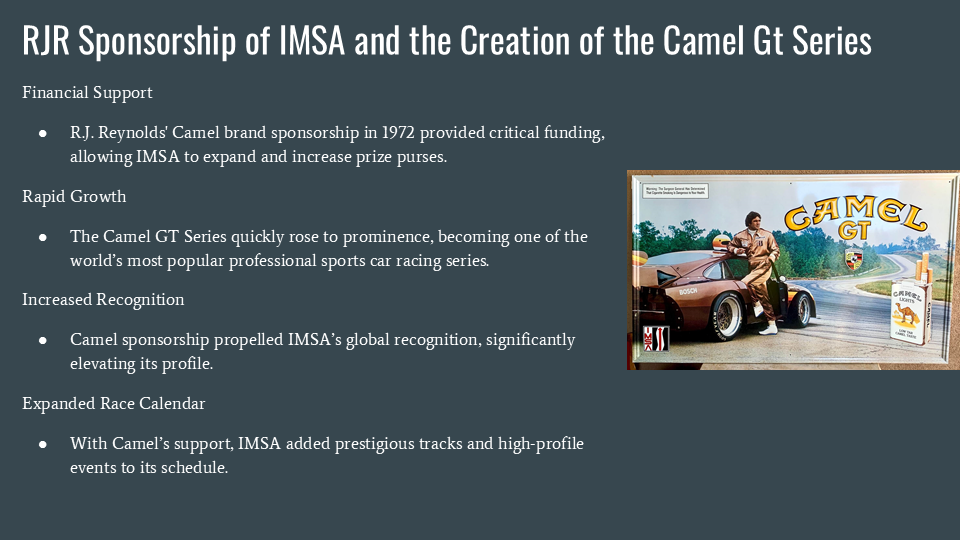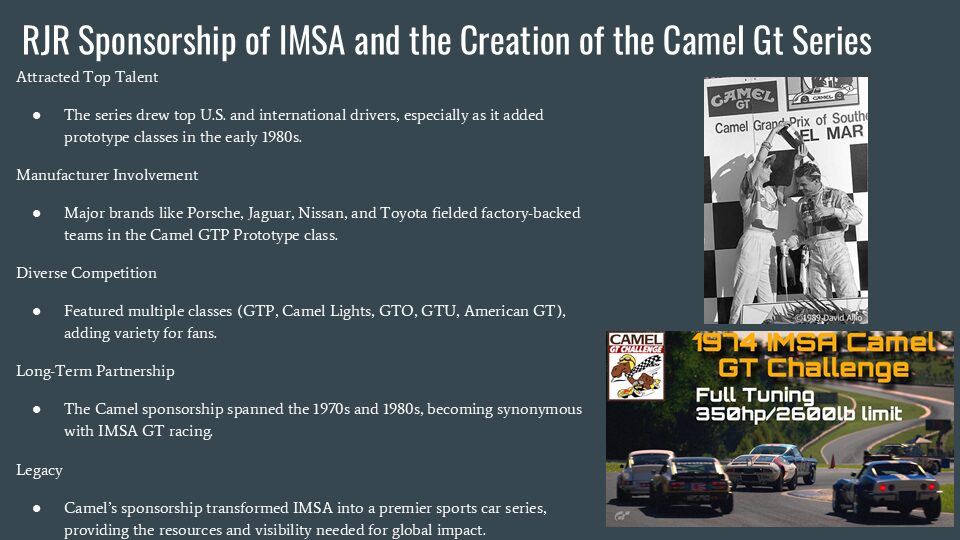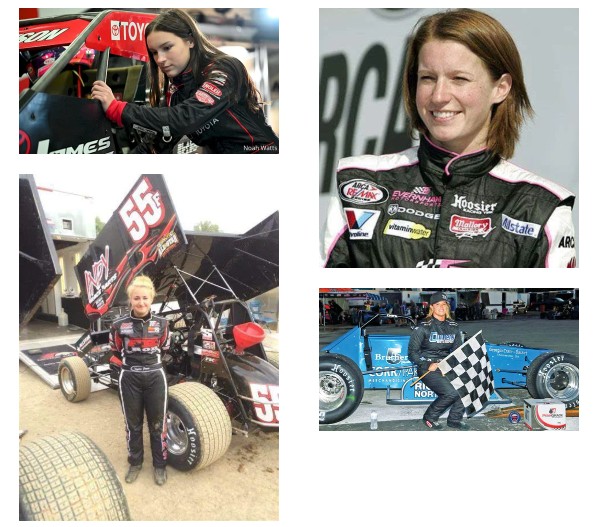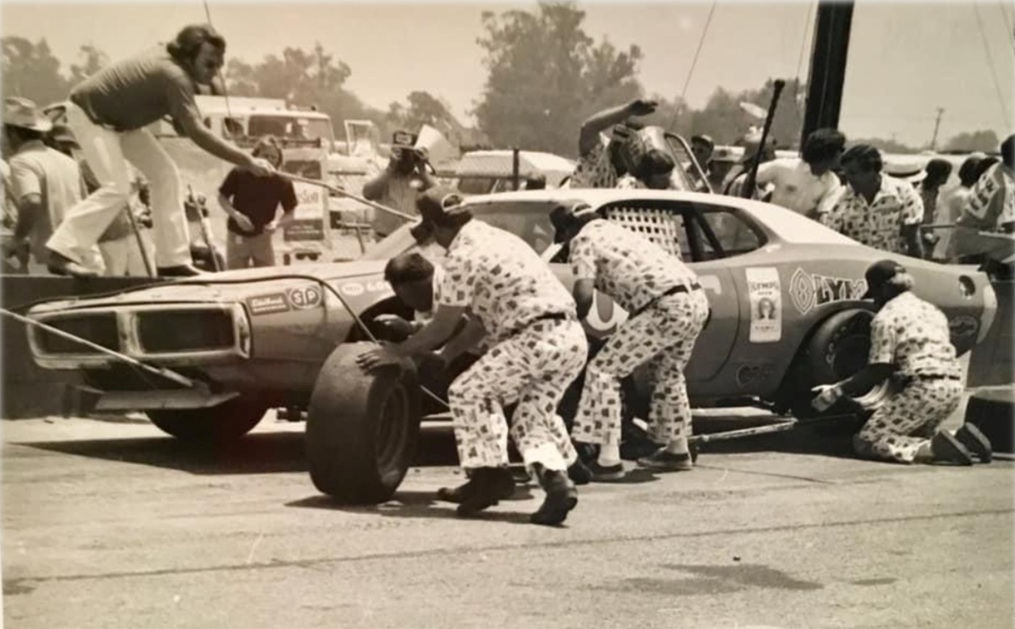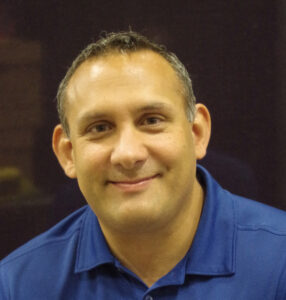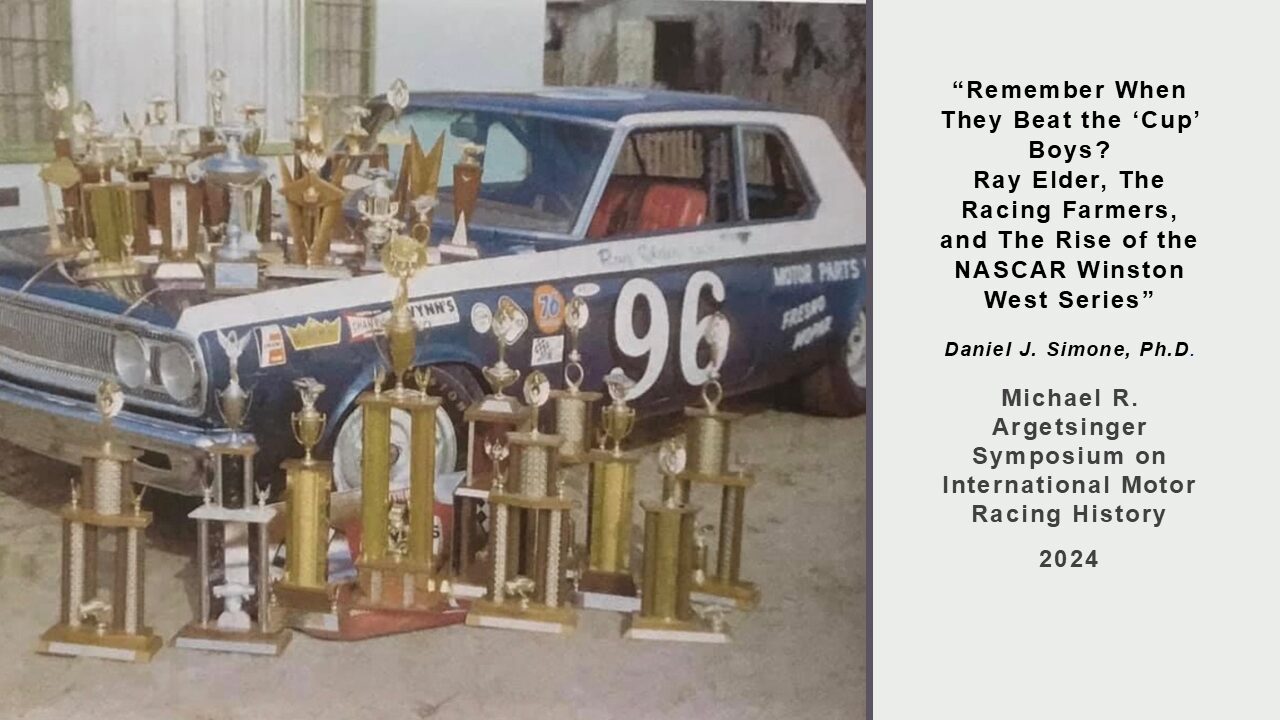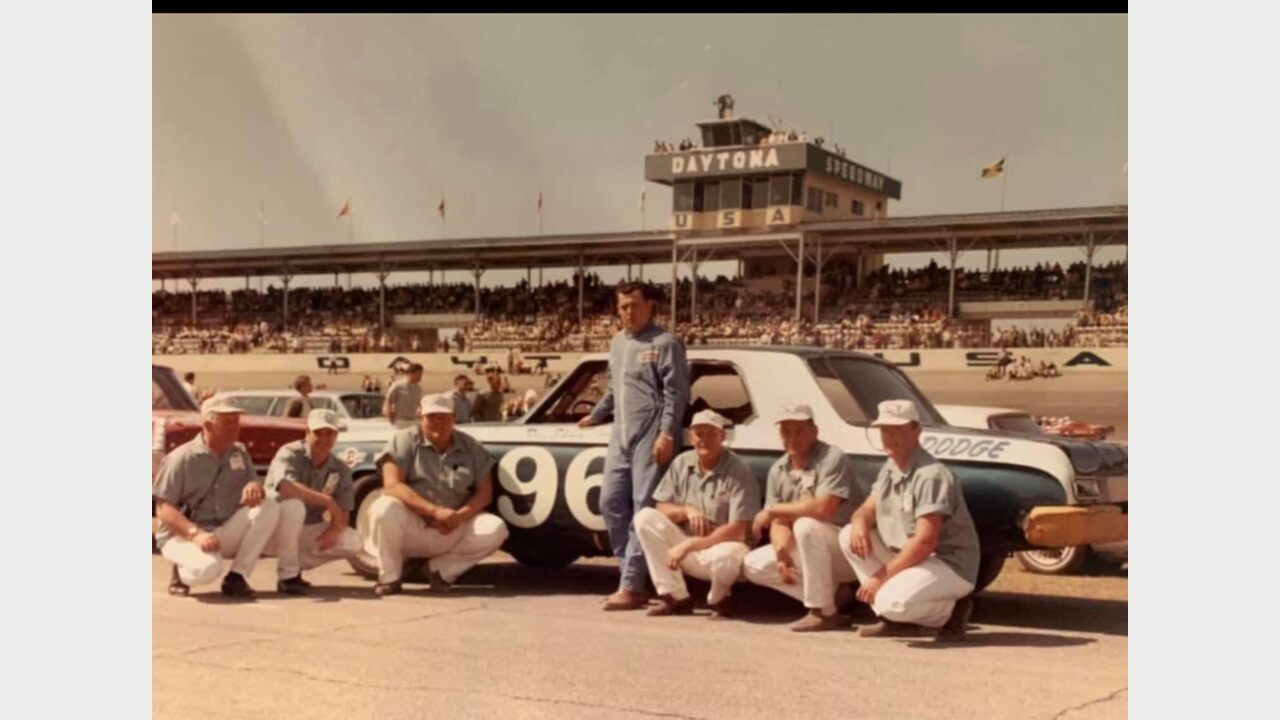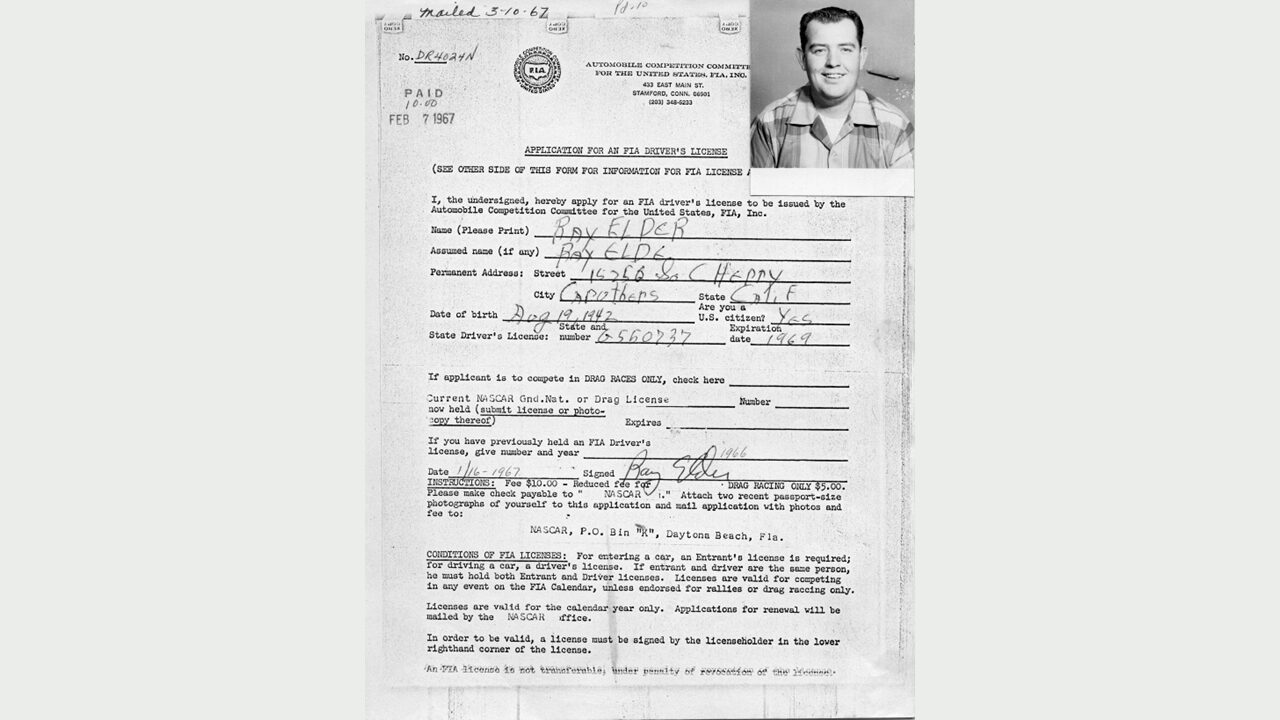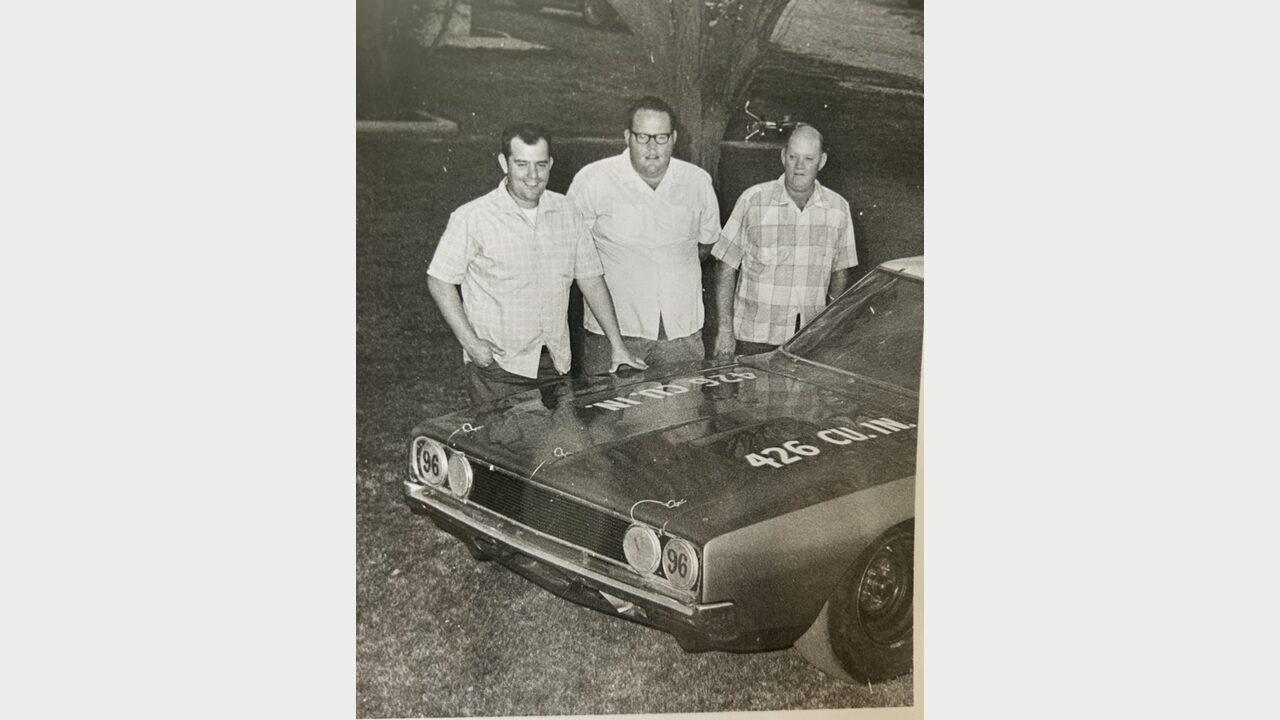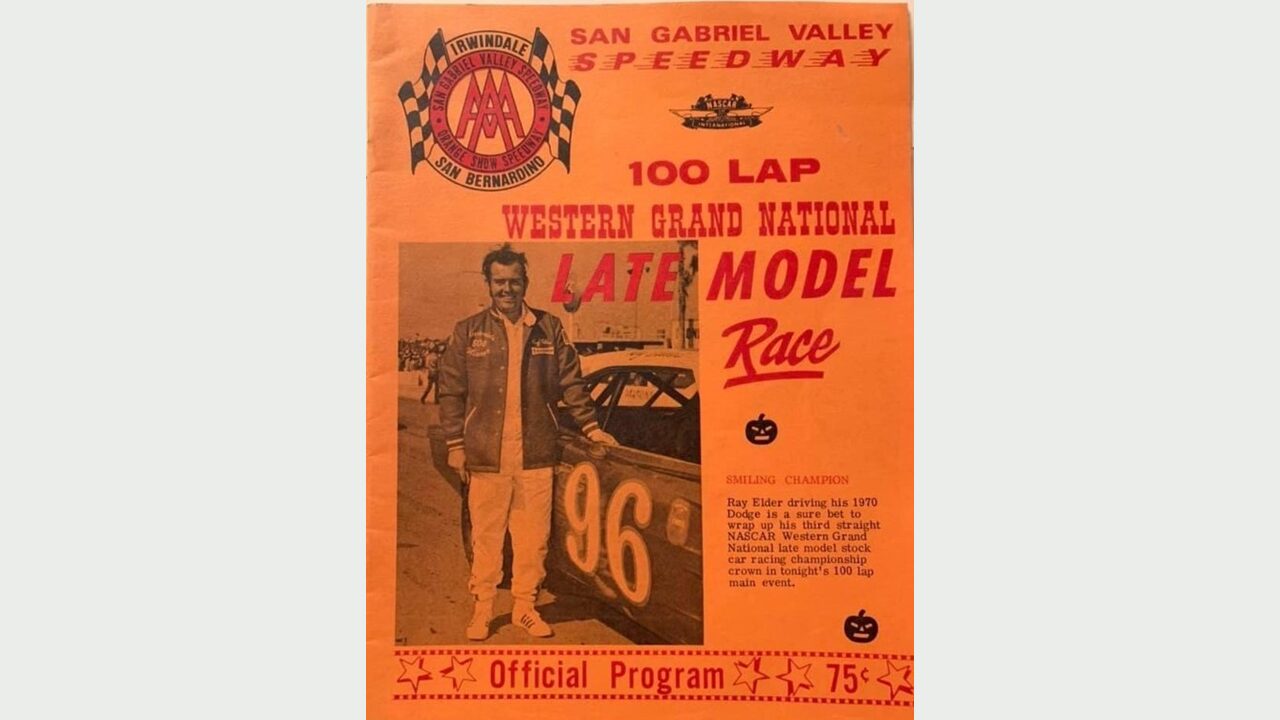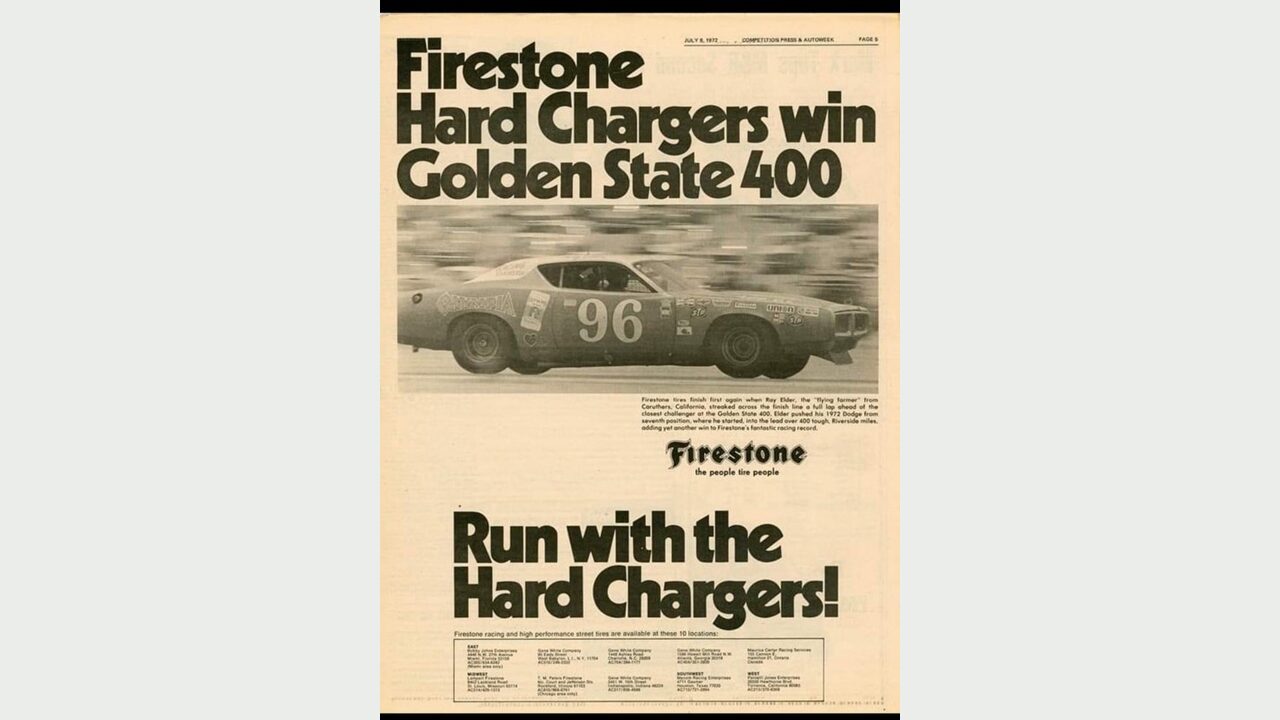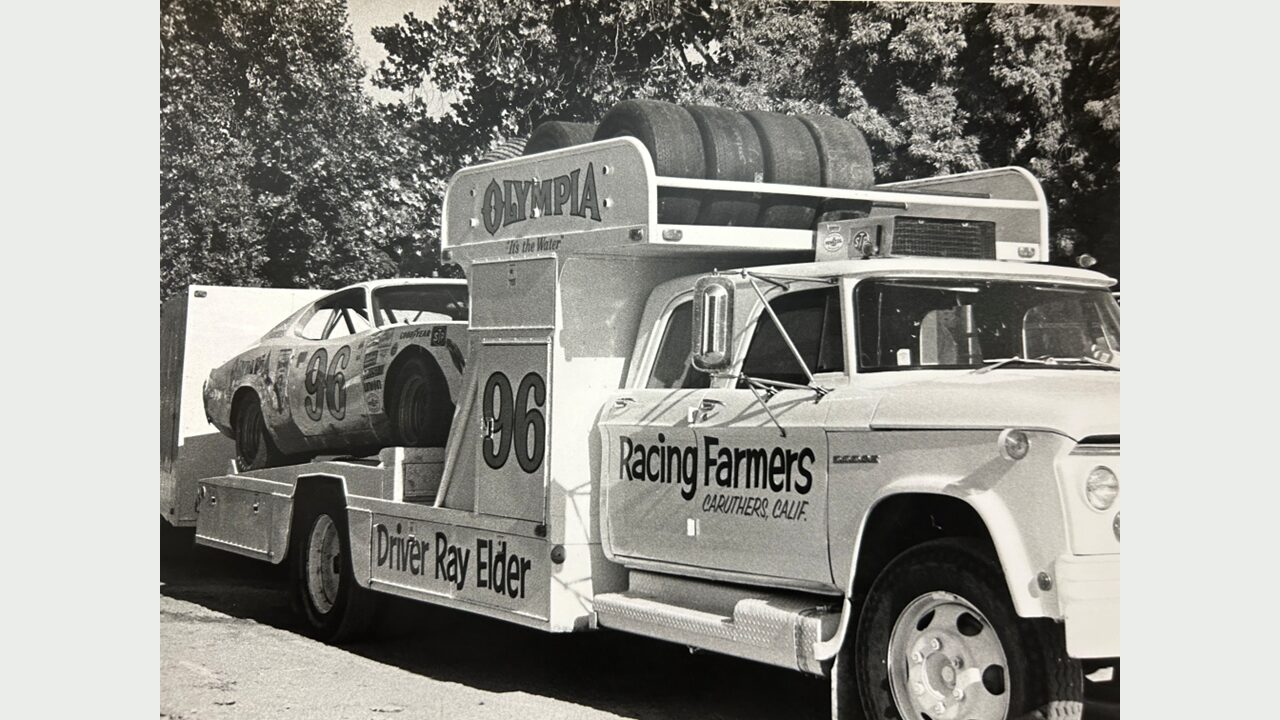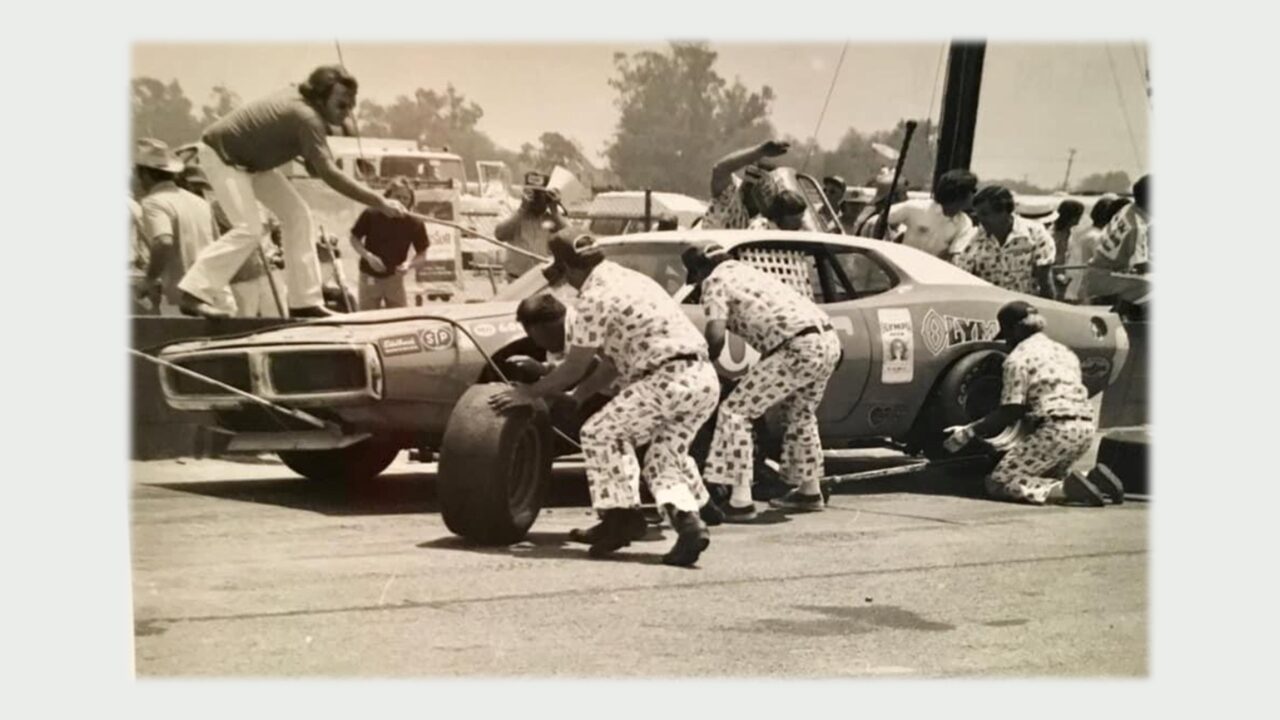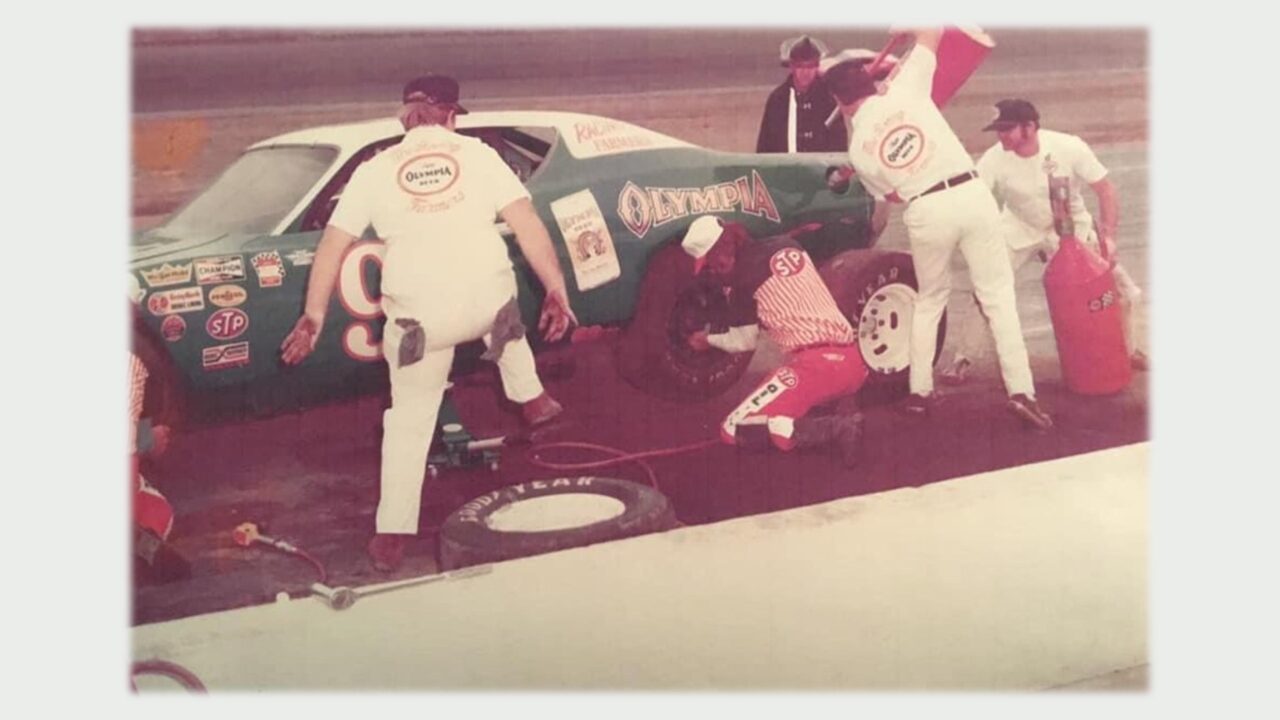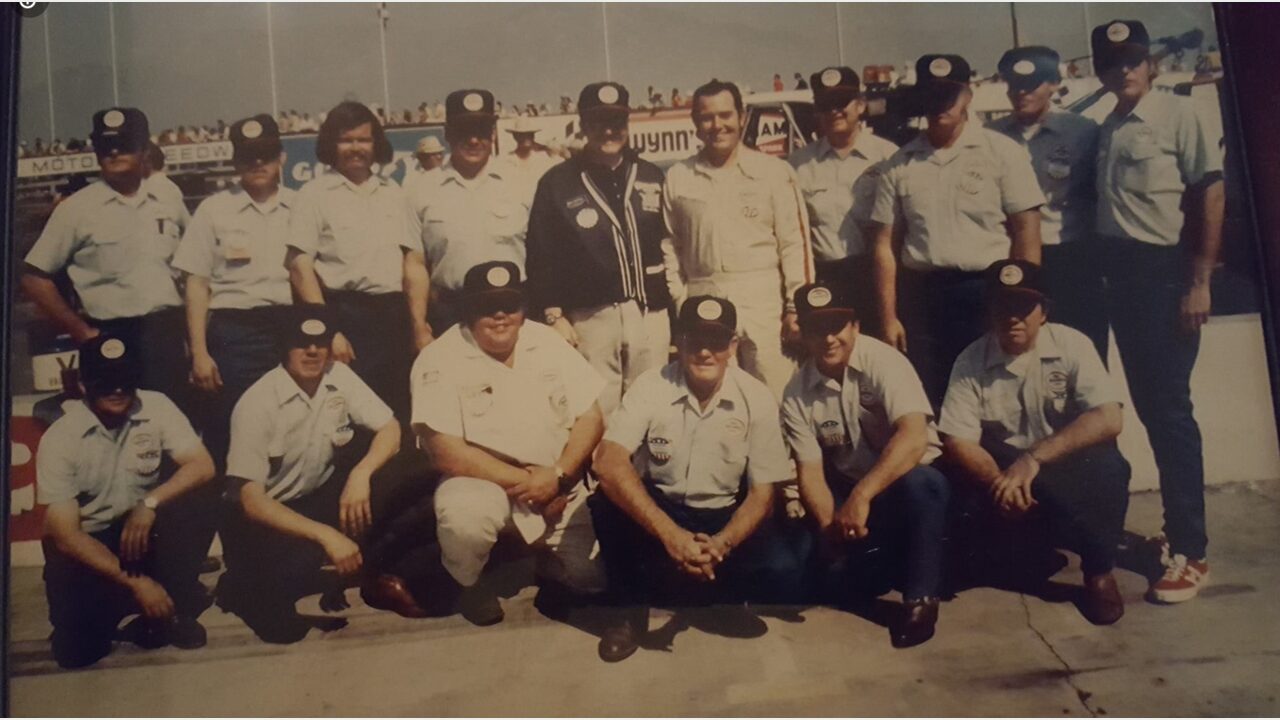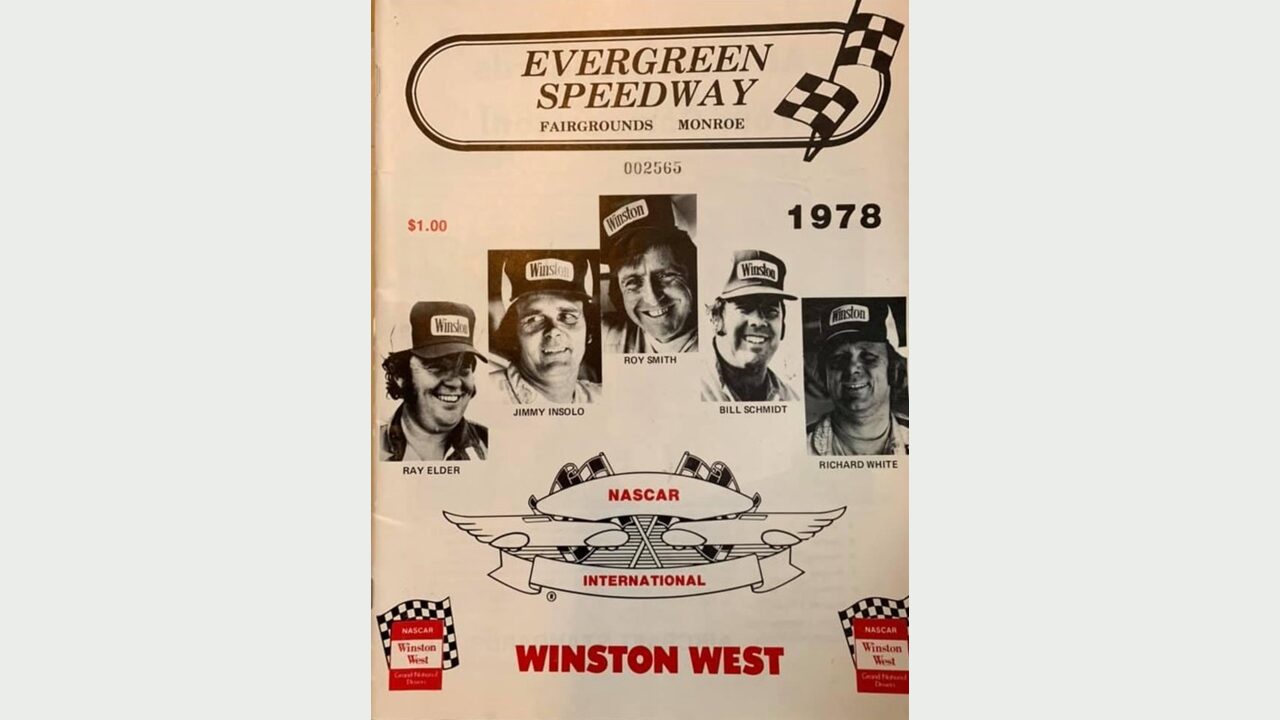Throughout its storied history, motorsports has been unwelcoming to women. Consequently, it has been necessary for female racers to develop unique strategies to enter what has long existed as an exclusive masculine enclave. While entry can be facilitated through a familial relationship with a male driver, women without such connections often get their start through participation in women-only racing events. Although these races have provided women with the opportunity to enter the track, they have not been without controversy. Detractors argue that women will not be considered legitimate racers unless they compete on the same track as men. Proponents view women-only racing not only as a way to attract more women into the sport, but also as an important source of skill development, support, and community building.
This paper investigates the evolution of women-only racing, from its early introduction as a media stunt, to its current incarnation as a proving ground for serious female open-wheel racers. Informed by archival resources and motorsport scholarship, it considers howwomen-only racing complicates, facilitates, and liberates women’s entry, participation, and recognition in the masculine world of motorsports.
This episode is sponsored in part by: The International Motor Racing Research Center (IMRRC), The Society of Automotive Historians (SAH), The Watkins Glen Area Chamber of Commerce, and the Argetsinger Family – and was recorded in front of a live studio audience. And has been Edited, Remastered and Produced in partnership with the Motoring Podcast Network.
Bio
 A Motor City native, Chris Lezotte spent part of her past life writing car commercials. After exiting her advertising career, she pursued a master’s in Women’s and Gender Studies at Eastern Michigan University and was awarded a PhD in American Culture Studies from Bowling Green State University. Now working as an independent scholar, Chris continues her research focused on the relationship between women and cars in a variety of contexts, including women’s participation in traditionally masculine car cultures as well as representations of women and cars in popular culture. Her work has been included in popular culture, women’s studies, transportation history, media studies, masculinity studies, and automotive history journals. Chris’s first book, Power Under Her Foot: Women Enthusiasts of American Muscle Cars, was published in 2018.
A Motor City native, Chris Lezotte spent part of her past life writing car commercials. After exiting her advertising career, she pursued a master’s in Women’s and Gender Studies at Eastern Michigan University and was awarded a PhD in American Culture Studies from Bowling Green State University. Now working as an independent scholar, Chris continues her research focused on the relationship between women and cars in a variety of contexts, including women’s participation in traditionally masculine car cultures as well as representations of women and cars in popular culture. Her work has been included in popular culture, women’s studies, transportation history, media studies, masculinity studies, and automotive history journals. Chris’s first book, Power Under Her Foot: Women Enthusiasts of American Muscle Cars, was published in 2018.
Slides
Swipe left or right (or use the arrows/dots) to navigate through the presentation slides as you follow along with the episode.
Highlights
- 00:00 Introduction and Sponsors
- 00:16 The Evolution of Women-Only Racing
- 01:24 Chris Lizotte’s Background
- 03:34 Early History of Women in Motorsports
- 06:40 Powderpuff Racing and Its Impact
- 10:17 The Rise of All-Female Racing Teams
- 15:28 The W Series and Modern Developments
- 22:19 Debate on Gender Segregation in Racing
- 24:12 Q&A Session
- 32:27 Closing Remarks and Credits
Other episodes you might enjoy
WATKINS GLEN, N.Y. (March 10, 2025) – Jordan Taylor, driver for the No. 40 Cadillac Wayne Taylor Racing V-Series.R GTP Team in the IMSA WeatherTech SportsCar Championship, has been named the 2025 Annual Membership Chairperson for the International Motor Racing Research Center, located in Watkins Glen, New York.
Taylor, 33, of Forest City, Florida, joins a stellar roster of past membership chairpersons, including Brian Redman, Helio Castroneves, Mario Andretti, Lyn St. James, Phil Hill, Dan Gurney, Sir Stirling Moss, among other illustrious icons of motorsports.
Taylor’s duties for the year include being an advocate in support of the IMRRC’s mission to collect, preserve and share the global history of motorsports, and to help create sustainability by drawing in new generations of motor racing fans.
“I am a huge fan of motorsports, obviously, growing up around the sport and being around sports car racing in particular, as long as I can remember,” said Taylor, son of IMSA team owner and three time World Sportscar Champion, Wayne Taylor. “I’ve always been a fan of the history of the sport, especially my dad’s generation, and the different evolutions of race cars. For me, just being a big fan of the sport makes this assignment exciting for me.”
Taylor’s racing career began in 2011, competing for Autohaus Motorsports. He then moved to Corvette Racing from 2012-2017. Now racing for Cadillac Wayne Taylor Racing in IMSA, Taylor and the team won the 2024 12 Hours of Sebring, and were third at the Rolex 24 At Daytona. During his tenure with WTR and Cadillac Racing, he’s collected two overall Prototype championships (2013 and 2017) and two overall Rolex 24 wins (2017 and 2019). Prior to his return to prototype racing, Taylor captured two GTLM championships in 2020 and 2021, a third in GTD-Pro in 2022 and a GTLM class victory at the 2021
Rolex 24.
“I’m probably one of the younger people who has been honored with this position at the IMRRC,” added Taylor. “I think I can connect to the younger generation, who may not appreciate the history of the sport as much as the older generation. I’d like to help my generation get up to speed.”
Mark Steigerwald, Executive Director of the IMRRC, welcomed Taylor, saying, “We are honored to have Jordan join our team as this year’s membership chairperson. I’m confident his passion for the sport as an advocate for the Center’s mission will reach all generations of motor racing fans who can appreciate what the Center is doing to preserve the sport’s rich history.”
In celebration of 60 years of TransAM racing, and the inaugural class of Hall of Famers at Sebring in 2025; we wanted to take you back to 2015 when the IMRRC hosted a panel of notable figures in TransAm’s history. Folks like Chuck Cantwell, Lee Dykstra, Don Cox, John ‘Woody’ Woodard, Tommy Kendall, Butch Leitzinger were hosted by Judy Stropus – recapping the first 50 years of the series.
This panel covers the history and development of Trans Am racing, their personal experiences, stories of innovation and trickery in racing, and the evolution of race car technology. They also reflect on memorable races, provide insights into their careers, and discuss the competitive spirit and changes in this unique variant of Road Racing. Featuring a live audience Q&A, they also touch upon the current state of Trans Am compared to its earlier days.
Highlights
- 00:00 Celebrating 60 Years of Trans Am Racing
- 01:07 Panel Introduction; Judy Stropas Takes the Stage
- 07:35 Chuck Cantwell’s Early Trans Am Days
- 11:14 Lee Dykstra’s Contributions to Trans Am
- 14:03 Don Cox’s Chevrolet Insights
- 20:04 John Woodard’s Penske Racing Journey
- 25:33 Butch Leitzinger’s Trans Am Experience
- 27:39 Tommy Kendall’s Racing Legacy
- 35:55 Stories of Innovation and Trickery
- 47:49 The Controversy of Traction Control
- 53:55 Balance of Performance
- 56:01 Roger Penske’s Winning Strategy
- 58:35 Historic Trans Am Cars and Their Legacy
- 01:05:51 Conclusion and Audience Q&A
- 01:20:27 The Future of Racing: Innovation vs. Regulation
This episode is part of our HISTORY OF MOTORSPORTS SERIES and is sponsored in part by: The International Motor Racing Research Center (IMRRC), The Society of Automotive Historians (SAH), The Watkins Glen Area Chamber of Commerce, and the Argetsinger Family – and was recorded in front of a live studio audience.
Transcript
Crew Chief Brad: [00:00:00] Brake Fix’s History of Motorsports series is brought to you in part by the International Motor Racing Research Center, as well as the Society of Automotive Historians, the Watkins Glen Area Chamber of Commerce, and the Argettsinger family.
Crew Chief Eric: In celebration of 60 years of Trans Am racing and the inaugural class of Hall of Famers at Sebring in 2025, we wanted to take you back to 2015 when the IMRRC hosted a panel of notable figures in Trans Am’s history.
Folks like Chuck Cantwell, Lee Dykstra, Don Cox, John Woody Woodard, Tommy Kendall, Butch Leitzinger, were all hosted by Judy Stropas for a recap of the first 50 years of the Trans Am series. This panel covers the history and development of Trans Am racing, personal experiences, stories of innovation and trickery in racing, and the evolution of race car technology.
The panel also reflects on memorable races, providing insights into their careers, and they discuss the competitive spirit and changes in this unique variant of road racing. [00:01:00] Featuring a live audience Q& A, they also touch upon the current state of Trans Am compared to its earlier days.
IMRRC: My name is Tom William, and if I haven’t had a chance to meet all of you, and I can’t tell you how delighted we are to have you all here, and have this wonderful panel here today.
As you know, the Motor Racing Research Center here in Watkins Glen is the archive, and we struggle to be, and strive to be, the international archive for the history of motor sports. Not just in Watkins Glen, but from all over the country, and indeed all over the world. So we’re going to be talking about TransAm, and now I’d like to introduce another very special person to the International Motor Racing Research Center.
Judy Stropas. Judy for many years was the timer scorer for the Butmore Racing, also for the AMC Javelin Team and the Penske Racing Trans Am. She also was the public relations manager for Chevrolet. And it is my pleasure now to introduce and turn this microphone over to Judy.[00:02:00]
Judy Stropus: panel. We have certainly people from the past and present who will, uh, help decipher all the secrets and all the maneuverings that went on back in the day and probably still go on. So now I’d like to introduce our panel. And because, as I said, we cover the gamut of several years. All 50 years, pretty much.
Although the last few, I don’t think we have anybody representing the last few years. So I’d like to introduce Chuck Cantrell. Chuck is a graduate of General Motors Institute in 1956 and he raced in SCCA in the 50s and joined GM Styling as a GM tech center as an engineer in 1960. He continued to be an avid SCCA racer.
I’m sure you’ll all correct me if there’s anything wrong with the title. Winning several divisional titles in F& B production and joined Ford Special Vehicles as a Shelby American liaison for a Mustang program. [00:03:00] Also working on the GT350 and 500 programs, spending three years in Trans Am racing with children.
Followed a 68 race season, he joined Penske Racing as race shop general manager in 2009. for the road racing teams through 73, which of course included a team’s Trans Am wins in 68, 69 in Camaros, and 71 through Javelins. Lee Dykstra. Lee also attended The General Motors Institute and work for Cadillac. He joined Car Craft as a race engineer from 1968 to 70, working on the Ford GT and the Trans Am program, where he was responsible for the handling package for the Ford ESV safety car.
He was also responsible for the design and development of the 1968 to 70 Trans Am Mustang. which won the championship in 70. Since that time, he started Econ Engineering, designing the Insta Title winning Chevy 77, designing 19 complete race cars for a number of series, as president of the Special Chassis, and director of technology for Champ Car World Series.
He was race [00:04:00] engineer for many years after that, for a number of open wheel series. John Woody Woodard. Woody worked for Penske Racing for more than 30 years, beginning in 69. In the first eight years, he was a full time race mechanic. In particular, he was the chief mechanic on Markdown. He was 1969 Trans Am Championship winning Camaro and the 1970 Javelin.
He was also chief mechanic on Penske Racing’s Sunoco Ferrari 512, below the Q192, the owner of Porsche 91710. Porsche 917 30 and worked on the NASCAR team fielding the AMC Matador and Mercury Montego. Who remembers those days? Um, continued to work for Penske Racing, another business that was a weekend warrior, through 89 on the IndyCar team.
He retired from Penske Corp in 1999. Don Copps. Don was Penske Racing’s first and only engineer from 1969 76. He started his career as an engineer in Chevrolet’s R& D department. 1964, he graduated from what he said was Kettering University, but that was [00:05:00] originally the General Motors Institute in 1962 and worked for Chevrolet on the Chaparral Project 66 to 68 before being assigned to Penske Racing to project in 69.
He left GM at the end of 69 to work Penske Raisings, TransAm Javelin program through 76. He was involved in all Penske Raisings project.
He also ended up doing business with Penske and ventured into the Detroit diesel business in 76. He retired in 2001 and now spends his free time driving the PCA events in the Northeast including Hawkins Lane. Tommy Kendall. Tommy began his career in S& GT driving a GT Mazda RX 7 and winning the 86 and 87 championships.
Later he won three other titles in the same car, which he still owns. Is that correct?
Tommy Kendall: Other people won three titles. Oh, okay.
Judy Stropus: I can fix this with that. He dominated the SECA Trans Am Series in the 90s, scoring four championships, racing a Chevy Beretta and a [00:06:00] Ford Mustang to those titles. In 97 in a Mustang, he won every single race on the schedule except for the last two, and then represented the series for six IROC seasons.
He’s competed in NASCAR, in the Bathurst In 1991, you might remember, he suffered serious leg injuries along his way when a mechanical failure caused his intrepid GTP Chevy to leave the track and crash head on into a car wall. NASCAR driver J. D. McDuffie had been killed in the same turn a month later.
Both crashes led to the addition of the chicane on the back stretch. He called it a crossroads in his career. He did, however, return racing in 92, and later competed in the Dodge Viper in the fail and escape. Now he has a broadcasting career. Hosting shows on Speed TV in the past and now Fox Sports Club.
Butch finished second in the 2002 Trans Am Series and ended up as the Rookie of the Year. And it was his only season driving in the Trans Am Series, racing Corvette [00:07:00] for Tomboy. His career includes racing for the Bentley factory team at Le Mans, the Cadillac team at Le Mans, and Panos He earned victories in the 2010 12 hours of Stephen Long Beach and a podium finish at Laguna Seca, competing in all four races that year.
He’s driven in the ALMS series for a number of teams, and he’s competed in NASCAR races, racing three times at Wadley’s Ladder with a best finish of 12. 95. And of course, he’s the son of popular, and son, and Trans Am driver, Bob Leitzinger. So, I’d like to start with the elder statesman of the, uh, series and of the panel.
And that would be Chuck Cantwell. So, Chuck, you were originally in the series in 1966
Chuck Cantwell: when it started. In 1966, in 1965, the SEC decided to have a series called Trans Hand. And, uh, Shelby involved one of us. We had a meeting with George Murrow and Louis Bensford and myself. And I was assigned the task of We’re doing the homologation papers for the cars for the [00:08:00] Trans Am N66.
We haven’t built a car, I mean, yet, so the car was sort of designed within the homologation papers. We had to run around and take pictures, accumulate dimensions, and get part numbers for all the options we wanted to put on the car. And that was sent to Ford, and all they had to do was paste up a, a main wheel on the side of a picture of a regular Ford sedan, because we didn’t have any pictures like that at the time.
After the first of the year, Shelby gave me a budget of 5, 000 to build a car. And, uh, that included going to the dealer and buying a car. So, we did that. We built a car and then tested it, uh, uh, several times. And then we ordered 10 more cars initially. And then I, all together we built 25 Trans Am cars for customers.
We had, uh, homologated Group 1 and Group 2 cars. The Group 2 would be on the Trans Am car. Group 1 was sort of a Modified Mustang. That was a rally car. We built four of ’em to begin [00:09:00] with and they went to Europe and and Australia. So we built the cars and the, the series was run First Race was at Sebring.
AJ Foyt ran in that race, ran a mustang of some kind, not one of ours. ’cause most of the drivers at the beginning were independent drivers that built their own cars. And we sold a Mustang, we sold the parts, but they ran. Or the first race was one like Jo and. In an alpha, I believe, when the Mustang was second in that race.
Or, Tulius was second in that part. And then the series went on from there. It ran only seven races in 1966. At the end of the sixth race, uh, Mustang and Chrysler were pretty close in points. Ford asked us to run a Mustang in the. Sixth race at Riverside. We had a car that I just tested and had been finished up and was ready for sale.
Hadn’t been bought yet, so we took that car and cleaned it up. Took it out to the track with two crew guys and ran the race and won the race. It wasn’t an [00:10:00] easy, particularly, it was sort of a wire to wire win almost. At the beginning, the car wouldn’t start until the Le Mans started, so he didn’t get off until the middle of the field.
And halfway through the race, he managed to, Titus, Terry Titus was driving, he managed to knock the car out. The oil filter loose and came in in a big cloud of smoke in the pits and they changed the oil filter and threw in four course of oil and hooked. That was enough, and then he went out and won the race.
So that won the championship for Ford and sort of set us up on the line to get a Ford sponsored team for the six to seven six.
Judy Stropus: I would then jump over to Lee Ra who got involved in, well, we skipped 1967. I may be the only one who was in the 1967 series on, or you were in the Trans Act.
John ‘Woody’ Woodard: I witnessed it.
Judy Stropus: I know you were, but besides you.
No, I know, but I mean, other than you. When I was with the Baltimore Cougar team, and that was an interesting, uh, I was introduced to the Cougar [00:11:00] team in Marlboro, I can’t even say Marlboro, Maryland, for a five hour race, and, uh, I got hired by them, and they paid me 25, but they, after that, it was We did a great job in my opinion, and it was hard for the rest of the season.
So let’s go to Lee Dykstra, who was very important with the Ford effort and Car Craft at the time. So how did Car Craft get involved in TransAm?
Lee Dykstra: So Car Craft got involved because Brad Fernandes, who was a Ford liaison for the Ford Motor Team, had a hold of me because we were doing the Ford long distance cars and essentially a racing engineering job for Ford, and asked about The rear suspension on the Mustang, well it had long upper link in the thing, which wasn’t compatible with the leaf spring geometry.
So we told him, this is what you have to do to it. And he must have been impressed or something like that. Because the next year, then essentially we got a couple of cars from Shelby, 67 cars. And we built the [00:12:00] 68 cars which you may have seen over at the museum. That was one of the cars that we built. So, just prior to the 24 hour of Daytona, we built the two cars, and the two cars were run by Titus and Buckner and Horst Quek and Alan Mocker.
We came in that race fourth overall in the thing, second car with Quek and Wilken Tower in the thing, so it was a DNF. Jerry’s car ran the whole thing and, uh, I can remember coming to pit stops and we put so much oil in this car that we needed one of the fuel rigs to feed the oil to. They would open the door and wipe the floor because there was so much oil in the cockpit that his foot was slipping off the pedals, so we had slipping clutch, slipping brakes, and slipping From then on, it was sort of I don’t know, it was a good thing that we did that first race because we got our spears up a little bit.
But from then on we got totally beat the whole time because we had [00:13:00] an engine that might have been down on power but was unreliable. And then we also were all homologated because the Penske cars had spoilers on the front and rear and we had nothing. So we spent the whole season, uh, eating whatever curl or whatever you want to call it.
And, you know, vowed to continue on and do this. So, we won, I think, four races and three races in 1968. And all of them were sort of by accident because we won, uh, Daytona, which is why the Penske car went out. At Sebring, we lost. We won again with, uh, Jerry, actually here at Flint. And we won at Horse Quek at Riverside.
And that was about the extent of it. I’ve got some stuff a little later with social pictures of us testing at Riverside, trying to get proper engines. So we had a Gurney Westlake in the car. We had Shelby guys, uh, John Donne, built proper, uh, teleport. We tested that. That was good. And then we had spoilers and all that sort of thing that we tested at Riverside.[00:14:00]
And came back strong in 69 with a proper race car.
Judy Stropus: Alright, so Don Cox as a GM engineer, as a Chevrolet engineer. At the time, while Ford was openly in racing, Chevrolet was still very much everything out the back door in those days, which made it very, really very exciting. So tell us about your role in that.
Don Cox: This is where it gets really exciting. Um, Lee and I went to college together. Lee and I built three race cars together after we got out of college. One of those cars was in the Mossport Grand Prix with people like Pedro Rodriguez, Jim Hall, John Surtees, Jothar Motsenbacher, all these kinds of people. And our car qualified 7th.
That’s why the Ford guy, Roy Lund, came over and offered all three of us a job on the spot. Lee and I went over to talk to him the next week. Lee ended up taking the job. I stayed with Chevrolet because I was working [00:15:00] on the Chaparral stuff and I was perfectly happy there. So, in June of 68, I ran into Lee on a ferry boat going across to Wisconsin or someplace in Michigan.
Lee was telling me how he was working on the Ford project and they were homologating all of this stuff. And they were going to beat the guy that was beating them so bad in 68. And I’m yawning and thinking, well that’s fun, that’s nice, because I’m working on all this other stuff. The chaparral and wings and all that stuff, so I was happy.
Well, as luck would have it, in March of 69, I get assigned to the Penske project. And I wake up in the morning and I think, oh my god, I’m going to be involved with the Trans Am cars. These are the same cars that Lee has been working on all of 1968 to go and beat Penske in 1969. And when we got to the first race, those cars were so fast, they beat us four out of the first five races, and the lap times weren’t even close.[00:16:00]
So, here’s two guys, went to school together, were in business together, that are exact opposites on the two teams. I’m representing Chevrolet, and Lee is representing Ford. That is my initiation into Trans Am Racing.
Judy Stropus: But my question was, about the backdoor, the Chevrolet backdoor during those early years of racing.
Well,
Don Cox: early years of Trans Am racing, I wasn’t involved in that. Penske was being helped, as a lot of other people, anybody who wanted to be helped, by the Product and Performance Group, with Vince Figgins and all these people. And it wasn’t until March of 69 that John DeLorean became head of Chevrolet.
Roger Pinsky and John DeLorean were big buddies. And Pinsky insisted on getting help from the R& D group as opposed to getting help from the product performance group. And so that’s how I got involved. At the end of [00:17:00] 69, Pinsky went to American Motors and hired me away from Chevrolet. But in 67 and 68, he got technical assistance from Chevrolet, but to my knowledge, never got a penny of actual money.
And when American Motors came along in 69 and offered Roger, I think in the order of a million dollars to run Javelins, that’s when Roger switched from Chevy to American Motors.
Judy Stropus: Jumping back to Lee, because you wanted to talk about how the three amigos, I should say hombres, You, Chuck, and Don got together, so you’re going to get some slides you want to show.
Lee Dykstra: One of the things that Don talked about was us building the car, so I’ve got some photographs just to show you the car, how it sort of evolved. I tried to do some pictures that sort of tied in some of the panels here. This is a car that we built in my garage in [00:18:00] Ferndale. So essentially that’s a brick aluminum powered C modified.
It had a space frame, it had a weight of about 1, 300 pounds. Don did the engine transmission and rear tempest transaxle. The guy driving is Bob Stout, who is another engineer who is in our same class. So he did all the fabrication and welding and that sort of thing. The body came from a place in Minnesota that built, this is sort of, looks like a birdcage Maserati.
This particular car learned me a lot of lessons because every time it went off the road, some suspension bent or something like that. We had a swing axle in the back with a totally decoupled, but it wasn’t. It gave me a damping involved. Don ended up crashing this car and totally knocked it out.
Don Cox: Which is the best thing that could have ever happened to me.
Lee Dykstra: It, uh, crashed at Waterford Hills because there was a car with a carburetor on it. And it kept cutting out in the dirt. [00:19:00] And we wouldn’t modify the body to put the proper carburetor on it. So it cut out in the dirt. Unfortunately, it ended up toting the car because of that. The second car I had, Don and I went to Ford to Jack Passmore and got a Ford engine.
And the Cadillac guys were so mad that I had a Ford engine in one of these cars, that they offered to build me a proper Cadillac racing engine. With hydraulic lifters and 300 horsepower and four barrel carburetor. So we built the car with a, um, Cadillac engine. This is still a front engine car. This is the one that raced at Mossport, where we ended up qualifying in seventh.
The thing, obviously, looks very nice because of no mold for the body. So it never looked much better than that. But it was pretty fast and the driver was Glenn Lyle. Some of you might know him that ran Ford Performance. Quite a few years. That’s how, essentially, I got into Trans Am, because I got the [00:20:00] job at Carcorac because of this car.
Judy Stropus: We’ll come back to these slides. But I do want to get to Woody, John Woodard, and his early years with Penske Racing. How did you end up getting that job?
John ‘Woody’ Woodard: In the mid 60s, uh, I was working in Annapolis, Maryland as a mechanic at a sports car shop right in downtown Annapolis. And Marlboro Raceway was less than 20 miles away.
And I went to a couple races and got interested and got my SECA license. Invested in a Lotus Super 7, and did a bunch of racing at Marlboro, up and down the east. And in 1967, I happened to attend the Marlboro, I thought it was a 6 hour race, but it could have been a 5 or a 3 or whatever. But I’m walking around the infield, the first day of practice, and this beautiful blue Chevrolet Slantback truck rolls in, with an absolutely gorgeous 67 Camaro Trans Am car on the back.
Candidates climb out, and they’re all dressed neatly in, uh, like uniforms, and [00:21:00] Mark Donohue gets out of a car, and he’s, uh, Mr. Nice, and, uh, it was just a first class operation. Gets in the car, he qualified on the pole, they started the race, and in spite of Judy’s excellent timekeeping with the footboard team, Mark Donohue left the entire field two times.
Early the next year, I went on up to work for George Alderman in Wilmington, Delaware. Figured out pretty quickly I couldn’t continue racing on a mechanic’s salary, so I sold the Lotus Supra 7. And I’m fixing rovers and stuff like that for George Alderman. And late in 68, I said, you know, I really like motor racing.
I was a pretty decent mechanic. I liked the competition. And I remembered the Penske team that I had seen at Marlboro. Newtown Square was less than an hour away. I get up one Saturday morning. It’s the Saturday before New Year’s. Bring in the New Year of 69. And I go on up the road looking for Newtown Square.
And I’m halfway there and I’m saying to myself What the hell am I doing? It’s the Saturday before [00:22:00] New Year’s. There’s not going to be anybody at Penske Racing. I drive into Newtown Square. Find a gas station. Ask them where Penske Racing is. He gives me instructions. I go down there, I find the place, the gate’s unlocked.
There are two cars in the parking lot. I drive up, park, knock on the door, and Martin Onahue opens the door. Invites me in. Introduces me to Roger Pinsky. I introduce myself, and I said, you know, I’m a mechanic. I work for George Alderman, who Martin knew quite well. And, uh, I’d like to work for you. I spent two hours, they walked me around the shop, uh, asking me a lot of questions, what I’ve worked on, you know, could I overhaul that Muncie transmission, et cetera, et cetera.
Two weeks later, Mark called me and said, I want you to start Monday. And that’s how I got my job with Penske Racing. My first job was the Bucknum, there were two 69 Trans Am chassis that were there. Both had come from the dipper, and, which is a different story. Um, one car had had the roll cage installed.
The chassis had been [00:23:00] painted, but there wasn’t a single bolt or rivet attached to it. And, uh, Mark was off to a test at GM, and then they were going to the 24 hour at, at Daytona. And he said, hey, there’s a shelf of parts for this car. Put together whatever you can. And when they came back after Daytona, the car was complete and ready for an engine.
I wound up building both. That first car was the Buckham car, the nine car. And then, uh, I built Mark’s car. I’ve been hired as, uh, Buckner’s Chief Mechanic. Mark’s Chief Mechanic was Leroy Gein. And the first race was at Michigan, which was quite a race. Judy remembers that one. Mark and Roger and Leroy had a bit of a falling out at the end of the race, and they fired Leroy Gein.
And I became, overnight, Mark Iley’s crew chief. That’s how I got my start.
Judy Stropus: Chuck, talk about your time at Penske Racing, and why you moved over from
Chuck Cantwell: Shelby to Penske. Well, I worked for [00:24:00] Shelby, started with the GP 350 program, and went to the Trans Am, three years of Trans Am racing. In 67 we won the championship, in 68 we were the lead.
We had cars that weren’t very reliable, and it was really a rather hectic season, even though we did manage to win three races. Mark won all the rest of them in 68. At the end of that year, I was wondering what I should do, and I knew that Shelby had one more year left in his contract. Since all the big international racing with the GT40s and stuff were done, I had time for him.
I knew he wasn’t too interested. He didn’t show a lot of interest in what was going on. He came to the Trans Am races, but he, he went home. This car out here was one horse quick to win the race at Riverside, and Shelby went home before the race was halfway over. So I, I thought, well if this wasn’t going to be there in a year, there probably wouldn’t be any job because Shelby Racing would all shut down.
So Roger had contacted me after the season was over, and asked [00:25:00] if I wanted to go to work there. And I agreed to do that. So I went to his house and interviewed, talked to him a while. Went to the race shop and looked around and so forth. Pretty easy decision to make, going with a top class team that had a future to it, rather than one that had, uh, its future was pretty much gone.
So I went to work for them and was very happy to do so.
Judy Stropus: So we’re going to jump a few dozen years, maybe not quite that many, to, uh, the later era, and we’ll start with Butch, his one year in Trans Am. But your history goes back to being with your dad, Bob, in Trans Am. What did you think about the series at the time as a young person?
Butch Leitzinger: Oh yeah, I grew up, you know, a racist family, so It’s not like today with racing, where you have so many different avenues, you can become, I mean, if you’re a NASCAR fan, there’s only NASCAR truck fans. Back then, if it was racing, you were a fan. Because there was so little to get, you know, you grabbed onto any bit of racing.
Of course, [00:26:00] you know, look at AutoWeek and Competition News, you would latch onto any information you had. So, I followed Trans Am all through the years. My dad raced in Trans Am in 81. He had raced in SCCA Nationals up in Zoban. You know, the family team had a, uh, 280ZX Datsun that he raced. And it wasn’t a terribly competitive car.
It was a normally aspirated 3 liter engine up against a lot of pretty heavy equipment. Tom Gloy, that year, came out with, like, Ford’s return to racing with the Mustang. Bob Solis had the Jaguar. Effie Weiss had a Corvette that was very fast. So, for my dad’s car, it didn’t do terribly well. Like, if this was at Lime Rock or at Sears Point where the handling was premier, he would do well.
Kind of the ending of his Trans Am career was, at the end of that year, the rule book came out. And in spite of having a pretty lackluster year, the rules were basically the same for all the cars at the end of the year. But it said, specific exception, Datsun 280ZX, normally aspirated, 200 pound weight gain.
And there [00:27:00] was one 280ZX normally aspirated in the country. So my dad called the competition director at the time and said, you know, I read the rule book here. I said, oh, okay. Did you see what it said? Well, we have said this. My dad said, no, no, no. That says Bob Inger. We don’t want your ass in TransAm, . And uh, they said, oh, oh, well, sorry to hear that.
So, yeah, that was kind of his departure from TransAm when, when I did Trans Am in 2002, when, when I told him that I was going to be doing it. You know, he kind of rolled his eyes like, oh no. I don’t know if you know what you’re getting into. But yeah, we’ll get to that later.
Judy Stropus: I was going to say, what did you get into?
We’ll go to Tommy Tenzel, the giant killer of the later, in the 90s and so. When you came in, clearly, the series had a tremendous history already. When you came in, did you even consider that history? Because you are a bit of a historian, in my opinion. When you started to race and you were in a Ford and competing against General Edmonds.
You were also in a [00:28:00] Chevrolet in the Beretta, competing against Ford. Run the gamut.
Tommy Kendall: Following up, a little bit of what Butch said, tell people today, to try to remember what it was like, there was no internet, there was three television channels, and there was a handful of magazines that came out once a month.
And so, if you didn’t know someone that did something, you could live your whole childhood and never know it existed. And so all of a sudden I got exposed to racing, it’s like my head exploded, and I subscribed to On Track magazine. So from about 81 on, I know everything that happened, because I used to read that cover to cover.
Before that, it took me a while, until I got more heavily involved to appreciate some of the stuff that went before that. Ironically, one of the first books I read was Paul Van Valkenburgh’s book, The Unfair Advantage. And I read that long before I ever drove even a go kart. The way things work out, and I was hell bent to get into open wheel cars, I wanted to go IndyCar racing, and budgets and heights inspired a little bit against that.
I ended up spending my whole life in sports cars, and I, you know, couldn’t have worked out better. All those years later, [00:29:00] to go up against some of those records that were set by some of these guys here, uh, it’s funny how that all works out. When you’re young, you don’t have a full appreciation for history, but I had an appreciation for what was happening right then.
So I started following Trans Am in 81. Finally got to driving in 85, 86. I did my first Trans Am race. There was a picture and it was focused on Pruitt on the victory stand. I was in a mobile one suit to the right. That was my very first Trans Am race. I was racing GTU and my dad bought that old Gloy Capri that had won the championship in 84.
And he said, do you want to run this at Long Beach? And I said, yeah. So we didn’t know anything about Trans Am cars. So yeah, I did all the legwork. I could, I tracked down Dave King who had been at Roush. I talked to Willie T, got as much information as I could. We showed up with our little ragtag team at Long Beach, qualified third and finished second behind Pruitt in the AmeriCorps.
The water main broke and flooded the garage. And everybody except Pruitt crashed in the water. I ended up backing out, lost the front end. Finished [00:30:00] a lap behind Pruitt, but finished in second. So, that’s a story that not a lot of people know. A lot of that focus is on the later years. But, you know, I was fortunate that late 60s, early 70s were the real glory years of Trans Am.
But in hindsight, I was honored to kind of be part of the second golden era in the 90s. As my Twitter profile said, I was big in the 90s. And, uh, so, you know, I was just, it’s funny how fate works out. Couldn’t be more, more minor. The cars are just kind of the perfect. Each step along the way, they were really ripe for that era.
They were quite a bit different through the years, but they were appropriate for what got people excited. And that includes today, one of the things I say. Very few series now have as much power as they used to. Everybody talks about the glory days of K& M, big horsepower. The glory days of MCGTP, big horsepower.
The only series running today, where the most powerful cars ever are running today, are Trans Am. Those cars are, like, almost 900 horsepower now, 800 and some horsepower. And Sprint Cup, they’re about 900 horsepower as well. Everything else is less than their [00:31:00] glory days. And I’m, you know, it’s a little newsflash to some of the people running these series.
If you want to get people excited, people like the big power, so.
Judy Stropus: Well, tell me about the Heredity. I mean, that is like an almost forgotten. It was hard to find anything on Google, and yet I was there. I was part of the Beretta team. Talk about that adventure with Chevrolet.
Tommy Kendall: I was really indebted, really, to Herb Fischel.
He kind of cherry picked me after I won those two GTU championships in the RX 7. I was going to school at UCLA, and he had this idea that race car drivers were going to become more You know, it’s going to be more about marketing and they need to be a little bit articulate and so forth. And so, he called me out of the blue and wanted to talk to me about a new program at Chevy.
And this was, they were more involved in the racing, but it wasn’t really totally above board. We’re proud that we’re in racing. So things were changing. In 88 they had a production car called the Beretta GTU. And they had a corresponding race program. And so I did that. We won the championship the first year in the Beretta.[00:32:00]
It was supposed to be two years. They said, well let’s switch it over to Trans Am. So that’s how the Beretta went into Trans Am. The team was run by Cars and Concepts out of Brighton, Michigan. And the person who designed that car was a guy named Trent Jarman. Lovely guy. But he was Employed at Cars and Concepts as an engineer designer.
They made sunroofs and convertible tops for automakers. And he designed this car. It was not so hot as you would maybe expect. And so we were throwing huge money at this and didn’t get any results. It’s been a second in the championship just by hanging around. Dorsey, you know, the rest of the guys pretty much comprehensively destroyed us.
Chevrolet hired Doug Fehan, who’s still involved in the Corvette program. to kind of assess the program and give his recommendations. And he came in with his whole list of stuff, which included firing both drivers. And so, fortunately, Herb went to bat for me and he says, We’ll fire one of them, but we want, you know, we’re sticking with Kendall.
And so, Bob Riley [00:33:00] designed that. 90 Beretta, which I look back on it, then I convince myself it looks like a Beretta. It’s one of the wilder looking pieces ever and Judy was a part of that program and we kicked off in fine style. We didn’t win a race until Cleveland. But they were adding weight to us even before we won, but won six races that year, and won the championship away from Roush, and uh, Chris Nifle was my teammate, we were the twin towers of Trans Am.
Really a cool program, and that GTU stuff, even though I won the three championships, Trans Am was finally getting into the big leagues. And you were running in front of big crowds, you were in the sport race for IndyCar Weekends on Saturday, it was really great. Trans Am on Saturday. At the Glen we ran with Winston Cup.
One story about that race, which sticks in my car, one of the races that NYFA won. They were adding weight to us, and so we were kind of starting to manage how quick we were showing in practice. And so, it was really getting bad, they’d added weight a couple times. And they said, listen, we’re really racing Dorsey.
We’re not racing the Dodgers, we’re not racing anyone else, we’re racing Dorsey. So, we’re going to key off of him. [00:34:00] We don’t want you qualifying up front. We need to be near the front. And so, I think I qualified fifth, which was my worst qualifying all year. And so, before the race Thien says, you know, just kind of watch him.
I don’t want you leading. If someone else is leading, let him go. Keep your eye on Dorsey, look up on him. And so I’m running around, like, fifth place, whatever, and Knifel is going to front. And he’s all over the leader. And then I’m like, technically he’s not leading, but it’s obvious he could be. It wasn’t a very good show, I didn’t think.
So all of a sudden, I think Dorsey dropped out, or maybe it was the IS car. All of a sudden I see on the radio, I said, what’s, what’s the deal? I said, deal’s off. Go for it. And I’m like, fifth and knife bullets way out in front. Knife and ham were really, really close for a lot of years. So there was a little interesting team dynamic going on.
So I got on my horse and I started reeling in knife. I caught him on the last lap. I got up next to him on the back straightaway and he ran me into the grass. And we were about to almost wreck him. And I was [00:35:00] hot. And so we were on the short course coming back. And I got partway alongside him coming into the final corner with a checker.
And I felt like I had, I was far enough alongside that if we hit it was going to be at least shared responsibility. But something told me that that argument wasn’t probably going to hold a lot of line. And so I got out of it. He chopped across. He won the race. And I felt like I’d been kind of hosed. And I was As racers, you’re totally Everything is egocentric.
It doesn’t matter. Team goals, all you’re thinking about is how to fetch you. So When Eiffel won, that was his first one of the year. I’d won, I think, four or five at that point. But, that was Little Trans Am related trivia inside the story. And then one of his friends is an artist and did a picture of that.
And he wanted me to sign, I sign, I
Judy Stropus: sign. Over the years there’s obviously been conflicts between the sanctioning group and the race teams and the manufacturers. So I know there are stories. Now I don’t know if Woody’s story about oil pan [00:36:00] testing in Elkhart Lake has any connection to SCCA’s rules. But I know you have a story.
John ‘Woody’ Woodard: I do have a story. Before I do that, I want to clear one thing up. In deference to my counterparts around me. I never attended nor graduated from General Motors this year.
When Roger signed the deal with American Motors to take on the Javelin project, it was a big project because there wasn’t much to start with. The Kaplan, uh, prior team was really, all they left was a house of junk in Southern California and we really had to start from scratch. There was an engine program in place from 67, Where, uh, Treco had built the AMC motors, and they were pretty successful at it, they had good power.
In 1969 and 70, we’re not allowed to dry sump. The rules were, stock oil pump, and basically a stock oil pan, although they didn’t bother you too much on the oil pan. We used the stock oil pump, and we took our best shot at the oil pan. And we learned [00:37:00] that in racing or testing, if there were some long corners, you know, the carousel, the down part way, or the like.
We were losing engine bearings. We were losing the oil pressure. It cost us a number of races early in the 1970’s season. And Mark decided that we needed to fix it, do something. You couldn’t remove the oil pan and the javelin without pulling the engine. And he had me take one of the two race cars and cut the center section out of the front crossmember and put flanges on it so I could bolt the crossmember in and out.
And he got five different aftermarket Southern California hot rod types to build five different configurations of oil pans. One of them was actually a big circle that had the oil pump feed came out of the center, and it was in a bearing that had this big thing swinging around no matter what direction it went.
Anyway, that one didn’t work.
Judy Stropus: But we
John ‘Woody’ Woodard: went to Elkhart Lake. For three days of testing, and [00:38:00] we tested oil pans, and back then, we didn’t have recorders. And Mark says, you know, I can’t drive the car and watch the oil pressure gauge. Unless I can, but then I can’t go as fast. As I need to go to see if we can destroy the engine.
So he says, you’re going to have to ride in the back. So I would change you, I would change you off him. And then I’d climb in the roll cage and there was no seat back there and there was no seat belt. I would kind of look like a monkey with a roll cage looking right over his shoulder. And he would go out and do laps through that carousel, I mean, just absolutely as fast as he was qualifying.
And I’d watch the oil pressure change. And I’d, up, down. I think we tried four different oil pans and we finally came up with one that would lift through the carousel. And we went home, and I don’t believe we ever failed another engine, but I was black and blue for a month.
Tommy Kendall: Now, every team has one or two or three dads, dad [00:39:00] acquisition geeks.
That was a dad acquisition stud. Want to add something?
Judy Stropus: I
Don Cox: did a similar thing. Mark, we were trying to, uh, learn something about pressures and air flow and on the car, so we were at, I think it was Donnybrook, and I didn’t really know about this before, but apparently it was something that Donny played on everybody. But, uh, I was ended up strapped into the back of a Camaro, using the same straps that you would tie the car down with in the trailer.
And, uh, trying to read these manometers as he was out driving, and it became kind of clear early on It wasn’t working so well, so. The plan was that we would go out and try to run a constant speed down the straightaway. You know, so many RPM, constant speed for the length of the straightaway. And then we’d go in and make changes, [00:40:00] and then go back out and run the same constant speed.
And try to see if we got any difference in these water manometers. This is the crudest thing you could ever imagine. But Donahue grew impatient with the whole process, so he finally, he just started driving really fast. I’m back there, scared half to death. And I looked up one time, and we’re going down the straightaway.
And we’re not going the standard, you know, 100 miles an hour. We should, he’s just flat out. And I’m seeing RPMs of 7, 7, 500. I look at the turn coming up, and I look over at his helmet, and I look at the turn coming up. And he’s not moving, and I’m convinced that he’s dead.
And all at once, he, you know, the car, he jumps on the brakes, the car slows down. To this day, I have, I wake up in the middle of the night. I have
Judy Stropus: a story similar. During the Trans Am series with the Camaro. Winning at Riverside, when Mark won at [00:41:00] Riverside, I think that claims the championship. It would be the only time that I said that I would ever ride in the passenger seat with the flag.
And so they put me in there, pictures of me being pushed in and dragged out, because as soon as Mark saw it was me in the passenger seat, and I was given the flag to hold, I held on to that flag. So hard, and he drove a regular, normal Trans Am racing lap, with me in the passenger seat, without a seatbelt.
And when we got back, the flag was in tatters. It was totally destroyed, but I held on to it until the bitter end. But that was Mark, he was a practicer for sure.
Lee Dykstra: Oh, I think that’s a driver thing too, because I rode around in the car, sliding on my haunches in the front seat. with George Fulmer going around mid Ohio, and we were third on the grid at the time with me in it.
I’m trying to engage. But along Woody’s stories, we [00:42:00] have some good oil pan stories too, because essentially the Ford engine sits in front of the crossmember, and the oil pan section is in front of the engine, so essentially whenever you accelerate, all the oil goes to the back, and you lose oil pressure.
So, Ford had this miraculous electronic sensor so they could tell when it was bad and this sort of thing, and they said, you gotta do something with the oil pan. It’d become a competition between Car Craft and Ford Engine and Foundry because both of us were trying to do a proper oil pan for the thing.
We at Car Craft, we had an oil pan with a little plastic thing over the top, in the back of a station wagon. So we had different little sensors. One of the pickups, one of the things like Woody was saying as far as how to pivot, so it could pivot around. Another one we had was from a jet aircraft that sits in one of the oil tanks there and it’s like a A lead wave on the end of a flexible thing, which the Ford management called the dick pickup.[00:43:00]
And we, you know, got dizzy riding in the station wagon, watching the oil move around and that sort of thing. So the final solution was, the guy that was my design guy, came up with a double oil pump, driven by the same shaft, and then we had a pickup in the back of the thing, plus various windows and that sort of thing.
Essentially part of the oil pan picked up in the back and dumped in the front, and then the proper oil pan pump could pick it up. Well, Ford E& F at the same time designed this cast aluminum pan, and it was near Christmas, and one of the Ford guys came in and he was on crutches. And Fran Amanda said to him, What happened, you dropped your oil can on your foot?
And so, And that oil pan never saw the light of day because it was about 60 pounds or something like that.
John ‘Woody’ Woodard: I want to stage a revolt against the 1970 Trans [00:44:00] Am. Because you had a cheating roll call. You were only allowed one.
Judy Stropus: Speaking of cheating. Yeah. And the roll calls and the rolls and the calls. All of you.
I think all of you were. I know the early ones were. I can’t speak for the late ones. But that was one of Roger’s great calls. to read the loopholes and work them to the team’s benefit. So I know all of you have something to do with that. So what about acid dipping and all of those things?
Lee Dykstra: We were at the L.
A. airport, and there was some chassis sitting there that were going to be shipped back to the Midwest. And so they were acid dipped and they were Camaros. And we wrote on the thing, This chassis is not legal for trans animals. Laughter
John ‘Woody’ Woodard: I have a funny dipping story. It’s a funny
Judy Stropus: dipping story.
John ‘Woody’ Woodard: I [00:45:00] believe everybody dipped their cars back then.
Osi’s cars were dipped and I know Chuck’s cars were dipped.
Chuck Cantwell: right? Not uh, well No. Okay,
Judy Stropus: so this
John ‘Woody’ Woodard: expires My story. We did acid dip the 69 Camaros and right when we finished painting them and we never noticed, the roofs were, didn’t look quite right we had no time to replace the roofs So Mark went down the street and got one of these Landau roof guys to come in the shop and they put rubber roofs on both cars.
And we went off in the races with a Landau roof on the two Camaros. And the Ford guys didn’t like it. And they’re complaining to John Tomanas, the head of technical inspection, just the greatest guy. And he’d come over and ask me, you know, Woody, off the side, you know, what’s, what’s with the rubber roof? It just, it just, it makes it look good, you know.
Roger. So we get to about the 4th or 5th [00:46:00] race, and Kurt beat the bet. And Ford was really putting a lot of pressure on the FCCA. And Tenus comes over to me again, it’s going off to the side, Woody, you gotta tell me what’s going on with the rubber roof. And I said, John, I can’t believe you ever figured it out.
It’s a golf ball effect,
Judy Stropus: And he looks at
John ‘Woody’ Woodard: me and he says, what do you mean golf ball? That guy said, have you ever held a golf ball? Yeah. Doesn’t it have little dipples over it? I says, yeah. I said, John, that creates lift. And
Rick Hughey: he just
John ‘Woody’ Woodard: walked away shaking his head.
Judy Stropus: Well, I have a similar story. As a Chevrolet representative, I had a fleet of Chevrolets, usually Camaros, in New York City to get to media to write stories about.
And at the same time, Jim Hall was running the Chaparral Camaros. And they were being sort of checked by SCCA. SCCA would never go to the manufacturer to get what they think was accurate information because they didn’t trust [00:47:00] the manufacturers to give them accurate information. So, Jim Hall shows up with a head with splayed valves in it.
And they said, that can’t be stopped. So I go to a party somewhere in New York, I don’t know what the event had to do with, and John Tomatis was there, and I drive in with one of my Chevrolet cars, and it’s a Camaro, and John says, Oh, let me take a look at that car. He opens up the hood, he looks in, and he says, Oh, dang, it’s got sled belts.
He says, You were put up by a Chevrolet to bring this car to this party. I know it, I know it. And I swore that’s what they believed, but it was clearly not true. Even when I raced the Chevy Mazda, they wouldn’t believe that I was a Chevrolet representative and I gave them the stats and the technical details about the car.
They wouldn’t believe me because I represented Chevrolet in any event. So, coming back to more recent, in your one year,
Butch Leitzinger: which
Judy Stropus: you had some issues, traction control.
Butch Leitzinger: Yeah, it was a very interesting year. I drove the Tommy [00:48:00] Bahama Corvette for Tom Floyd. Two or three races I did a pretty poor job. But then we got on a roll, and we won a few races in a row.
At that time, so it was 2002, traction control was the kind of magic. If you had traction control, you would win everything. I never actually saw it, but apparently in SpeedSport News, somebody advertised, it’s like a chip, just something that you kind of like put on your MSD box, on your little, like, ignition box, and it gave you traction control.
It was supposed to be like this big, and hide it in your pocket. So everyone was convinced, if someone did well, well, they obviously had traction control. We were at Fleur O Vier, and I won. Afterwards, we pulled on the track in front of the pits, and I got out, and no one was there, which was kind of odd. And I looked over and I saw the team was kind of corralled over this area.
So I ran over to them, like to high five and stuff. They all just kind of had their hands in their pockets, and they were kind of standing there. And then an official said, Get out of here! Get back over there! This is really weird. I walked back over to the car, and then there was an ambulance parked there.
[00:49:00] And they said, Going to that ambulance. This is really weird, but the Vickery Circle is on the other end of the street, and I thought, well, maybe there’s going to be a ride down there. So I was getting in the back of this ambulance, and I closed the door behind me. These two people, doctors in the front, gave me this look, and one of them said, we’re really sorry about this, butch.
What the hell have I gotten into? And they made me do a script search. I have to say, I ought to be somewhere. I took a little bit of a shutout for the race, I have to say. You know, and they invited me, obviously. They tore the car down quite a bit. They took the MSE boxes. They’re going to send them out to testing, and then the next race was, I think, Road to America.
We got there, and they were supposed to be returning the MSD boxes. Well, well, we don’t have any yet. Bill Fingerlo was our team manager. He said, well, instead of having to buy new boxes, we have two from last year. Can we use those? And apparently, from the year before to this year, you had to use a spent MSD box.
But the year before, you were allowed to put silicone all over it to keep the bits from rattling off. But the year [00:50:00] after, you couldn’t. But, you know, they said, well, we’ve got these from last year. Can we use these instead of, you know, making us buy new ones because you didn’t get finished? So they said, okay.
So we got through that weekend, the next weekend in Denver, after the race, one of the other teams looked at our MST box and said, Hey, those aren’t the spec M MST box, the SCCA guy, the, uh, the tech guy who approved it said, oh yeah, you’re right. So, uh, and that started off this long legal thing. Tom actually hired a lawyer and spent a lot of money, basically for the rest of the year going through appeals and things.
I think what ended up happening is they. We did one of these, well, we weren’t really at fault, but we were still kind of at fault, so they gave us the win back, but they took points away or something like that. So, and really, the net effect of all of it was that Tom Gluck, I’m so fed up with everything, and he just packed it all in at the end of the year, and that was it.
But, it was a very, very interesting year. And your dad
Tommy Kendall: said [00:51:00] That’s what they did to me when they told me to. Now, I have to ask you, was Paul Genovese in the series? That’s usually where these things start.
Butch Leitzinger: Yeah, he was pretty good about kind of pointing the finger around. There’s a little bit of Richard Penny syndrome, I think.
They must be cheating, because I’m cheating and they’re beating me.
Tommy Kendall: Well, the traction control thing didn’t start in 2002. I first started getting it in 1990 with the bread. separate fifth wheel chaparral and that’s where the Chevy engineers worked out and that was their office. Everyone was convinced this was NASA control and this is where all the stuff that was being manipulated and that’s where the traction control was being beamed to space or something and so they came up with this idea that one of the, I think it was Rhode Island, right before the start of the race they were going to go over there and they put a padlock on the trailer and they said you guys can’t go in there.
And they said, okay. Then, we won. [00:52:00] The car still ran, and so forth. So that’s where the traction control started. In 97, when we were on that street, it reached a fever pitch, and the car got torn apart every single weekend. And finally, between races, on like a mid week, there was a call to shop at Roush, and they said, we want to inspect your car at the shop.
And they’re like, okay. And they’re like, when? And they’re like, right now, we’re here. And they did a sneak attack. And we’re like, knock yourselves out. You know, and so, they went, did all this stuff. And Jim Lozzi is a smart guy, but what he does is he observes something, and then he works backwards and creates this crazy I’m not sure there really was a module for sale in SpeedSport News, but when he tells the story, he’ll say, I know it, you can buy it, I’ve spoken to the guy.
Butch Leitzinger: Actually, that was one of the things that Boris told me. Because Boris said he was racing at the same time. We raced at Cleveland. In qualifying, it was my first time at Cleveland. And, unfortunately, I was reading the schedule. I went out instead of time, and my plan was to come in, bleed the tire pressures down, and go back out for a second run.
So I did it in [00:53:00] time, came into pits. Tom Gloy puts the Winternet down and says, What are you doing? It’s a ten minute session. And put the fear of God into me. And I put the thing up and I got out of the pits really quick. And I set a time and I got on Paul. But Boris told me that Paul came over to him afterwards and said, Did you see that?
They’re totally cheating. Cause he came in the pits, they just took the Winternet down, put the Winternet back up. And then he gets Paul somehow. And Boris is a good guy. Just looked at him with a dead face and said, Oh, well they’re cheating. Well,
Judy Stropus: Tommy, I do remember one point when SCCA was penalizing drivers for being too fast,
Tommy Kendall: right?
It was kind of what’s evolved. It’s out of control today. It’s what BOP is today, balance of performance. Back then, they wouldn’t do it every race, but they would kind of tell you. At one point, it was if you stick up the show and you get too big a lead, we’re going to put out the pace car and so forth. So, but that 1990 season, they added weight.
We had a split valve. [00:54:00] Fuel injected V6 Beretta, really. One thing I learned is you don’t want to be the only person running a package. Because it’s easy for them to zap you and slow you down. So that, they added weight to the point where at the end of the year, We were, with a V6, we were the exact same weight.
Chevy, we were battling for the championship. And so they ran a third Beretta with RK Smith. And they went back to a non split valve head with a carburetor. And that allowed the car to run 175 pounds lighter. That’s where I gained my appreciation for weight. And the effect on performance because, uh, RK ran the car at Mid Ohio.
We clinched the manufacturer’s title, or the driver’s title, at Mid Ohio. And then, uh, we get to Elkhart on the test day, and RK was used to, he was a formula car guy. He didn’t have a lot of experience with sedans, so he said, RK wants you to drive his car and make sure it’s, everything’s in the window and so forth.
So I got in his car and went out on a Thursday. And I went out for 3 laps and I came in and I told Dan Biggs, my crew chief, I said, I’m racing this car. He says, what do you mean? I said, I’m racing this car. This thing is so much [00:55:00] faster. It had less power, I took it, it was 175 pounds lighter. And I, I raced that car and it was one of the easier wins I ever had.
I remember going down the straightaway into turn 5 with some of the Mustangs and stuff. And I remember just looking at them, not even really paying that much attention to the brake markers. Thinking, I’m just going to wait until they brake. And when they brake, then I’ll brake. And that’s how I work my way to the front.
And so, I own that car today. And it’s how it drove off the racetrack at Safe P. I get why you want to try to equalize, but it just kind of underscores that it’s really, really hard to do any sort of equivalency formulas in racing. And I really think they need to figure out a better way than BOP to do it.
Basically, where it got to in the 90s was everybody ran a 300 inch safe carburetor. Then if you’re getting beat, you’re just getting beat. And so, it opens the can of worms where whoever’s there last threatening to withdraw gets the extra sugar. It was a nightmare. Part of the deal. It wasn’t too bad. When you’re in the middle of it, you think it’s the worst thing ever and [00:56:00] they’re allowed to get you and so forth.
So, one thing I’ve learned up here from this, Roger Penske, if you sponsored his cars, you were going to win races and you were going to lose people at the end of the year. Because it looks like he poached people and they stayed with him. for the rest of the time.
Judy Stropus: Roger was excellent at that. In fact, many of the people who were still with him or have retired recently were there early on and he snatched them from American Motors, from Sears, from Chevrolet.
He has a great kn about putting the right people together.
Tommy Kendall: Was Roger always together? There gotta be some moments where he showed up and his hair wasn’t combed. never happened. Never happened. I did a Facebook Live this morning and I looked in the mirror afterwards and my eyebrow was like all crazy. I just did a broadcast of 5,000 people so I could never drive for, that’s why I never drove for Roger.
I did see him drink a glass of wine once.
Lee Dykstra: So I was just at an event this weekend. I met someone and said, Oh, well I saw Roger [00:57:00] Penske at NASA. I was walking by and he said, Hey guy, can you give me a hand? And he was the only guy on his car. And he said, could you tape my helmet please, because I can’t see with the sun shining in the eyes.
So this guy’s shining moment was to put two strips of tape on his visor so he could see in the sun.
Judy Stropus: This might be a good time to Jump again to current season
Tommy Kendall: this year during the Petit Le Mans. A lot was made about, uh, Christina Nielsen being the first female major motorsports champion in America. And that was not true because Amy Haruma was.
All privateers now. There’s no factory involvement there, and it really takes you back to when you first got started. And those teams, it’s her dad, it’s her sister, it’s her, and I mean, the extra few bucks for an extra West Coast race, and all the things. And so, she just really kind of, the core appeal of Trans Am has always been the privateers that support.
And they’re the ones that have kept it alive, [00:58:00] because the factories come and go, and so, it’s cool to see. They’re out in the big fields, and she touched on that. That big power, those things are nasty, those, those new cars. And like every driver, your car is your favorite car. So, you know, you picture it, you always picture it.
The new season, the new paint job, what it’s gonna look like. And like Junior Johnson said, I’ve never seen an ugly car in victory lane, so. Okay.
Judy Stropus: We’ll be doing questions in a little while, Doxtra, you had some other slides you wanted to show.
Lee Dykstra: I included some of the guys on the panel there. So, let’s jump in.
Testing at Riverside, essentially with a 68 Mustang. Now this is the car that you see in the museum, or the sister to it. And we’re testing aero stuff at Riverside, as long as you can see the little bubble in the hood. So that was a Gurney Westlake engineer thing. So, trying to give the driver an idea of something, a proper motor in the thing, as opposed to the Tunnelport Ford, which had And [00:59:00] zero of about zero or 7,000.
So this is our first 69 car. coming out of the shop at Car Craft. Judy is probably familiar with it because this is the car that somehow or another the SCCA scoring missed a lap and Parnelli did an extra lap before he got to check the time. Timing and scoring stuff happened to be in Rogers plane heading out right after the race.
This is the car we built for Smokey Unik. Absolutely for a Ford Vice President type of thing. It had to be absolutely perfect, and it never ran and got cut up by torches to run on. Circle track stuff. Okay, so this is actually the first car test in the Lockheed wind tunnel in Atlanta. They didn’t have the ability to drive the car into the tunnel.
So we had to drop it from the ceiling through a hole in the tunnel. So here it is, about 60 feet in the air, [01:00:00] supported by the four cables, as we’re dropping it in for the aero test. Okay, so there’s the hole in the tunnel to drop the car through the ceiling. Here we are standing underneath it. So you can see Fran Hernandez over here, myself in the center, and Mitch Marshe, who is my design engineer.
So we’re rolling the car into place. And now they can drive the car in the tunnel and everybody and his brother is tested in the locked in tunnel. Some of this stuff you probably haven’t seen, I think this is in one of the Trans Am books or something that people have as far as some of the additions we had in the front spoiler trying to get front down force in the car.
The adjustable rear wing on the back, that’s that full cap there. So we ran through the angles as far as the rear wing is concerned. Okay, so this is a windshield wiper test. You can see the wiper’s straight up, so that’s the minimum drag position for the wiper. Now there just happens to be this funny looking thing on the roof there, which sort of looks like the rear wing that was on the back there.[01:01:00]
One of the Ford guys thought that maybe you could put downforce in the middle of the car, this way, so it was balanced. Needless to say, It didn’t quite work because the air started flowing in the wrong direction. Yeah,
Judy Stropus: yeah. Alright, And, uh, I think, Chuck, did you have something to add and some slides to show?
The
Chuck Cantwell: 66th season was the first season. That was run pretty much by independent people. But, they didn’t quite go to the first race at, uh, Sebring. There was only a set of race series. The cars had to have the completed periods, including back seats, and all of the formats, and everything on the carpet. So, they were sort of a strange thing from what people have been racing before.
And, uh, they had a single carburetor, which gave about 350 horsepower. For 67, when the teams got involved, SEC allowed larger wheels. They had to be homologated cars, but they had larger wheels and, uh, two carburetors set up. 400 horsepower. [01:02:00] That’s what we raced with. The season started for us in the Mustang.
We got our cars. They, in the year after the first of the year, had to build up two cars to get to Daytona in February, which was a pretty strict schedule. We didn’t even have time to paint the cars. We ran them there, blew a tire on the banking, and managed to save them a 160 mile an hour. Which was probably a good deal, because the only safety structure we had in those cars at that time was a roll bar.
And that wouldn’t have done much good if you went into the fence. The, the Sebring, Sebring race, they got the cars painted and Titus was on the pole. He beat the pole time from the year before by 18 seconds. And, uh, you know, Parnelli was right behind him and Thompson right behind him. So, but all the cars were much faster than, than the year before.
The next race at Green Valley, Titus rolled the car in the afternoon. Tore it up really badly and the crew worked all night on it to rebuild it. And it looked like a new car when it came back on the track. That was a real hot race. We [01:03:00] didn’t that one. And so we went through the, the season, uh, we got hired pretty badly at Briar in the rain and lost that car by the end of the year after the last race, it mixed the last race.
It started us. Not only he would run two race, won two races, Shelby and the Mustang, and won four races. And the Cougars had won four races. So the points were very close. We went. The last race at Camp Raceway, Titus had a breakfast crash, which really destroyed the car, the one day overnight fix for that car.
So, Buckman drove our other team car, of course, and Titus drove John McComb’s car, which blew up. So, during the race, anyway, Mark Bayou and the Camaro ran away with everything. So, the championship, what all happened, we got second place with a Cougar or a Mustang. It finally blew up, but before it blew up, he had showered in blood.
Gurney’s windshield with rocks, and uh, Bucknum’s car was overheating, but Bucknum was in [01:04:00] second, and Gurney was in third. Bucknum trying to keep the car from blowing up, and Gurney trying to keep the windshield from falling in on his lap. And so they ran around that way, and Bucknum ended up getting the, uh, second place, and that gave us the championship for Mustang.
With, uh, a two point edge. We, it was the best, they had twelve races that year, and then they took the best nine out of the twelve races. We had a seven point advantage on Brooks, but when they took the best nine, we were down to two point lead. So it was a really close championship. The Cougar tech inspection, at the end of a race, was they would take the car off the track and weigh the car.
Bud Morgan convinced the stewards that everybody started the race on brand new tires. He would like to start putting new tires on the car before they went away to the cars. But what they didn’t know was that the new tires that Bud put on the car were half full of water. That added a little weight. And then at one race they found no one in the passenger [01:05:00] seat with a bar of lead on it.
I
Judy Stropus: was walking with Budmore to the inspection, and he was walking with the weights all in his pockets, and they were hanging, and I said, what? Chatting with somebody who’s thrown into the helmet. And, uh, Charlie Raines walked up and said, oh, we gotta move that helmet. He moved, he picks up the helmet, and he drops it on was pretty funny,
Chuck Cantwell: yeah.
Yeah, and it’s true. They didn’t do anything about this kind of violation. You know, the competition was some And, uh, the whole racing scene was so crappy, but with the Trans Am cars, they were really a fun car to watch for spectators and for anybody who was involved with the cars. It was just the beginning of a, as you heard here, how it’s progressed up and down over the years.
It was certainly a good beginning for the Trans Am series.
Judy Stropus: Great. Thank you, gentlemen. Thank you very much. And we’ll open it up for questions. If you have a question, please raise [01:06:00] your hand if I can see you. Yes, go ahead.
Rick Hughey: Yeah, thank you, Judy. You talked about acid dipping bodies. Were there acid dipped engines, too?
No, not as far as I know. No.
John ‘Woody’ Woodard: The bodies that were acquired were trucked out I believe there was only one company that could do it, and it was in Torrance, California. The bodies that were acquired would be shipped out there. I witnessed 70 cars being dipped. And with Mark. They would only do it at night, because there was a, it looked like, it would have been a cloud of mustard gas going on, but they didn’t have time to do it.
Rick Hughey: Well, in Donahue’s book, it talks about a series of engines taken off the line at Tonawanda and Buffalo, and acid dipped, and then taken back to be put back on the line to be finished, and that they were painted pastel colors. Do you know that story?
John ‘Woody’ Woodard: I was never involved there. I don’t recall ever having We’re hearing about it, and I’ve read Mark’s book a couple of times, so we’re called reading about it.
Well,
Rick Hughey: it’s in there, and I went to [01:07:00] Tonawanda for a tour a year ago, and I talked to the history guy there, and he said, Must have happened on a weekend.
Chuck Cantwell: I think it was when he came to Chevrolet, where Mark lost track, or Chevrolet lost track of him. Yeah. So he never got the image. Yeah. Are any
CROWD: of you guys working with Historic Trans Am to ensure that the cars continue to be illegal?
John ‘Woody’ Woodard: I have been asked to look at a couple of cars to give my judgment as to whether they were our cars. And I’ve done that on a number of occasions. All of our Cabarros, two missing up until recently. The Buckman car from 69 was sold to a, uh, a Mexican businessman. And it was in a storage in a underground garage under a tall office building.
When the 1984 earthquake in Mexico City came down, and it’s, it’s down there a few [01:08:00] hundred feet still, never to be seen again. One of the six, the one missing 67 car which went to Germany was just acquired in pieces by, uh, Pat Ryan. And it is, uh, now on national, it’s after life. All the rest of them are alive and well.
I think most of them are in Southern California. I’ve seen all of them. They’re all painted Sonoca blue and not one color matches the next one.
CROWD: Laughter. Can anybody offer any credence to the story that I don’t know the race, but I think it was Donahue and Fulmer both qualified the same car for the race.
Donahue and Fulmer were never on the same team in Trans
John ‘Woody’ Woodard: Am. Donahue and
CROWD: Fisher,
Chuck Cantwell: Fisher. But Donahue qualified, I think it’s secret, both cars for, uh, Trans Am and for Fisher. And the cars were different. One of them had vents and one of them didn’t have vents. But they just changed the numbers and nobody paid attention to this.
CROWD: If you can clear up any of you on the stage, the old Hertz rent racer and light of rock gates just [01:09:00] passing away, wasn’t there a story about they took Shelby three 50 and actually raced it, sent it back to Hertz after the race, or is that a figment of my imagination?
Chuck Cantwell: Well, there there were a lot of stories about Herdz cars being raced.
We don’t think any of them are really valid, but at one race, Tom Yeager borrowed the carburetor off of John Bishop’s GT350 Hertz car that he had, and used it on his Wicks car. And I think the marker will translate on that.
CROWD: Brock could have started the story. He could have. He would.
Chuck Cantwell: He’s a strict
Judy Stropus: rider. He was a script writer, an excellent one, and of course used editorial license every time.
CROWD: When you’re talking about the acid dipping, I guess that’s to take weight off of the metal of the body. With the Corvettes that you’ve seen here, do they have fiberglass bodies like the street cars? So you wouldn’t do acid dipping with a Corvette, I guess.
Tommy Kendall: Eventually they transitioned to removable fiberglass and then carbon fiber bodies.
So all the [01:10:00] cars had fiberglass later on. I’m sorry, probably. Late 70s? When my dad did it, it was still unibody. It was, yeah. 82, 83, something like
CROWD: that. When you were talking about that performance equalization and all these formulas and this and that, I mean, it seemed like metal body race cars and fiberglass race cars would be, did they run in separate classes?
You had a minimum weight
Tommy Kendall: that everybody had to meet. But what the acid dipping would do is it would get the weight and you could put it down lower in the car.
CROWD: Lower the center of gravity? It
Tommy Kendall: lowers the center of gravity, yeah. And that’s They’re obsessive. I mean, they were pretty obsessive, obviously, from back then.
So, it continues today, the lengths they’ll go to. This is not TransAmp related, but I heard that Formula 1 had to pass a rule. Probably 15, 20 years ago now, prohibiting the teams from using depleted uranium as ballast because it was so much denser. You would think that common sense, that if it’s faster, someone will do it.
And if someone does it, everyone has to do it. [01:11:00] It’s
CROWD: a light way to get rid of the radioactive waste.
Lee Dykstra: We are, we’re getting lightweight stampings, so essentially we didn’t have to do the acid stamping as far as finger swipes, glass, all these sorts of things.
Tommy Kendall: Yeah, those, those beautiful blood morph cars. I remember one of the guys that owned one that you could like literally bend the deck lid with your, with your finger.
It was just really light, light gauge metal. I drove Parnelli’s car. Ford brought us both to the proving grounds in, I think, oh, 96 or 97. And Parnelli drove my car and I drove his car. The seat, it only came up to about here. Now, granted, I was taller than Parnelli, but my shoulder blades were over the seat.
And there was a lever down here that, there was, the seat belt went into this cord. And the core went down into this little mechanism, and when you flip this lever, it would unlock, so he could reach forward, and he could get to the switches, and maybe wipe the, uh, the windshield windows. And then he’d go back here, and lock it down.
I was thinking, that doesn’t seem terribly safe. [01:12:00] But, yeah, I drove that car, and I’m like, man. I had admiration for Cornello before that, but after driving that car, I said, man, what an absolute stud. And I’m just throwing out, he got out of my car, and he was, Let’s see, this was almost 20 years ago, so he was in his 60s.
He says, If I knew they were this easy to drive now, I’d still be driving. Go
CROWD: ahead. How many of you mentioned that you still own the, uh, one of the Berettas, that you have a plan to, uh, get without any penetrations or anything like that?
Tommy Kendall: I do. It’s funny. I, I had them all sucked away and, and my dad Called me and said, you got to get all this crap out of here.
And it was good, because it was like a barn find, but it was all my own stuff. So, I mean, I found some un I mean, I knew I had those cars. But, I mean, in terms of some trophies and posters and stuff like that. So, I shipped all of them. I have four, four mile race cars. My first five championships. And I shipped them all back to Dan Banks in Michigan.
Goal was to get them out for some vintage racing. But every time he calls me, [01:13:00] it’s at least 7, 500. So I said, just space these calls out. And I sound like a total jerk. Because I didn’t have to pay for anything when I was doing it. And I didn’t care what it cost. I’m like, what do you mean you don’t have to put new brake rotors on?
We need new brake rotors. And so I’m hoping to get some of them out. The first one that’s going to be out, the RX 7 that I won my first two GT titles with. Nobody has seen that. It’s the winningest RX 7 in history. No one has seen it in almost 30 years. So, it’ll be at Amelia Island next year in the show.
And then, hopefully, a race shortly thereafter. The Beretta, all those cars, fortunately, they don’t have to be put back. Like a lot of cars, you have to kind of reconstruct what they were. Is that a different body, or a different this, a different that. Those are all like they drove off the racetrack. And that Beretta has The sister car that I drove more of the season, the former president of Cars and Concepts sold that to Bruce Canepa last year, and so it’s been out a little bit.
There’s only three of those Berettas they’re all accounted for, but the Beretta is probably the closest to being ready to race. Needs everything that has rubber in it. Needs [01:14:00] to be fixed and changed, air equipped and stuff like that. Yeah, the goal is to get them out for a race or two here pretty soon.
CROWD: Look, being a young rookie that you were that year in 2002, what other tracks besides Cleveland was your first time at? Long Beach?
Butch Leitzinger: C. There was a race at Washington, D. C. around, uh, RFK. That was really cool. Miami was a new event. It was new to everyone because it was the first year of that. Actually, Miami was horrible.
They, this one parking lot that they took the track to, and somebody decided to put a sealer down, like, probably a week before, and it was absolutely, you couldn’t stand up in it. And, and, and, like, no matter what you did, it Every time you go through it, you’d scare yourself to death. You’d come through it and go a little bit slower, and you’d still scare yourself just as badly.
So it probably just became, well, we might as well go fast, because if we’re gonna crash, we might as well make it big. But yeah, I think about Cleveland, though. That was the coolest track. I don’t know how you felt about Cleveland. That was the only time I ever got to race there. And it was so much fun.
Because it was, you know, most tracks, the line of the [01:15:00] track is very kind of obvious. You know, you can ride there in three laps and kind of figure it out. At Cleveland, you’re just given this expanse. And you can be approaching it from, you know, way over there, or you can go the shortest route. You just have so much freedom to kind of try different things.
Yeah, yes, yeah, the Cleveland Airport. And also if you’re racing somebody, you could be a hundred feet on the other side of the track from them. So they’d be looking in their ears trying to find where you were. And they’d not have any idea. I hope that they put it together and it’d be great if IndyCar worked back there.
Try it. Give it a try.
CROWD: Was there really any advantage to cooling the fuel with dry ice?
Don Cox: Yeah, there sure was. The fuel would become more dense. You could get more fuel energy into the car. We did that in Indianapolis for I don’t know how long. I mean, everything you do, they ban it eventually. But, uh, we used to have big saddlebags that we put on the fueling rig.
And we filled those [01:16:00] saddlebags with dry ice and there was all kinds of stuff that we You’d get pulled in and as it got burned and heated
Tommy Kendall: up, there was more in the tank than you could get in without pressurizing it. And in the, uh, the drivers
Don Cox: particularly liked it because as soon as you put fuel in the car, the car got really cold.
What’s the
Tommy Kendall: percentage? I don’t know what the percentage is. It would be, uh, yeah, be small. But that’s my tip for people. Fill your car up at night. Fill
Judy Stropus: the
Tommy Kendall: percent. Fill the percent.
Judy Stropus: And how about the mile high fuel rate that will stand after the first race?
Don Cox: Well, those are such obvious things to
Tommy Kendall: do, huh?
Judy Stropus: Yeah.
Tommy Kendall: There was no rule about how high the fuel cell could be. It had to be fed by gravity. So Pesky made one that was thirty something feet tall. Twenty four, I believe. Twenty four. And I remember, I remember that from reading the book. When the fuel stopped, there was so much, I don’t know what caused it, but it basically would whip the end of the fuel line and [01:17:00] not the fuel.
What, what,
Don Cox: what really happened, we, we had the fuel tank up really high because higher it isn’t, higher the pressure isn’t, faster the flow. What the refueling guy would do, he had a hose, three inch diameter hose, and he would jam it. The door on the top of the fuel cell was no longer something you had to unhook and open.
It was simply a door that, as you came down with the hose, the door would just spring loaded down. The fueler would stab the nozzle into the hole. Donnie would count to four. And we as he left. The fuel were just pulled up hose up fuel everywhere we had, we put 22 gallons of fuel in, in about four seconds.
John ‘Woody’ Woodard: and the 24 foot rig was only used one time. That was at the Michigan race in 69. They banned it right after that. It cut back to 12. But Don Lee, who used to own one of the [01:18:00] 69 cars out in uh. San Francisco area and an avid vintage racer on the west coast made a replica of the 24 footer right down to the paint scheme except same tubing and everything and he took it to a vintage race.
in uh, Laguna Seca. And they didn’t put fuel in it, but they put some colored water or something like that. And it did something. It did a test into a fuel cell. And it, it was like 3. 2 seconds and the fuel cell was blown up. It still exists out there.
Lee Dykstra: SCCA changed the, uh, rules with the thing to made it a rule that after they did their cell, that the valve had to be at 6 foot off the ground.
So, we did a cell that was still 24 feet in the air, as far as a 50 gallon drum, but then a steel tube came down to the valve, so the valve was at 6 feet. So that would also dump fuel in, in three and a half seconds, which we gave in the back of our car park parking lot. In the [01:19:00] 69 season, it sat for most of the race, but someone in their infinite wisdom decided that they’re going to have this thing at, One of the races on the West Coast, which I think was Kent, Washington, or one of those.
So we set up that rig, and the first time it got tested in a race was at the race itself. When he put the thing into the fuel for the first time, the fuel came in so fast that there was steel balls venting. on either side for the fuel tank. The flow of the fuel pushed the steel balls up and locked them so there was no vent and all the fuel came out.
Needless to say, on the front of his pants. Which he had to be rescued immediately dumping water on because you can imagine it probably burned fairly well. The balls were stuck in there so hard that we had to Go in with a broom handle and try to release them.
Don Cox: They do the boss of the tank now. Yeah.[01:20:00]
Judy Stropus: All four of them were in trouble.
Tommy Kendall: Races are clever, but they’re not always smart.
CROWD: The greatest racing I ever enjoyed was Can Am and Trans Am. Things are different today with BOP and all the restrictions and tighter formulas. It’s every race almost feels like a spec race. It’s not nearly as enjoyable. I wonder if anyone would care to comment or if you ever see this changing.
Ingenuity and creativity are gone.
Tommy Kendall: I get why it’s happened, but I was telling people beforehand, what it’s done is it’s sort of, it’s undermined the actual reason that racing was invented, which was to find out who the best was. You wonder why people aren’t as into it. Because you used to be able to tell if that guy was going 50 feet deeper before he hit the brakes.
You knew it was because he was somehow, he and his team were doing a better job of it. And now on these weekends, it’s whether the BOP is tipped in your favor. I think they’ve got to figure something out. Again, I mean equivalency formulas [01:21:00] are really, really hard to do. You know, NASCAR learned to more or less have a standard body, which is cook and cutter a little bit, but the teams are allowed to work hard and come up with their own.
They try, they gotta keep putting them back in their box a little bit, but they’re allowed to innovate. I joke that lemons racing, the 500 shitbox, this is part of my French, is the most innovation in racing right now because everybody goes to one of those races and they come back and they go, I know what I’m gonna do.
I’m gonna get a so and so Celica. And I’m gonna cut all the fenders off to save weight. And, and so it is all the, they’ve gotta figure out a way to get some of the creativity and innovation back. I agree. It’s not a simple answer, but the market is never wrong. And if everybody loses interest, they’ll get serious.
You yet about bringing some of that back? I’m not sure what the answer is, but I, I think this is not it.
Don Cox: It really is a real problem because. I have not talked to Rodger Pinsky about this lately, but I know how he thinks. To get into a racing series and know that if you [01:22:00] go a tenth of a second quicker than the next guy, they’re going to add weight to your car, you know, for the next race.
If you get three more horsepower than somebody else, they’re going to do something to you. I don’t know where it all ends up, and I’m sure a guy like, not that he’s ever said this to me, but a guy like Rodger is like, Why am I gonna get involved in that series? Because as soon as you even win a race, they penalize you.
It’s a problem.
Butch Leitzinger: I think one of the things that has happened is the tires are so good now, especially with when painted into regular tires and now when you watch the cars, they’re not really that dramatic because I mean, they’re growing really fast, but you don’t see any movement in the car where you look back at the, when the buys fly, the cross fly tires,
Don Cox: movies, you can see the cars moving around.
Exactly. It’s exciting. Yeah.
Butch Leitzinger: You know, when, when regulars came along, it was important for Goodyear and everyone to make regular race tires now and show what, you know, what they can do. But I think we’re past the point where anyone believes that the race tires really relate to the, the street tires. So, I think they should just [01:23:00] go back to frostbite tires and make them intentionally with big slip angles.
So the car won’t
Lee Dykstra: want to drive.
Butch Leitzinger: Well, no, you see I’m retired now, so I can say that. And, and, and, and, but also, uh, I think, uh, a lot of the, uh, I think Formula 1 and such, To get a lap time, if you had to have the car sideways a lot, that would reduce a lot of the aerodynamic independence. Yeah, you’d have to have the
Tommy Kendall: car that was good in the off.
So that’s the engineer to tell us why that would or wouldn’t be right.
Lee Dykstra: No, no, I’m going to say, while you’re doing your rolling, you need to have 8 inch rims or 12 inch tires. Right. So, these guys, um, Chuck and his company had to take a body grinder to the leaf spring in the back, so the tire would clear the spring, essentially.
And every time, no matter how far they’d round in the way, they’d come back and there’d be tire marks, essentially, on the spring. It’s
Don Cox: also interesting to think how, where the modern tire came from. Don’t forget, in Indianapolis, as late as, uh, I don’t know what years it would have been, uh, probably somewhere along in the [01:24:00] 60s, uh, There was one guy that came, had a car with some really wide tires.
But, I think Mickey Thompson. But really, along about that same time, I was doing test work at Jim Hall’s racetrack in Midland, Texas. With a tire test machine, where we had this machine that we could put tires in. We could put different rim widths. We could have different weights on the tires. We could measure the slip angles.
Change the camber. We could do all kinds of things. I spent hours on this, and one day, the apparatus I had, it typically was, you know, 6 inches, 8 inches wide tires. And so I had room, so I put two tires in there side by side. And all at once, it’s a whole new era. And that, I don’t know, but I think that may have been the start of wide tires.
Maybe other people were working at the same time, maybe Firestone was, maybe Goodyear was. But I remember distinctly going to Goodyear and asking them to make a 12 inch wide tire. [01:25:00] And they were like, why do you want that? And that was the beginning of what we’re facing today. So if we went back to narrower tires, we would end up with more exciting results.
Judy Stropus: I think today, correct me if I’m wrong, tires are pretty much spec tires. Back then, I think they were able to contact Goodyear Firestone and say hey, build me a tire. It was very competitive, very secretive about the tire situation.
Tommy Kendall: There is a spec tire in most series, but like in GTLM now, there is no spec tire.
Michelin has run almost everybody off, but Dunlop is, like, over in New York, Dunlop, there is a tire war. Wherever there’s a tire war, that stuff still happens.
Judy Stropus: Really? So they can still go and get special treatment? I know Michelin does. Yeah.
Tommy Kendall: What you have is when you get one group that is so good that they don’t leave the crumbs for anyone else, eventually people leave.
So that’s actually why some of these rules for equalizing, everybody needs to get a trophy. So they, [01:26:00] they, you know, there’s, I, I get why it comes. You’re not careful. It undermines the whole point.
Judy Stropus: But back in the day, I do remember the tire wars and the secrecy of the tires that Penske had. I remember Chuck was part of this story.
Peter, Greg showed up in the series and he had. This young guy who was hanging out with him ended up being Hurley Haywood. And we didn’t know Hurley at the time, but we watched. I said, I saw Hurley standing at that Penske pits. And he’s marking down the numbers of the tires. And I saw him doing that. And I said to Chuck, I said, hey.
And he said, okay, let’s follow him. So we followed Hurley, and we see he’s heading towards the Bruno’s pit, and there’s Peter facing us, and he’s laughing, and he says, Hurley, you’re following me! We had to see where exactly this information was going, but it was very competitive at the time.
Tommy Kendall: During the IndyCar Tire War, Firestone, they wouldn’t let a team take a tire home with them.
Because, like Roger would steal people, you [01:27:00] know, if someone was getting ready to go, Roger would never leave Goodyear because he was the distributor, but you wouldn’t let them have a tire. So they would have to, the teams would have to get all their, and they would have a certain set of maybe obsolete ones that they could align the car on, roll it, and so forth.
But they were so worried about the technology, both the construction and the compound, and the tires that they didn’t want them getting out of their hands.
CROWD: Two things actually that, I think TA2 currently is, has gone back to bias supply. Correct. Just for the reasons you guys are talking about. And it is great to watch the slip angles of those cars that you just don’t see today.
But I’d also like if, if Butch and Tommy, you guys both drove prototypes and Trans Am cars about the same time. Could you comment on the transition between the two? I mean, generally the Trans Am cars you drove were a little more Irish off course than the other cars. It’s starting to be quite a difference.
Tommy Kendall: It’s like anything. It’s no different than an engineer that gets a new formula. You’ve got to basically figure out what makes it work. And that applies to the driving style as well. And that feeds into [01:28:00] also the direction you push for with the engineers. I was fortunate to drive a lot of different cars coming up.
The danger is if you only drive one thing, your style evolves into a very narrow range and you don’t know why it is. You know it’s the fastest, but if you haven’t had to think about it switching back and forth. I was lucky that I drove from stock cars, I drove open wheel. And so you had to remind yourself, you know, when you got in it, if you were driving on the same season or even on the same weekend, you had to remember this one weighs 1, 800 pounds and that one weighs 2600 pounds or what have you, but generally speaking, you had to drive a high downforce car straighter.
You really had to talk to yourself to roll the speed into the corners. That’s where the speed was. Again, it’s figuring out how to unlock the potential of each one, both the tire and the, you know, the
CROWD: technical package. Trans Am today, you were talking previously about somebody thought you had traction control, but in the Trans Am series today, are there Are cars permitted to have [01:29:00] traction?
No. No.
Tommy Kendall: They’re, they’re still all age patterned. So there’s no paddle shifts. No paddle shifts. No electronics allowed. Compare that to the GT3 cars that are in GTD. They have, all the units of cars have full traction controls allowed. But the GT3 cars also have EDS, which, you know, it’s good for some of the drivers with less experience.
But,
CROWD: uh, Trans Am is still all, uh, old school. So on the other, on the other series, which are permitted, have, uh, paddle and ABS, my perception would be the racing would be much more interesting. And also, the more drivers wash out. And you maybe have less accidents. You might have less, adding weight penalty all the time deficiencies.
Butch Leitzinger: Well, yeah, I think all of us would agree with that. The, uh, I was in charge, and I think probably you guys as well. Everything will go back to H pattern gearboxes. No traction control, no ABS. Just because there are reasons why they did it. Car owners love paddle shifts because there’s no mis shifts [01:30:00] with, uh, exploding engines.
So it gets a lot cheaper that way. I used to actually be able to have an advantage on somebody. You were really good on the braking and the downshifting and everything, you know, you could actually have an advantage. Now, I raced the GT3 cars a couple years ago. A dead novice. And to me, having more experience, I couldn’t break any later than anyone.
Just because everyone just goes, you know, to commit to this number. And as well as their foot’s in the floor. So it becomes very, you know, kind of, what am I doing here? The previous question, I just wanted to add on. I’ve driven GT cars before, Trans Am, and then prototypes. And when I got into Trans Am, actually, Well, I was able to get up to speed just from watching Tommy before, because I remember everyone saying you had traction control, and I would go out and watch, and you would see that he was actually just really knew what the car was doing.
The Trans Am cars that we raced in were fixed axle, and so in the middle of the turn, you couldn’t do anything. You brake really late, and in the middle of the turn, you basically have to be off of everything. You didn’t dare touch the throttle, because it would just [01:31:00] drop the rear. It would look cool. You know, and you’d see, like, a lot of people that you were racing, would have the back hanging off, doing Joe Wilden stuff.
But Tommy would come off, and just, like, be patient, and wait, and get the weight transferred. As soon as the weight was transferred, he was gone. Probably looked suspicious, but it was, it was actually just really managing the weight transfer. And so when I started doing it, I just practiced that. Going from a prototype where you just, you know, as soon as you see, you know, that you’re going to make it through the turn, you weld your foot to the throttle.
With this, you know, you really have to wait until everything was done with the turn, and then go.
Tommy Kendall: It used to infuriate me, the traction control allegations. I remember talking to Gary Nelson, and he was the technical director of NASCAR. And he actually was the crew chief on the Mellow Yellow car when I drove it.
And I said, they all say I’m cheating. And I said, this is infuriating. They’re discrediting all the work we’re doing. He says, he says, I know it pisses you off. He says that. You ought to be happy when they say that stuff, he says, because they’re never actually going to figure out what you’re really doing.
Because it’s just all the hard work and so forth. So, I love Dorsey to death, but [01:32:00] he’s a tall cowboy. And, I mean, spectacular, fun to watch. If you didn’t have a stopwatch, you’re like, that guy’s the fastest. And I used to think, I’m like, is it my job to teach him? What’s easier on the tires, what’s faster, etc, etc.
So, it’s the way it goes. Smooth doesn’t look as good, but it is faster, no question. for those watching on live streaming. Mom! Mom,
Judy Stropus: hi mom. Um, glad
you were here, thank you very much.
IMRRC: Again, thank you for this wonderful panel. Terrific job. Thank you very much for your moderator. Thanks again for coming. Let’s go on over to support.
Crew Chief Eric: This episode is brought to you in part by the International Motor Racing Research Center. Its charter is to collect, share, and preserve the history of motorsports, spanning continents, eras, and race series. The center’s collection [01:33:00] embodies the speed, drama, and camaraderie of amateur and professional motor racing throughout the world.
The Center welcomes serious researchers and casual fans alike to share stories of race drivers, race series, and race cars captured on their shelves and walls and brought to life through a regular calendar of public lectures and special events. To learn more about the Center, visit www. racingarchives.
org. This episode is also brought to you by the Society of Automotive Historians. They encourage research into any aspect of automotive history. The SAH actively supports the compilation and preservation of papers. Organizational records, print ephemera and images to safeguard, as well as to broaden and deepen the understanding of motorized wheeled land transportation through the modern age and into the future.
For more information about the SAH, visit www. autohistory. org.
We hope you enjoyed another awesome episode of Brake Fix Podcast brought to you [01:34:00] by Grand Touring Motorsports. If you’d like to be a guest on the show or get involved, be sure to follow us on all social media platforms at GrandTouringMotorsports. And if you’d like to learn more about the content of this episode, be sure to check out the follow on article at GTMotorsports.
org. We remain a commercial free and no annual fees organization through our sponsors, but also through the generous support of our fans, families, and friends through Patreon. For as little as 2. 50 a month, you can get access to more behind the scenes action, additional Pit Stop minisodes, and other VIP goodies, as well as keeping our team of creators Fed on their strict diet of fig Newtons, gumby bears, and monster.
So consider signing up for Patreon today at www. patreon. com forward slash GT motorsports, and remember without you, none of this would be [01:35:00] possible.
Unedited Video Version
BONUS: The following mini-side is taken from the 50 Years of Trans Am Center conversation (above) that was conducted during the 2016 season, and it’s introduced by Judy Stropas, and the interview is conducted by Josh Ashby from the Center.
This International Women’s Month, we’ve been celebrating the fearless, trailblazing women making waves in motorsports—on real-world tracks *and* in the fast-growing world of sim racing.
We’ll dive into the journeys of Tatiana Calderon, Brenna Schubert, Nina Hahn, and Sally Mott chatting about their challenges, and the adrenaline-fueled passion that keeps them pushing for the podium. From real-life racers breaking barriers to sim drivers redefining the competition from behind the screen, these women are proving that racing isn’t just a man’s game—it’s anyone’s race to win!
Note: All of our BEHIND THE SCENES (BTS) MPN episodes are raw and unedited, and expressly shared with the permission and consent of our guests.
We hope you enjoyed this presentation and look forward to more Center Conversations throughout the season. Be sure to follow, subscribe, and stay with us for more incredible discussions from the world of motorsports. Until next time, keep the wheels turning and the throttle wide open!
This Virtual Center Conversation was Sponsored by
 |
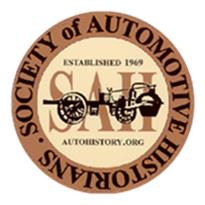 |
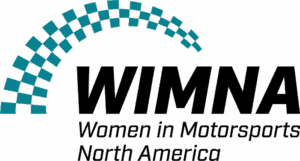 |
 |
 |
|||
LONG BEACH, Calif. (February 24, 2025) – Firestone returns as presenting sponsor of the expanded Road Racing Drivers Club annual legends dinner in Long Beach, California, on Thursday, April 10. The 2025 gala will celebrate the 50 years of racing on the streets of Long Beach, California, and will honor Mario Andretti, Al Unser Jr. and Brian Redman – legendary drivers from the Grand Prix’s rich history.
The “RRDC Celebration of 50 Years of the Grand Prix of Long Beach Presented by Firestone” is the RRDC’s 15th banquet honoring auto racing’s most influential leaders and iconic events. This is Firestone’s 14th year as presenting sponsor of the RRDC gala, and the brand has been affiliated with the Grand Prix of Long Beach for almost three decades.
The dinner and gala will be held at a new venue – the Westin Long Beach Hotel at 333 E. Ocean Blvd. – one day before the start of the 50th Anniversary Acura Grand Prix of Long Beach, the third race of the 2025 NTT INDYCAR SERIES.
All proceeds of the dinner will benefit The Mark Donohue Foundation, which supports the RRDC’s SAFEisFAST initiative, and the Grand Prix Foundation of Long Beach, which supports charities in the Long Beach area. The Foundation’s proceeds from the gala will go to Long Beach City College’s Automotive Technology Program.
Tickets may be purchased on the RRDC web site rrdc.org. All are welcome. This event is expected to sell out, so early reservations are recommended.
“Having Firestone support the RRDC Long Beach dinner for more than a decade is a true privilege,” said RRDC President Bobby Rahal. “This year’s gala is very special, as it celebrates the 50 years that racing has taken place annually on the streets of this great port city.
“Firestone has an unrivaled heritage in motorsports dating back to the first Indy 500® in 1911. We always welcome Firestone’s support, and salute the brand’s long-standing success and contributions to the sport.”
“Each year, the Road Racing Drivers Club event is a highlight of the Acura Grand Prix of Long Beach weekend,” said Grand Prix Association of Long Beach President & CEO Jim Michaelian. “And this year is especially meaningful as we join with the RRDC in honoring three true legends of the sport—Mario Andretti, Al Unser Jr., and Brian Redman. Their contributions to Long Beach motorsports history have inspired generations of drivers and fans alike, and we are thrilled to celebrate their incredible legacies during this special evening.”
In previous years, the RRDC has honored individual icons of the sport: Dan Gurney, Parnelli Jones, Roger Penske, Jim Hall, Brian Redman, Mario Andretti, Bobby Unser, George Follmer, Emerson Fittipaldi, Johnny Rutherford. David Hobbs, Rick Mears, Jacky Ickx and Sir Jackie Stewart. These RRDC galas are acknowledged as highlights of the auto-racing social calendar, drawing fans and luminaries from all forms of motorsports.
|
Mario Andretti won at Long Beach four times and is credited with establishing the race as a world-class event, winning the 1977 Formula 1 U.S. Grand Prix West and the 1984 race when the event switched to Indy cars. |
Al Unser Jr. is the winningest driver at Long Beach, with six victories (1988-91 and 1994-95) over a dominant eight-year span. |
Brian Redman won the inaugural Long Beach race in 1975, an SCCA/USAC Formula 5000 event, which set the stage for Formula 1 to race on the city streets for the next eight years. |
About Firestone Racing:
The Firestone brand has participated in world-class motorsports events for more than a century, and racing has played an integral role in building and shaping Firestone into the time-tested, iconic brand it is today. Harvey Firestone, the brand’s founder and a pioneer of sports marketing, was one of the first to use racing as the ultimate proving ground for his tires. Ever since Ray Harroun’s Firestone-equipped Marmon Wasp won the inaugural Indianapolis 500® in 1911, Firestone has worked to constantly evolve and advance race tire technology. Overall, Firestone tires have carried the winner of the Indy 500 to victory circle 75 times – more than double all other tire manufacturers combined. Firestone has served as INDYCAR’s sole tire supplier since 2000, and the brand’s on-track success translates to durable, dependable performance and uncompromising quality on the open road.
About the RRDC:
The Road Racing Drivers Club was formed in 1952 as a way to give champion drivers a say in their sport, particularly in the areas of safety, and has evolved to serve the future of road racing by mentoring new drivers on both amateur and professional levels. The Club’s membership includes leading industry professionals, race officials and motorsports journalists, in addition to prominent racing names.
In 2011, the RRDC launched a free on-line training seminar – www.SAFEisFAST.com – featuring RRDC members and other industry experts in high-quality videos covering subjects from physical and mental preparation to driving techniques, driver safety to car setup and sponsorship. The videos are updated regularly. Each week, a professional from the world of motor racing answers readers’ questions on the site in a feature called ‘Ask a Pro.’ Bobby Rahal is President, John Fergus is Vice President/Treasurer and John Clagett is Secretary. The RRDC presents three annual awards: the Phil Hill Award, the Mark Donohue Award, and the Bob Akin Award. Membership in the RRDC is by invitation only. Additional information on the organization may be found at www.rrdc.org.
About the Acura Grand Prix of Long Beach:
The Acura Grand Prix of Long Beach celebrates its 50th anniversary April 11-13, 2025, and is North America’s longest-running street race. Hosting more than 190,000 people over its three-day weekend, the Acura Grand Prix is second only to the Indianapolis 500 in popularity on the NTT INDYCAR SERIES calendar. Five additional racing series, including the IMSA WeatherTech SportsCar Championship, compete during the weekend which also includes a variety of off-the-track activities such as concerts, a Lifestyle Expo, an exotic car show and more. For more information, visit gplb.com.
About the Grand Prix Foundation of Long Beach:
The Grand Prix Foundation of Long Beach, since its inception in 1991, has donated more than $4.2 million to Southern California charities. In addition, the Foundation donates tickets and hospitality packages to the Acura Grand Prix of Long Beach and tickets to the Foundation’s “Grand Prix Charity Days” events to charitable and civic organizations to assist them in their fundraising efforts or, in some cases, to bring the physically or mentally challenged to a “day at the races.” For more information, visit gpflb.com.
Road Racing Drivers Club rrdc.org
Where horsepower meets heart, and speed knows no limits! We’re shifting into high gear for a special panel episode in honor of International Women’s Month!
From burning rubber on the track to breaking barriers in a male-dominated sport, today we celebrate the fearless women of drag racing. Joining us are Erica Enders, Ida Zetterstrom, Megan Meyer and Maddi Gordon … incredible drivers from around the world—pioneers, champions, and all-around speed demons who prove that racing isn’t just for the boys. So buckle up, because we’re diving into the thrill of competition, the challenges of the industry, and what it truly means to be a woman in the fast lane.
Note: All of our BEHIND THE SCENES (BTS) MPN episodes are raw and unedited, and expressly shared with the permission and consent of our guests.
We hope you enjoyed this presentation and look forward to more Center Conversations throughout the season. Be sure to follow, subscribe, and stay with us for more incredible discussions from the world of motorsports. Until next time, keep the wheels turning and the throttle wide open!
This Virtual Center Conversation was Sponsored by
 |
 |
 |
 |
 |
|||
Steve Zautke bridges both the oval world and the road world, which are coming closer and closer together. He is a native of Milwaukee, got involved with the Milwaukee Mile at a very young age. His father was a filmmaker and a fan and participated in the events there, organizing them and helping out. He is an author and published a book on Road America. He also participates in this Henry Miller Club News, and works for the SVRA magazine. He’s a wonderful writer and historian, and he’s also a devotee of Road America.
Highlights
- 00:00 Introduction and Speaker Introduction
- 02:11 Milwaukee Mile: The Oldest Racetrack
- 04:00 Early Races and Tragic Beginnings
- 06:51 The Golden Era of Racing
- 11:15 Midget Car Racing and Post-War Popularity
- 13:31 Iconic Drivers and Memorable Moments
- 20:10 AJ Foyt’s Pole Position and Race Highlights
- 21:18 The Marchese Brothers and Their Promotion Legacy
- 22:28 Ed ’20 Grand’ Steinbach: The Voice of Midwest Racing
- 23:08 Wisconsin Speedways Dinner and Racing Legends
- 24:13 The Rise of Stock Car Racing at Milwaukee Mile
- 25:22 Corporate Sponsorship and the Miller 200
- 27:00 USAC vs. NASCAR: The Evolution of Stock Car Racing
- 27:46 ASA’s Challenge and Dick Trickle’s Victory
- 28:20 NASCAR’s Arrival and Departure from Milwaukee
- 28:49 The Quarter Mile Dirt Track and Local Heroes
- 29:25 USAC’s Missed Opportunity with Marlboro Sponsorship
- 30:18 Memorable Moments and Racing Legends at Milwaukee
- 32:10 Rick Mears’ First Win and Penske’s Domination
- 34:53 The Decline and Revival of Milwaukee Mile
- 35:23 The Harry Miller Club and Vintage IndyCars
- 36:02 Milwaukee Mile Videos and Personal Stories
- 37:13 Closing Remarks and Acknowledgements
This episode is part of our HISTORY OF MOTORSPORTS SERIES and is sponsored in part by: The International Motor Racing Research Center (IMRRC), The Society of Automotive Historians (SAH), The Watkins Glen Area Chamber of Commerce, and the Argetsinger Family – and was recorded in front of a live studio audience.
Transcript
[00:00:00] Brake Fix’s History of Motorsports series is brought to you in part by the International Motor Racing Research Center, as well as the Society of Automotive Historians, the Watkins Glen Area Chamber of Commerce, and the Argettsinger family. My name is Glenda Gephardt. For those who don’t know me, I’m the director of the center and I’m going to kick off today’s center conversation gathering and at this time I’ll introduce J.
C. Argotsinger who will introduce our speaker. Thanks. Well thank you very much and thank you Glenda. Those of you who don’t know that’s Glenda Gephardt who’s been with the racing center even before it was formed at least 16 years ago and she’s the person who makes the trains run on time and we’re very grateful for everything she does.
We do have a wonderful speaker here today. He bridges both the oval world and the road world, which are coming closer and closer together. As you know, we’ve had a number of oval track presentations in recent years, and of [00:01:00] course we always have been identified with road racing, but we do cover all forms of racing in all parts of the country and around the world.
Well, our speaker today is an author. He has just published a new book on Road America, which I just received last night and stayed up late reading. He is a native of Milwaukee, got involved with the Milwaukee Mile at a very young age. His father was a filmmaker and a fan and participated in the events there, organizing them and helping out.
He had the same sort of influence that I had. My father infected me with this racing bug and all of you in the audience I know are racing fans. It’s something, once you’ve been bitten, you don’t get it out of your system. So, Steve Zotke has driven in with his wonderful wife, Susan, who was the historian for a while at the Milwaukee Mile.
He also participates in this Henry Miller Club News, and he also is doing work for the new SVRA magazine that has come out. He’s a wonderful writer and historian. He’s also a devotee of Road America. So, without [00:02:00] further ado, I’m going to introduce Steve Zotke.
Thank you, Glenda and JC, appreciate it. The topic today is the Milwaukee Mile. A lot of people have heard about it, obviously my favorite track, next to Road America. World’s oldest continuously operating racetrack. A lot of people say, well, I thought Indy was, or it was Milwaukee. The operative word is continuously.
Indiana Fairgrounds actually held a race a couple of months before, and that’s the One Mile Oval in Indianapolis, which is their state fairgrounds. And they held a race earlier in the year, however, they didn’t hold races regularly till after the war, so thus, Milwaukee is the oldest continuously operating racetrack and it’s more of a marketing thing.
Bill and I were just talking about some people, you know, Knoxville in Iowa has been holding races since 1901, so, nationally sanctioned, you can go round and round, it’s like anything, you change numbers around and pretty much debate something till all end. Originally, the state [00:03:00] fair rotated from the 1850s.
The state incorporated in 1848, and then they said, let’s have a state fair like all states do. And it rotated around Madison. Most state fairs are centered at the Capitol. But Milwaukee was such a big city at that time, it was in the top 15 up until the 1940s. And also because it was on Lake Michigan.
Many of the people in the state and the government thought Milwaukee would be a better place to showcase the state than Madison at that point, which was not as big as it is now and not as well known. It’s been an ongoing thing where they were moving it, it moved to Janesville. The Oshkosh, and a lot of people don’t realize, also in the early 1970s, there was talk of moving the fair from West Allis, which is a suburb of Milwaukee, to Madison once again.
And so much so, that the promoters at the time, the Marchese brothers, Carl and Tootie, were actually thinking and had looked at purchasing land in southern Wisconsin, and were in talks of building a 1. 5 Super [00:04:00] Speedway. The first race was held at Milwaukee weekend of September 1903. This is a photo of Barney Oldfield and Tom Cooper.
Those cars were owned by Henry Ford. One was called the 999, which is the more famous car, and the other one was called the Red Devil. Tom Cooper is somebody that kind of is forgotten in history. It’s kind of an amusing story. Not for Tom Cooper, though. Henry Ford was a very devout religious man, as was his wife.
Tom Cooper is kind of known of a carouser, and Henry Ford’s wife was hearing these stories about Tom Cooper and what type of a person he was off the racetrack, and she told Henry that maybe Tom Cooper needs to work somewhere else, so Tom Cooper is kind of lost to history. The first race was held, like I said, September 11th and 12th, 1903.
Unfortunately, the first fatality happened. That’s the Red Devil. That’s the other car. You see models of the Ford 999, and the 999 is in the Henry Ford Museum. Unfortunately, there was a crash and Frank Day lost his life in the North Turn. That’s located just at the, pretty much the apex of Turn 4 on September [00:05:00] 12, 1903.
It was his first race. He was from Columbus, Ohio, from a well to do family. Racing back then is not anywhere how it was today. Back then it was more barnstorming. What they would do is have match races. It was more of a spectacle. People would come out because the automobile was so new. And they would have one, two, three car races.
And they were only for maybe one or two laps around the fairgrounds. And unfortunately he got pitched. He got thrown into the ground causing head injuries. Arnie Oldfield was not at the track that day because he had received injuries earlier in the month. Frank Day was filling in for him. Al Krause was a long time historian at the Milwaukee Mile.
Spent many days with Al Krause. Guess you could call him my mentor. Was a neat fella and had been attending races at the fair park since the early 30s. Passed away about 10 years ago. Milwaukee Mall programs are pretty much known, especially from 1961 on, mainly because of Al. A lot of neat stuff, and they’re very highly collectible.
Tom Marchese would tell, uh, Al, when putting together the programs, he said, Al, I only want [00:06:00] you to put in enough for the people to look at a couple of the pages during talent downtimes or a caution flag. Don’t make the stories too involved. So he would have a lot of these photos in the program such as this one, where it says here’s Barney Oldfield in this peerless green dragon.
There’s a number of these cars built. This is actually a shot of Barney at the Dallas Fairgrounds in 1905. However, Barney did set a track record in this car at Milwaukee in 1905. Barney also drove a lot of pretty iconic cars back in the day, including this, the Blitzen Benz. He also drove a Duroc, which was a French built car, the peerless Green Dragon that we saw previously.
And then this is the Blitzen Benz that he drove at Milwaukee. And you can see there, there’s a different set of the fairgrounds. The stands look a little bit different from the classic that you would see in the 50s and 60s. These were actually lost in a fire in 1914. First 100 mile race wasn’t held at Milwaukee until 1915, so you had a lot of match racing.
So you can see if the automobile, maybe you’d see him [00:07:00] driving down a street at 20 some miles an hour. A lot of the roads were dirt back then. For if you were a kid in these stands and you saw these cars coming down at you at 65, 75 miles an hour. No mufflers on them. It was quite the spectacle to see these cars with the smell and everything.
It was quite incredible. Not much for pit safety back then. Just kind of lean out over and then take a look. That’s the famous Golden Submarine. That was one of the first race cars that was built by Harry Miller. Racing against Ralph De Palma. Oldfield actually won the race. One of the more iconic photos at Milwaukee in 1917.
A lot of people know G. I. Case as a tractor company. However, they’re very involved in racing. Before World War II. Now here we got a little shot of Louis Disbro in the Case Special. Finished 8th in 1913. There’s also a shot of the 1911 Indy 500 at the start. You see these race cars that have mouths on them?
Those are also G. I. Case race cars. And they were on the front row at Indianapolis in 1911. But J. I. Case has a very [00:08:00] significant race in history. In fact, a friend of mine was doing some research and he decided to go over to J. I. Case, which is still based out of Racine. And they still have quite the accumulation of memorabilia and research.
It’s still there located at company headquarters in Racine. In the 1920s, the mile kind of faded from the National View. The reason for that was because of the board tracks. Board tracks, you had Beverly Hills, Altoona, Kansas City. Those were these huge, beautiful speed palaces. So the fairgrounds were kind of forgotten.
You had dirt. dust and whatnot, people would rather go to a board track and see these beautiful 91 cubic inch millers and all the top drivers at a board track. So Milwaukee pretty much had more of the homegrown drivers were kind of the rural back then. If you were a fan back then, these are the guys you would see at the store driving down the street.
So there’s more of a personal connection with these guys because they lived in your hometown. There’s Carl Marchese, he was a driver, drove at Indianapolis in 1927 before he got hurt at [00:09:00] Springfield. Chet Barnacle, he later became an official. And then Tootie Marchese, Ted Rosten, Stagnowicki, Louis Frank, Romy Sherwinski.
That’s the Milwaukee way of saying that. And then Porter Short. And these were, uh, just guys that were, uh, quite the speed demons back in the day. Some of you heard the name Tony Wilman. Tony Wilman was from South Milwaukee, located right off the Lake Michigan. I think it was always said, who is the best driver?
You always said, I’m trying to remember who it was. It was more of a obscure driver in the thirties, but Al Krause, the officer, the historian that we spoke of about before Tony woman is the best driver ever. So if you’re able to talk to guys like Tony and Paul Russo, highly respected driver. Rex Mays Classic started in 1950.
Rex Mays was one of the more popular drivers prior to the war. And then during the war, he flew bombers and fighters, ferrying them from the United States to England. The 100 mile race at Milwaukee in 1948, that’s Duke Dismore on the track. The number one is Ted Horn. And then the car on the right, that’s Rex Mays’s car.
What we [00:10:00] don’t see is out of frame, Rex Mays is in the groove, waving to the drivers, the steer clear of Duke Dismore saving his life. Unfortunately, about a year and a half later at Delmore, California, Rex Mays was involved in a similar crash where he got thrown from the car. Unfortunately, he did not survive because he got hit by another car.
So in 1915, it was decided that the 100 mile race in June would be called the Rex Mays Classic. The State Fairgrounds wasn’t just for racing. Until it was a county stadium in Milwaukee, the Green Bay Packers would play four games in Milwaukee. To this day, it’s what they call the gold package when they move all the Green Bay games to Green Bay.
The reason for that, Green Bay obviously could not support a National Football League team back then. So what they did is they have four games in Milwaukee, and the 1939 World Championship was held at State Fair Park. The football field would be located towards the south turn, just behind where the pit area would be.
And in that game, the Packers won the championship 27 to [00:11:00] nothing. You can see the football field on the left hand side. And then also the quarter mile racetrack that they would have midget racing on. This would be pre war. They built this grandstand, was part of the WPA program back then. That’s when they built it and you can see only half of it is done at that point.
Midget car racing took the nation by storm after World War II. People in racing, I don’t think, can grasp how big midget racing was after World War II. Especially on the west coast, you hear stories like Gilmore Stadium and that. One of my favorite stories that was told to me was, uh, Sam Hanks was a very successful midget driver.
He would come to the bank because he had raced pretty much Thursday, Friday, Saturday, Sunday night and sometimes would win all the feature races. Well back then you literally got paid a cut of the gate. So he would have dollar bills and five dollar bills and coins shoved in every pocket and he would wear a sport coat.
So when he would go to the bank, he’d be pulling out dollar bills and putting them on the counter, dropping them, and the teller would be looking at him, What were you doing? Here’s a shot of Bob [00:12:00] Wilkie of Leader Card Racers. Before he started an IndyCar team, he was a distributor for Curtis Craft Midgets.
And that’s a Ray Richards who was a driver from Chicago, drove his car. That’s at Milwaukee. That’s about 1940. Guys should recognize that fella. It’s A. J. Foyt. He’s driving a Bob Hickman Midget at Milwaukee in 1957. And that’s the program cover. That was the final one. The final 100 mile race, USAC race, at Milwaukee for quite some time.
From the period of the late 40s up until 1961, that would be held usually the day before the IndyCar race. They got later into the late 50s, and unfortunately attendance was dipping less and less. Tom Marchese in 1961 says, if we don’t make money on it, this is going to be the final year. Unfortunately, on that Saturday, they only drew probably about 5, 000 people, and that wasn’t enough for them.
So, after 1961, they stopped. Having it. They did have a standalone race in 1965. It was sanctioned by Badger Midgets and Jiggers Roy, who some of you may remember, for almost winning the poll in 1969 and Indianapolis won that race. [00:13:00] Well, one thing I know a lot of people there, I just was somewhere last week and somebody was commenting about old photo.
Everybody’s wearing a tie in the sport called, this is one of my favorite shots too. Pretty much everybody has a hat tie and a sport coat on a dirt car race. This is before the, this is 1948 before the race was even paved. And this is a shot from, of the Dean Van Lyne car on Jimmy Bryan on the pole. And once again, full grandstands.
And in the back there, you see a little, almost looks like a big pizza hut. That was the Coliseum. During the winter, before World War II, they would hold indoor midget races in there. Very popular. Unfortunately, not well ventilated. I talked to a few gentlemen when I was a younger kid, and they said, by the end of the night, you were getting a little dizzy in there.
1952, here’s a shot, I mentioned this to J. C. earlier, we were talking about women not being allowed in the pit areas, and that’s S. Paoli and Chuck Stevenson. He won the championship and S. Paoli was the car owner but was not allowed in the pits at Indianapolis. Great answer to a trivia question, the track was paved in 1954, so he won the [00:14:00] last IndyCar race in 1953 on the dirt for J.
C. Agajanian and then 1954 won the first race for him when the track was paved. 1960, this was the June race at Milwaukee, there were almost 60 cars entered for 22 starting spots. So, on the pole there, that’s Jim Packard. Behind him was the winner of the 1960 Indy 500, Jim Rathman. Also in this race were Jimmy Bryan and Troy Ruttman, previous Indy 500 winners.
Future national champion Roger McCluskey was in this race. It’s just a who’s who of racing. And this was a 20 lap race that was held before the 100 lap race. And the top two went into the feature. And no, Rathman, Bryan, and Ruttman did not make it. This is the 1960 200 miler in August. Roger Ward, you see on the pole.
What’s interesting is that third car next to the 97. It’s an interesting story. That’s the Braun Plywood car. That was a brand new Eperle. Unfortunately, it came to Indianapolis too late and [00:15:00] did not make the race. That’s Parnelli Jones in that car. Qualified second. Everybody was like, who the heck is this kid from California?
A few weeks later, he was at the Indianapolis Motor Speedway doing a firestone test. Car was not handling right, didn’t feel right. So Tony Bettenhausen came over to the car, Tony Bettenhausen Sr., and Parnelli goes, this car isn’t, just doesn’t feel right. Tony gets into the car and comes in after two laps and said, I can’t believe this kid kept the car off the wall.
They made some adjustments and hit about 148 miles an hour. Tony went to his car owner, Lindsey Hopkins, at the time and said, Buy that car. If you buy that car, I can win the Indianapolis 500 next year. So, he was the fastest car then in 1961. Unfortunately, was test hopping a car for Paul Reuss and was killed.
People believe that Benton Housing could have won the 500 that year in 1961. In an indirect way, it was because of Pernelli Jones. Here we got a shot of Roger Ward winning a race in 1961 in the Sun City car. Roger Ward was Mr. Milwaukee Mile. He’s got the most wins for any IndyCar driver with [00:16:00] seven and won a variety of stock car races at the track too.
Loved the track. Roger, uh, I did an interview with him about 15 years ago. One of the first interviews I did, he said he was the first driver and it’s funny how so many echo the same thing after, was the driver’s track. He said, what I loved about Milwaukee is it was flat. And you could pick a line. If your car wasn’t handling, you could pick another line and maybe make the car handle.
And with Milwaukee, a driver could carry the car, especially in those days, more than you could at any other track. So Milwaukee, the kind of the cream of the crop, rose to the top. And Roger Waters certainly, when he teamed up with A. J. Watson and Bob Wilkie in 1959, that was the team to beat. Here’s another shot of Roger, that’s actually Lloyd Ruby, who didn’t have a ride that day, helping Roger get buckled in during practice.
And then J. C. Eggegenian with the cowboy hat. It’s amazing, there’s a photo, J. C. Osborks himself did a photo somehow. 1962, one of the more incredible races back in history, only because of Don [00:17:00] Davis. Don Davis was a driver from Phoenix and was driving a dirt car. Everything was working well for Don.
Qualified in the top 10, passed A. J. Foyt. A. J. Foyt was the Zen driver at that point. Won Indy in 61. Had problems in 62. Was the defending two time at that point national champion. Here comes Don Davis. Passes A. J. Foyt to lead. Incredible, and the crowd was going crazy. Here’s this guy in this Chevy powered dirt car, just taking it to the roadsters that day.
Don was literally dirt tracking it through the corners. Unfortunately, the right rear tire blew, and he spun. He already spun with AJ right behind him. AJ went to take the lead, but everybody was booing AJ. Because what they thought happened was AJ hit Don Davis. So he went to win the race, and you can see the expression on his face.
And the reason why he has this impression, because he’s being interviewed and the crowd is booing AJ, because they thought he booted Don Davis out of the race. Milwaukee is also known [00:18:00] for the first rear engine victory in IndyCar racing with the iconic Lotus cars with Jim Clark on the left and Dan Gurney on the right.
They qualified on the front row that day. Clark and then Gurney was second. People who might not know, how come Dan Gurney didn’t do as well as Jimmy Clark that day? The reason why was they only had one set of the correct carburetors. At that time they were running basically a stock block, fair lane block engine and they only had one set of the correct carbs.
So unfortunately Dan had to use another set of carburetors and he told me when he would go through the corners the car would bog and cough and then would pick up on the exit. So unfortunately he was running about a half a second behind Clark’s time but they were so far ahead of the roadsters that he was still able to qualify on the first row.
Eventually, Gurney finished third with AJ passing him. And this is the reason everybody loved Jimmy Clark. They asked Jimmy Clark why he didn’t lap AJ Foyt. He said, it’s one thing to beat a man, but you don’t want to rub it in his face. So that’s why he didn’t lap AJ [00:19:00] Foyt that day. Jim Hurtubise, 1964, is one of the most popular drivers at Milwaukee.
The 1964 Wrex Mays 100 was one of the more popular races just because A. J. Foyt and Roger Ward and Jim Hurtubise waged an epic battle, dicing back and forth and back and forth. Unfortunately, coming out of Turn 4, Roger Ward’s gearbox locked up. A. J. Foyt was able to avoid him, but unfortunately Hurtubise went over the right rear tire.
The car hit the wall, Hurtabees was knocked out of the car. Luckily for Hurtabees, it happened right in front of the pit area. Pit crewmen and firemen were able to pull him out and put the car out. He might not have survived if it was at any other place on the track. Foyt would go on to win the race.
Later that year, 1964, Mario Andretti made his first start in the 1964 Tony Bettenhausen, driving a lightweight Dean Van Lines Roadster. If you ever see A. J. and you don’t know what to say, just bring up the dirt track race at Milwaukee. He’ll start to smile. He’ll soften up. A. J. figures this is probably his greatest drive.
[00:20:00] 1965 in August, his Lotus IndyCar didn’t show up, and they had raced the previous Saturday at Springfield. Without the Lotus, A. J. said, well, let’s unload the dirt car, let’s see what we can do. And he went out to qualify, and Steve Stapp, who was a famous spring car builder and driver, was crewing for him that day.
He pulls in after qualifying. He asked Steve how you did. He goes, aj, I think you’re on the pole. AJ being AJ goes, you dumb. SOB, you can’t even use it. A stopwatch. And sure enough, AJ got on the pole, so AJ with a dirt car. There’s Dan Gurney in a Lotus Ford next to him. Went on to finish second. Fortunately, he had to make a a fuel stop later and Gordon Johncock went on to win the race.
If you ask aj, he’ll say, Lloyd Ruby won the race, but we don’t correct aj. AJ won the finish second, but many that day, it’s funny, it’s one of those things where there’s probably 35, 000 people, but if you survey, uh, racing fans in Wisconsin, about 100, 000 say they were at that race. 1954, when they repaved the racetrack, they commissioned a road course to be installed on the inside, and many [00:21:00] SECA national races were held at the Milwaukee Mile in the 50s into the mid 1970s.
If you ever talk to anybody who is involved in a professional level, especially with the racing, it’s not because of the money. It’s because of the people you meet in racing. There’s a lot of people that you meet. And I think any of us who’ve been involved in race can definitely feel the same way. The Marchese is that’s the Milwaukee pronunciation.
It’s actually Marchese. But people in Milwaukee say Marchese, and so instead of correcting them, they just went with Marchese. If any of you are Novi fans or fans of the Novi, the famous mechanic was Jean Marcenet, but when he got to Indy, he became Jean Marcenac. So it’s one of those. Tom Marchese on the left.
This is, uh, this, uh, This photo was taken about 1985 after he had retired from promoting, and that’s John Cation at the right, who took over for the Marcheses and partnered with them in 1968. How that started was racing, there’s a lot of unsavory people in racing in the 30s, and especially on the promotion side, and him and his brother Carl promoted a midget race at the [00:22:00] track in the late 1930s, and the fair board was so impressed how professionally they ran it, that they were businessmen.
They were involved in food wholesaling in Milwaukee. And they were so impressed on how they handled themselves and handled the operation that the Fair Board went to them and presented them exclusive promotion rights to the track. So from that point on up until 1968, they had the exclusive promotional rights at the track.
And then in 1968, they brought in John Cation to partner with them. They continued to promote at the track until 1983. Ed 20 Grand Steinbach. Not many people may recognize the name, but if you were, especially in the Midwest, in the 50s and 60s, you would recognize his voice. His full time job was race announcing, and he announced not only at Milwaukee, but he was from the Chicago area, and would announce Chicago area tracks, and also up at Road America.
Road Racing fans may have heard there’s a documentary made in the early 60s on the Scarabs, and 20 Grand is the one who’s narrating it. The August races were held during the fair. So, when there weren’t races, on those [00:23:00] other days, there were, a fair park acts would come through. So it wasn’t unusual for a lot of the acts to stick around for the race the next day and watch the races.
Wisconsin Speedways Dinner. And this was a dinner that they would have before the Rex Maze. The weekend before the Rex Mays race, right after Indy, and a lot of the big shots of racing would show up. In the upper left, we have Augie Papps, and then we have Mel Kenyon, Kelly Arbor from the NASCAR world.
That’s Bill Johnson. He was a local modified driver and drove midgets. And then we have Don White, was a USAC stock car driver from Keokuk, Iowa. Of course, we have super techs, AJ Foyt, Andy Granatelli. If you’re going to have a party, you’ve got to have Andy there. And then, of course, Tony Holman from the Indianapolis Motor Speedway.
1968, June 9th. Famous race, unfortunately, that was also the race that Ronnie Duman was killed at in 1968. Also the turban cars were there. Controversial to some people, but I actually brought racing to people. I brought it onto the sports pages. Lloyd Ruby that year, 1968, won both races. Won the June race in the 150 mile an hour and the Tibetan House in 200 [00:24:00] driving for Gene White.
That’s Bob Harkey in 1970 running next to Al Unzer in the 1970 Tony Bettenhausen 200. That’s the last dirt car to race in a national championship IndyCar race at Milwaukee. Stock car racing was huge at the Milwaukee Mile. This is a race from 1948. This is the first AAA sanctioned race that was held at Milwaukee.
And it was truly the number one racetrack for the North on the USAC and AAA side. Yes, they did race Edsels. That’s an Edsel on the left there. And that’s Don White in the number three Seiko Lube car. There’s a shot of Eddie Sachs and A. J. Foyt taken in 1962 or 63. What was populated with the USAC series.
You kind of see what’s happening now in the NASCAR Nationwide Series. In the USAC Series, you would have a lot of the IndyCar drivers race at the bigger races. Here you see Eddie Sachs and A. J. Foyt racing at USAC Stock Car, known for IndyCar racing. Because the IndyCar racers would race in the Stock Car Series, NASCAR really never cultivated [00:25:00] their base.
The Don Whites, the Butch Hartman, and those drivers. This is a shot of Norm Nelson, who was one of those drivers. This is strictly a stock car driver. There’s a shot of his transport rig. No tractor trailers in those days. And that’s how they used to go to the races back then. That’s a two car team. That’s a factory back, Plymouth back team.
That’s Jim Hurtubise’s car up on the top of the Norm’s car from 1965. 1968, the Miller 200. Many people think that this is actually the first corporate race sponsorship. In 1968, Miller, they sponsored a fire crew back in the day, and they had a lot of ties with the Milwaukee Mile. And they approached John Cation, who we saw with Tom Marchese.
About sponsoring the race and what that did, it added a large purse for a stock car race. This is probably, this was the largest race on the USAC stock car side at the time, kind of catapulted the race and Milwaukee into the national scene. So here is a program from 1971 and in order to receive the accessory awards, you had to run a large [00:26:00] Miller Hi Life sticker on your car.
And Armin Krieger, a lot of his shots are used in here. He’s in the National Spring Car Hall of Fame as a photographer shot from the late thirties up until 1993 was a family friend and was a neat guy. And as a good photographer, you see, he’s probably already got the shot of Larry Berwanger hitting the wall.
Now he’s checking to see what else is happening. The Milwaukee Mile held more races with the Dodge Daytona on the left and the Plymouth Superbird than any other. People may think Daytona, Talladega, NASCAR restricted the cars in 1971 by restricting their engine size. And then by 1972, they were outright banned.
However, USAC did not ban the cars and 12 races were held. at the Milwaukee mile for each year between 1970 and 1972. And late 60s and early 70s was probably one of the biggest attendance years for the Milwaukee mile so much so they even added auxiliary bleachers outside turn two. That’s Bobby Unzer’s in Nichols engineering Plymouth Superbird 1972.
This car held the track record at Milwaukee for [00:27:00] many years. Trouble on the horizon, 1970, the USAC series decided to bring in pony cars. You could run a small block pony car, such as a Chevrolet Camaro, with a smaller engine size, but with lighter weight, next to the Hemi’s that were being run like that one right there, with Paul Felder and a Dodge Magnum, which previously was a Dodge Charger.
USAC stock car series was, for a while was, you know, hand in hand with the NASCAR series. However, by the early 70s, the evolution slowed down on the USAC side. Whereas a NASCAR was continuing engineering, cars were getting faster and whatnot, it was more stagnant on the USAC side. Here’s a good example.
This is Dave Watson winning a race in 1977. That car started in 1972 as a Chevy Nova. All they did was just re skin it, put a new body, a Buick Skylark body, and he was winning races. In 1978, another racing series challenged USAC at Milwaukee Mile, and that was the American Speed Association. That’s Mark Martin as a 19 year old rookie.
These were lighter cars, faster cars in the USAC series too. More and [00:28:00] more drivers started to migrate from the USAC series to ASA. Here’s Dick Trickle after winning the Miller 200. ASA, with Rex Robbins as the head of it, was really good with promoting races, and he would try different things. Here’s a perfect example.
Who else would have Dick Trickle and Alan Kowicki taking a boxing match before a race? NASCAR came to the Milwaukee Medal for the first time in 1984. Here’s a shot of Alan Kowicki making his first NASCAR start at Milwaukee. The Grand National Series, as then it was called, was not the same Grand National Series you see today.
It was definitely a lesser series, and did not draw the crowds. Pfft. Stock car races faded away after 85, USAC did. NASCAR left it in 1984 and 1985, returned in 1993, ran at the track until 2009, and then moved to Road America in 2010. I mentioned it earlier, the Quarter Mile Dirt Track. You saw it in that one aerial shot.
That was the Quarter Mile Dirt Track. And on Thursday nights, they would race modifies at the track. And this was quite a popular [00:29:00] series that ran. Some people may have heard of Slinger. The Slinger Raceway in Wisconsin, they would run on Sunday nights, and then they would also run at Hale’s Corners, which also ran midgets, on Friday nights.
So, these were very popular for kids growing up, and a lot of the heroes to this day. Billy Englehart, who is, who drove Indy cars, that was his hero right there, the mouse. Miles Mouse Milius. Many people point at the split in 1970 and 1979 with USAC and CART and everything. 1971, USAC had a corporate sponsor, which was Marlboro.
You can almost take a look at this. This might have been an early shot over the bulk, so to speak, or misstep by USAC. 1971, Phillip Morris sponsored the whole series, put a lot of money into the series. The only caveat they wanted was they wanted to be the exclusive cigarette sponsor on the series.
Viceroy was also sponsoring the cars for Parnelli Jones. USAC didn’t want to offend or take that sponsorship away from Parnelli Jones, so they told Marlboro to walk basically. That same year, [00:30:00] Winston also started to sponsor NASCAR. NASCAR did not have an issue with telling other teams who had another sponsor.
You need to take a walk because he understood the growth that was possible with his corporate sponsorship sponsoring the whole series. Thus, after 1971, Barbara walked away from the sponsorship at USAC. A. J. Foyt, 1965, told you about how he finished second at Milwaukee in the dirt car. He also did the same thing in 1969, however, the cars were advancing that much more and did not have the success that he had in 1965, and I believe he finished ninth in that race.
1972, once again, there’s the viceroy car, Parnelli Jones, that was driven by Mario Andretti, the super team, there’s Joe Leonard also, Mark Donahue, after 1972 Indy 500 where he won, also, this was his only race at Milwaukee, at the 1972 Wrex Mays 150, people say Mark Donahue wasn’t an oval track driver, he did pretty well though, he finished second in his first and only race at Milwaukee.
1974, [00:31:00] Johnny Rutherford won his first race at Milwaukee driving the Team McLaren car. And that’s Roger McCluskey who is defending national championship running alongside. There’s Johnny in victory lane. And that’s Jack Baker, he was a local radio announcer who was also the track announcer for many years at Milwaukee.
Had the greatest leisure suits of anybody. There’s Super Tex. That’s A. J. Foyt in 1974. He won a race in 75 on his way to his sixth national championship in 75. And also won races in 1979. However, only won four races at Milwaukee. Only. And there’s Bobby Unzer in the Dan Gurney, Jorgensen Steel Eagle. Had the track record at Milwaukee for many years.
Not only in a stock car, but also an Indy car. Why a Tom Steeve in 1975 Indy 500 photo? As a young kid, after this race, they said Tom Steeve walked away and was not hurt. I was gonna kick out like, oh, he wasn’t really hurt. Well, he had to skip the next race at Milwaukee because he wasn’t hurt. In August of that year, he came to the track and I was walking down Pitt Road with my dad.
There’s Tom Sneva sitting on the wall. So we’re [00:32:00] talking to Tom Sneva and he pulls back his driver’s suit, takes off his watch, and you can see the flash burns there that he received in that crash. He wasn’t hurt, but he had a heck of a concussion. Rick Mears first race was at Milwaukee at the 1978 Wrex Mays 150.
Al Unser, who had won the Indy 500 the week before, ran out of gas with a few laps to go. Rick Mears, as a rookie, takes the lead, and out of turn three, he ran out of gas. Crossed the finish line at about 50 miles an hour, probably even less, with Johnny Rutherford fast approaching. But Rick was able to win his first race.
This is one of the most famous races, too, at Milwaukee. 1981 Wrex Mays Classic. That’s Mike Mosley and the Dan Gurney. John Ward designed Eagle. Chevy Stock Block. He was unable to qualify for the race. He blew an engine, and they had to replace the engine. Saturday afternoon, Saturday night, they got the car ready.
They put the car at the back of the pack, and he went to win the race. The man on the refueling rig, that’s Billy Vukovic, who had raced the previous week at Indy but did not have a ride. And [00:33:00] that’s Billy Vukovic refueling the car, and Stan Fox is changing the left front tire. I thought, that’s a heck of a pit crew to have.
He had two drivers in the Indy 500 the previous week, and they’re working on a pit crew. Rocket Rick. There’s Rick Mears after winning the race in 1990. Newman House Racing. Seven wins between 1985 and 2006, including five out of six wins between 91 and 96 with a variety of drivers. There’s a famous shot.
There’s a reason why I love this shot. That’s the victory podium. Of course, Michael won the race. John Andretti finished second. And there’s Mario in third. Mario’s a competitor. Mario wants to be in that top podium. You can tell in that shot right there. No family pride at that moment. That came later.
Nigel Mania, 1993. That year was my first year professionally working at Milwaukee as a videographer. And that was true Nigel Mania. Basically, they told me, just take photos, get video of Nigel. And it was a true zoo. Wherever he walked, there was a person. Crowd of people, they actually had to put two state troopers on them for the weekend.
The media crush was that big. 1992 [00:34:00] Formula One champion. He wasn’t able to come to contract terms with Williams and was able to come over to the United States, drive for Newman Haas, dominated this guy. Never drove an oval race before. Almost killed himself at Phoenix. Learned a valuable lesson there by not taking them too seriously.
Learned, okay, you got to take these things seriously. And from that point on, just really took to the ovals. And, uh, one at Milwaukee, as well as Loudoun, and just dominated the year. Speaking of domination, Penske domination. Of course, everybody remembers in 1994, the Mercedes that dominated the race at Indianapolis with Allenser winning.
The following week, they went to Milwaukee. With the normal engine that they were using on the cart series at that point. However, Penske dominated the race with Allens are winning the race. All Tracy and Emerson filled up all day filling out the podium as a light rain. You can tell it’s wet there and it just started to rain with five laps of race and it called the race.
The Milwaukee Mile today, it’s sad, but I still get people who come up to me and go, what’s [00:35:00] happening at the mile? And I say, well, they, they still run an IndyCar race there. The eyes on, you know, IndyCar series runs there and there’s a late model race that runs there. And then of course we have that Harry Miller meet, but the IndyCars, the attendance kept growing every year in the last few years since Michael Andretti’s group has taken over the race in 2011.
So it’s growing. This year, Will Power won the race for Penske and went on to win the national championship. If you get a chance, if you’re in the Midwest in July, the Harry Miller Club vintage IndyCar event is held. Usually it’s the week after the 4th of July. That’s the easiest way to remember. And we have anywhere between 50 and 60 vintage IndyCars from pretty much 1911 all the way up to 1965.
It’s all front engine Miller race cars. That’s the primary focus dedicated to Harry Miller, who his car is dominated in the IndyCars in the 1920s and developed the four cylinder Miller engine, which became the Offenhauser engine, which was used in IndyCar race up until late seventies, and it was started by Dave Eline, Chuck Davis, and Bob Sutherland.
Those three collectors and still [00:36:00] runs today. And this year we had our 20th anniversary. Milwaukee Mount videos. The shots of that, my father Bill, unfortunately he was passed, but shot movies for the Marcheses. And how that came about is, my dad was shooting video and there was an accident and a fella came up to him and said, are you shooting for anybody?
And it was Mike Billings, who was the number two guy in the fire crew. He goes, no. And he says, I’ll tell you what, why don’t you shoot videos or shoot movies of the cars and that, but also make sure when you shoot the, shoot us doing the cleanup on it. And they used it as training films. The safety crew at Milwaukee had a very good record for the track.
And nobody could get to the scene quicker than the Milwaukee mile guys. And they were very proud of that for many years. So I got those videos are available, both stock car and the IndyCar one.
Thanks to your brother guiding me. Who did one on Watkins Glen, along with Bill Green. I did one on Road America. It’s funny, you know, the Milwaukee Mile guy doing a book on Road America, but that is my second [00:37:00] home. I truly love the racetrack and everything that’s involved around it too. It’s, it’s been a love affair and they say you can’t serve two lovers, but with the Milwaukee Mile Road America, we’re very blessed in Wisconsin to have two such high quality racetracks.
Thank you very much. I appreciate it.
Well, Steve, thank you. I think they would have kept me here all afternoon. Your depth of knowledge is just incredible. This man hides his light under a bushel. As the evening went on and the afternoon went on, we realized the depth and the variety of racing that Steve is very knowledgeable on, and we are thrilled that you came here to Watkins Glen, and we’re going to make you a Watkins Glen Honorary Citizen.
Thank you. So not only Milwaukee and Elkhart Lake, but Watkins Glen. Steve will be available for more questions and sign his book if you would like to buy one of his books and we can converse over in the center further. No, if you guys have any questions, feel free to bend my ear and then I got the videos too.
Videos are a labor of love for me and they cover the both the stock cars and the Indy [00:38:00] cars. I got 20 years of Indy car footage on there and then the stock cars is a variety of stock car videos too. Thanks again. Thank you. Appreciate it. Thanks guys.
This episode is brought to you in part by the International Motor Racing Research Center. Its charter is to collect, share, and preserve the history of motorsports, spanning continents, eras, and race series. The center’s collection embodies the speed, drama, and camaraderie of amateur and professional motor racing throughout the world.
The Center welcomes serious researchers and casual fans alike to share stories of race drivers, race series, and race cars captured on their shelves and walls and brought to life through a regular calendar of public lectures and special events. To learn more about the Center, visit www. racingarchives.
org. This episode is also brought to you by the Society of Automotive Historians. They encourage research into any aspect of automotive history. The SAH actively supports the compilation and preservation of papers. [00:39:00] organizational records, print ephemera, and images to safeguard, as well as to broaden and deepen the understanding of motorized, wheeled land transportation through the modern age and into the future.
For more information about the SAH, visit www. autohistory. org
We hope you enjoyed another awesome episode of Brake Fix Podcast brought to you by Grand Touring Motorsports. If you’d like to be a guest on the show or get involved, be sure to follow us on all social media platforms at GrandTouringMotorsports. And if you’d like to learn more about the content of this episode, be sure to check out the follow on article at GTMotorsports.
org. We remain a commercial free and no annual fees organization through our sponsors, but also through the generous support of our fans, families, and friends through Patreon. For as little as 2. 50 a month, you can get access to more behind the scenes action, additional Pit Stop minisodes, and [00:40:00] other VIP goodies, as well as keeping our team of creators Fed on their strict diet of fig Newtons, gummy bears, and monster.
So consider signing up for Patreon today at www. patreon. com forward slash GT motorsports, and remember without you, none of this would be possible.
Unedited Video Version

This presentation examines the unanticipated outcomes of government regulations, mainly focusing on tobacco and alcohol regulations and their profound impact on the motorsports industry. Originally instituted to mitigate the promotion and distribution of harmful substances, these regulations inadvertently fostered a new era of sponsorship and revenue streams for motorsports. By analyzing historical context, regulatory changes, and the strategic adaptations of motorsports organizations, we uncover how these laws fundamentally transformed the economic landscape of the sport.
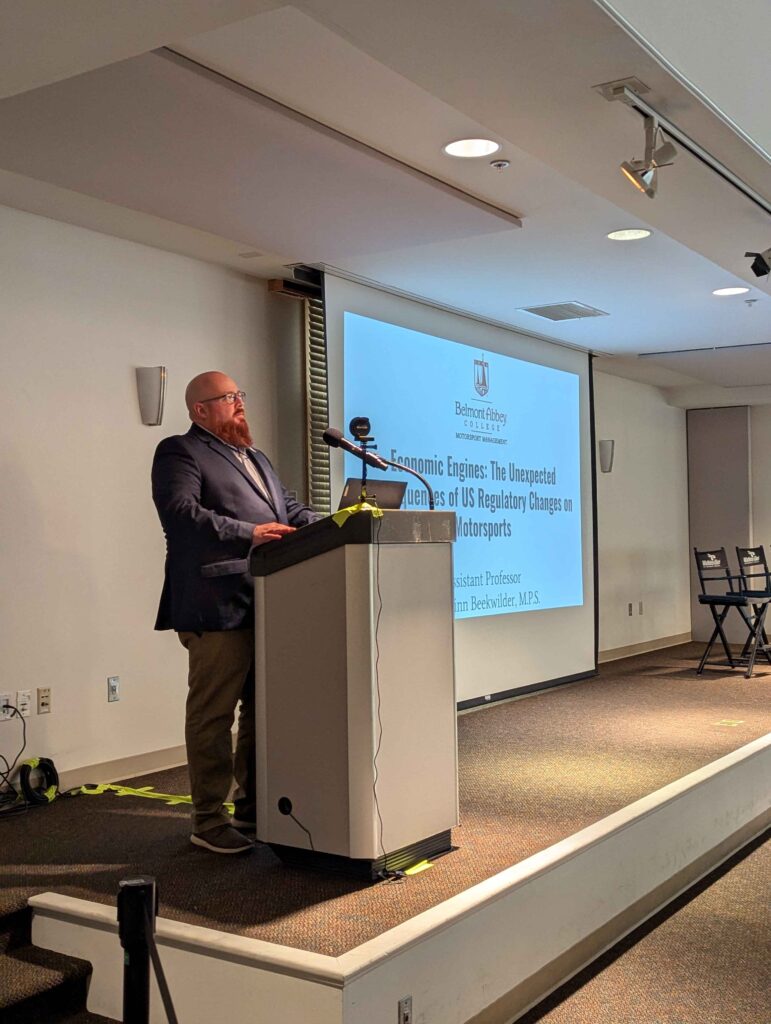
Quinn Beekwilder speaking at the 8th Annual Argetsinger Symposium on Motorsports History at Watkins Glen
In the early 20th century, Prohibition in the United States catalyzed the rise of stock car racing, as bootleggers modified their vehicles to evade law enforcement. This phenomenon laid the groundwork for the widespread popularity of motorsports in the U.S. Subsequently, tobacco companies leveraged the sport’s high visibility to advertise their products, providing substantial financial support for racing teams and events. The 1970 Public Health Cigarette Smoking Act, which banned tobacco advertising on television, aimed to protect public health but inadvertently led to a sponsorship windfall for NASCAR, resulting in the creation of the Winston Cup Series and the Camel GT series, further entrenching tobacco’s financial influence in motorsports.
By examining these developments, this presentation looks at the interplay between public health policy and commercial interests, understanding how government regulations designed to protect public health can have far-reaching and sometimes unforeseen effects on industries like motorsports.
This episode is sponsored in part by: The International Motor Racing Research Center (IMRRC), The Society of Automotive Historians (SAH), The Watkins Glen Area Chamber of Commerce, and the Argetsinger Family – and was recorded in front of a live studio audience. And has been Edited, Remastered and Produced in partnership with the Motoring Podcast Network.
Bio
Quinn Beekwilder is the Assistant Professor and Coordinator of the Motorsport Management degree at Belmont Abbey College. With a decade of experience at Charlotte Motor Speedway and as one of the program’s first graduates, he brings invaluable industry insights and addresses student concerns effectively.
Mr. Beekwilder’s passion for motorsport history drives him to design courses that highlight the historical development and societal impact of motorsports. His innovative approach includes experiential activities that blend theoretical knowledge with practical experience.
Slides
Swipe left or right (or use the arrows/dots) to navigate through the presentation slides as you follow along with the episode.
Other episodes you might enjoy
It’s nearly International Women’s Month, and we couldn’t think of a better way to honor it than by bringing together four phenomenal female drivers who are tearing up the track and rewriting the rules. From late models to sprint cars, these women have proven that racing isn’t just a man’s game—it’s anyone’s game if you’ve got the grit, the guts, and the drive to win!
We’ll talk with Erin (Crocker) Evernham, Alison Sload, Kaylee Bryson and Taylor Ferns about their journeys, the challenges they’ve faced, and how the sport is evolving for the next generation of female racers. So buckle up, because this conversation is going to be fast, fierce, and full of insight from the best in the business!
Note: All of our BEHIND THE SCENES (BTS) MPN episodes are raw and unedited, and expressly shared with the permission and consent of our guests.
We hope you enjoyed this presentation and look forward to more Center Conversations throughout the season. Be sure to follow, subscribe, and stay with us for more incredible discussions from the world of motorsports. Until next time, keep the wheels turning and the throttle wide open!
This Virtual Center Conversation was Sponsored by
 |
 |
 |
 |
 |
|||
Shortly after the NASCAR Hall of Fame Class of 2025 nominees were announced, two-time Daytona 500 winner and NASCAR Hall of Famer Dale Earnhardt Jr. posted, “Ray Elder won six NASCAR Western series championships: 1969, 70, 71, 72, 74, and 75. Elder would compete with the NASCAR Cup regulars when they ran at Riverside and beat them in 1971 and again in 1972.” Yet Ray Elder was not one of the nominees.
Throughout the 1960s and 70s, the Elder family raced and grew alfalfa, beans, and cotton at their farm in tiny Caruthers, California. With Ray at the wheel, older brother Richard atop the pit box, and father Fred handling ownership, “The Racing Farmers” dominated the competitive NASCAR Winston West Series for years. They also held their own when NASCAR Cup Series regulars visited Riverside.
Elder finished in the top five on eight occasions from 1971-1976, claiming two victories. Elder—and fellow Winston West competitors such as Hershel McGriff, Dick Bown, Jimmy Insolo, and Jack McCoy—helped facilitate the growth and development of NASCAR west of the Rocky Mountains. It wasn’t too long after the Racing Farmers returned to the fields that a new crop of west coast stars began to compete full-time (and win championships) at the national level in the NASCAR Cup Series.
This episode is sponsored in part by: The International Motor Racing Research Center (IMRRC), The Society of Automotive Historians (SAH), The Watkins Glen Area Chamber of Commerce, and the Argetsinger Family – and was recorded in front of a live studio audience. And has been Edited, Remastered and Produced in partnership with the Motoring Podcast Network.
Bio
Daniel J. Simone earned his Ph.D. in American History from the University of Florida in 2009, where he wrote his dissertation: “Racing, Region, and the Environment: A History of American Motorsports.” From 2010-2015, Dr. Simone taught World History and Environmental History at Monmouth (NJ) University. In 2016, he was hired as Curator of the NASCAR Hall of Fame in Charlotte, North Carolina, and held that position through 2021. The following year, Dr. Simone was tabbed to assist the New-York Historical Society Museum & Library, where he co-processed the Women’s Sports Foundation Collection and developed content for digital exhibition. Dr. Simone is on the editorial board of the Journal of Motorsport Culture & History and serves on the Indianapolis Motor Speedway Hall of Fame Voting Committee.
Slides
Swipe left or right (or use the arrows/dots) to navigate through the presentation slides as you follow along with the episode.


